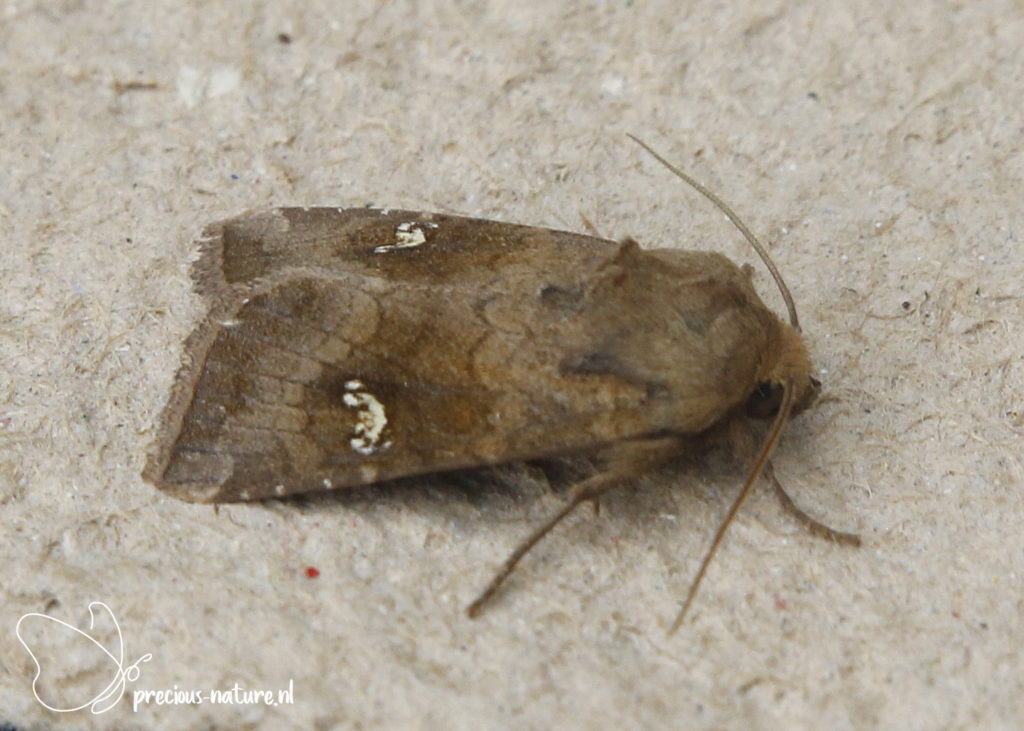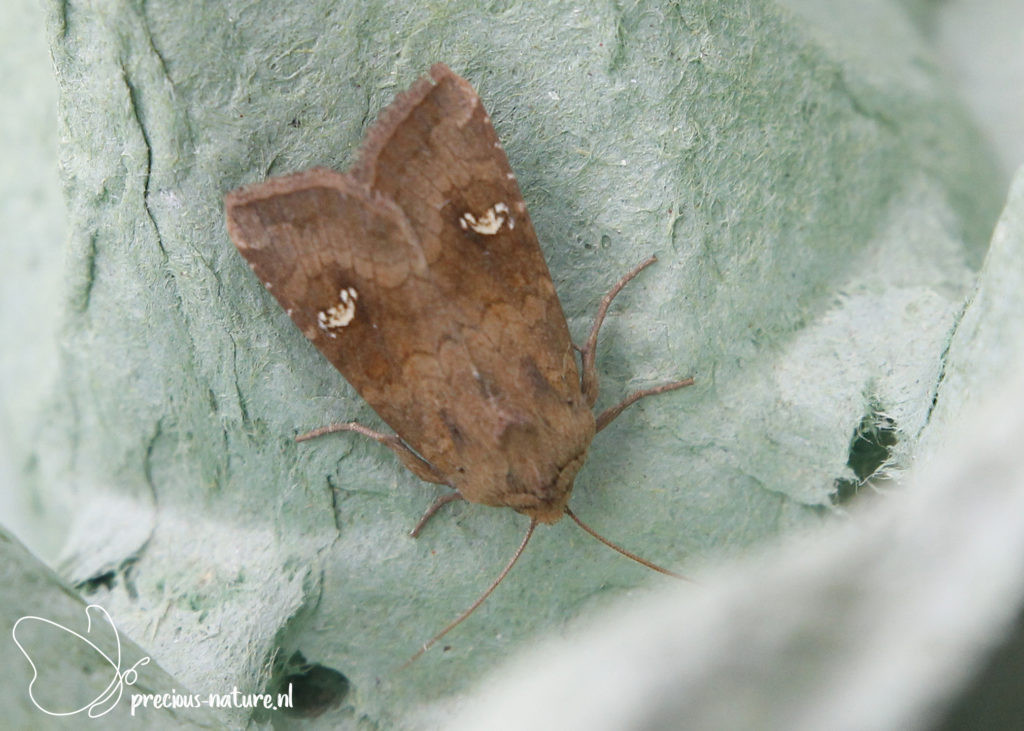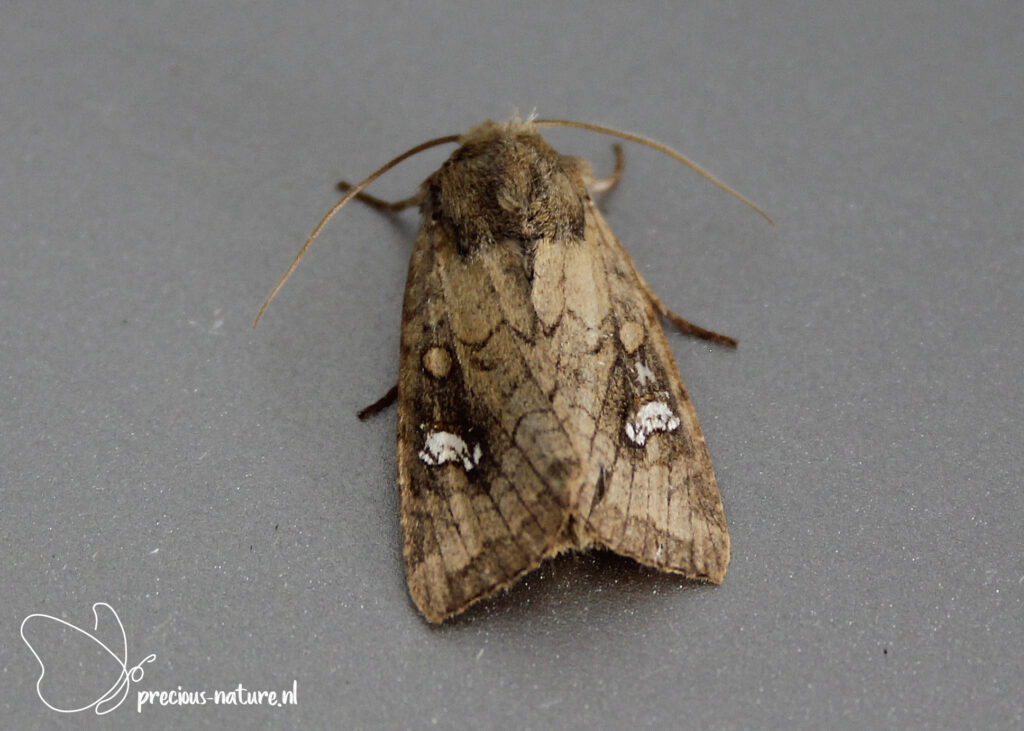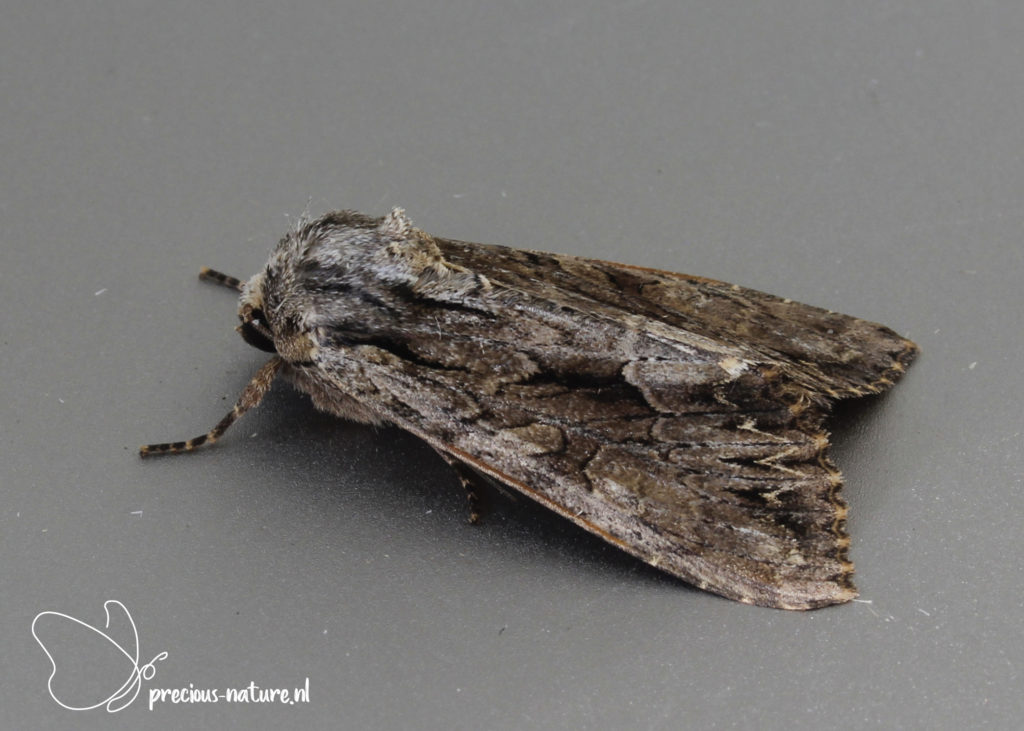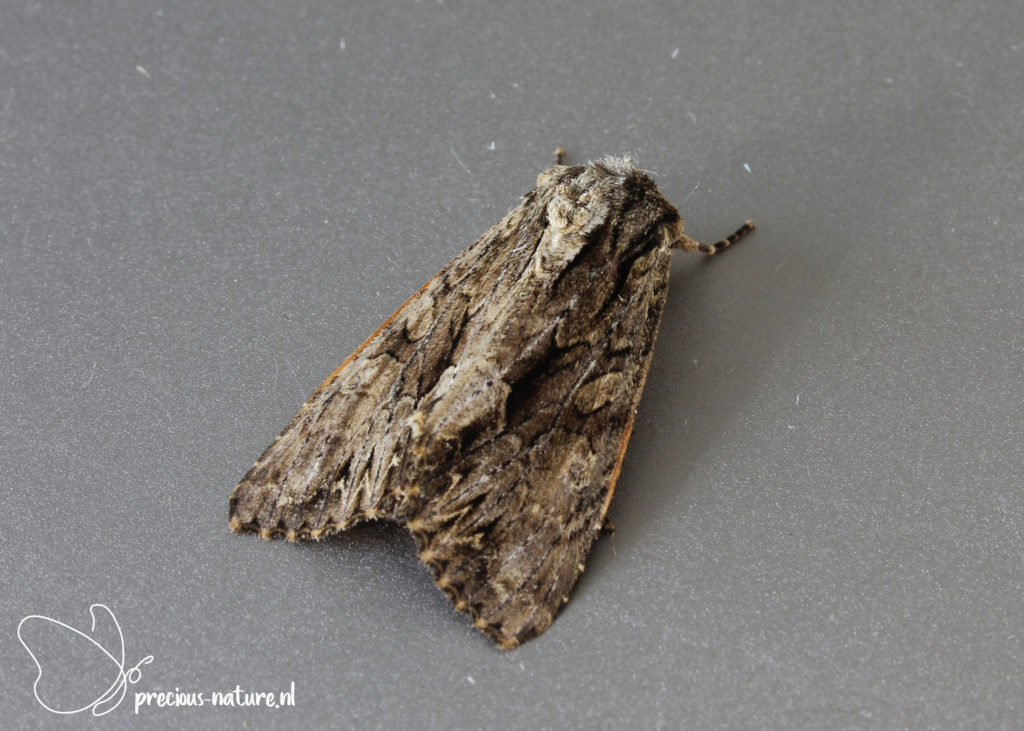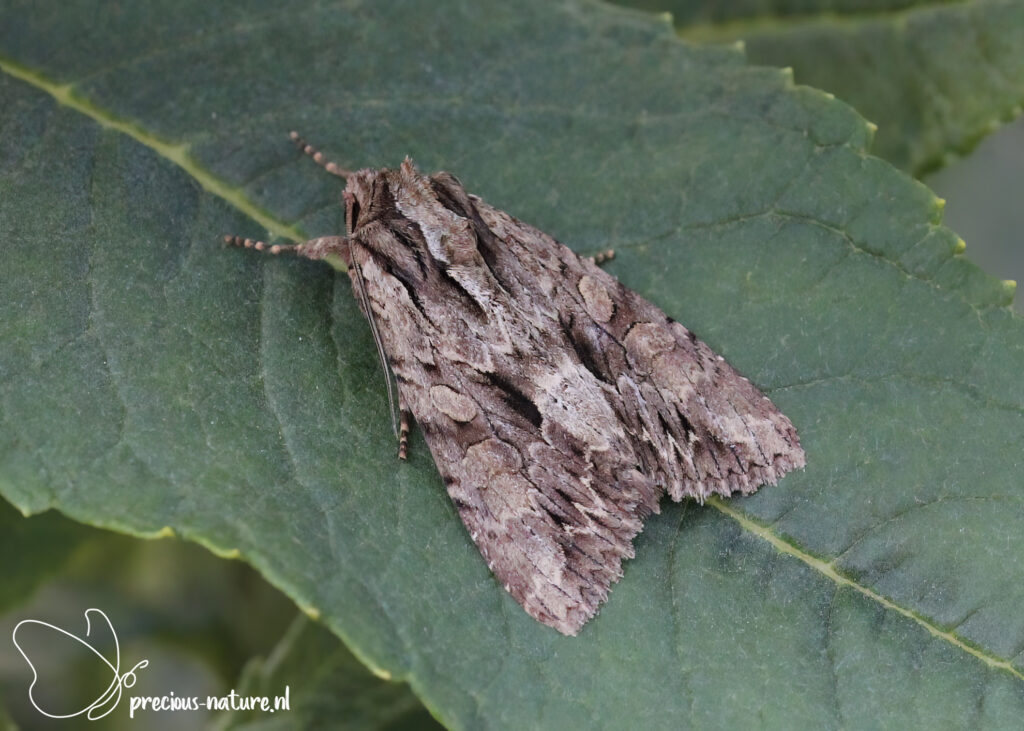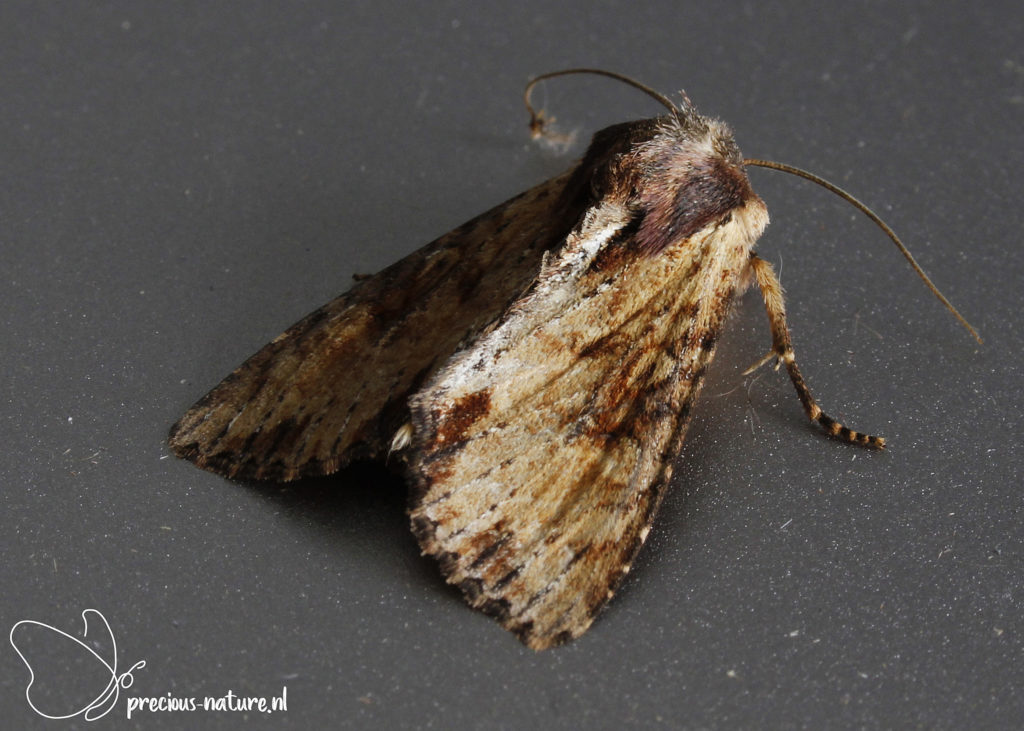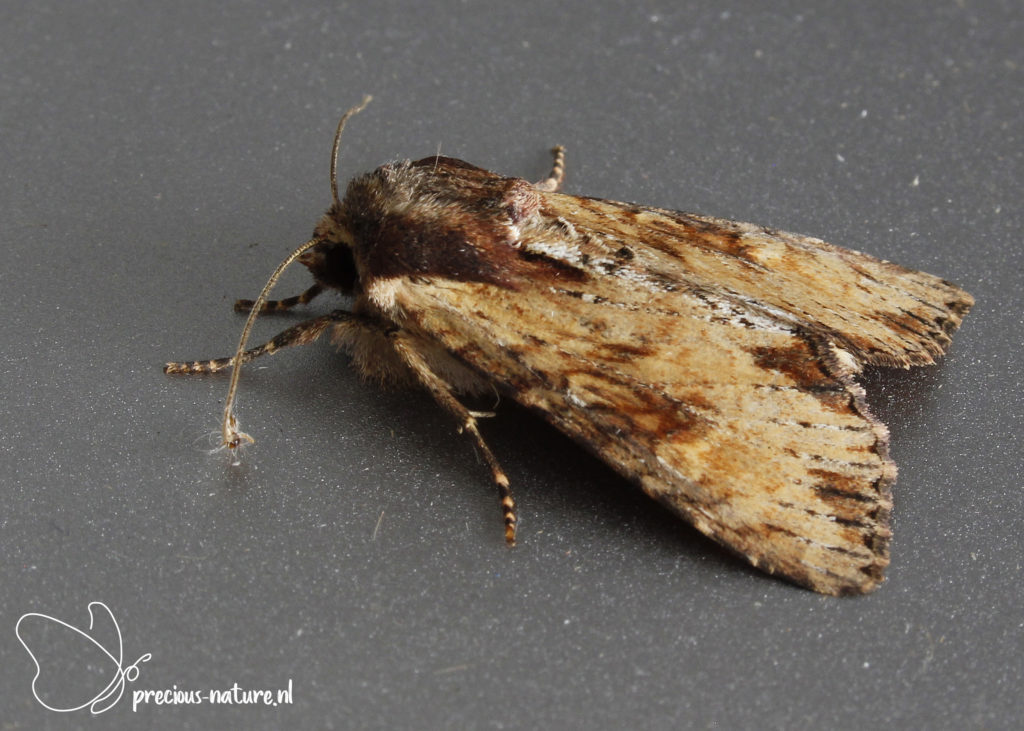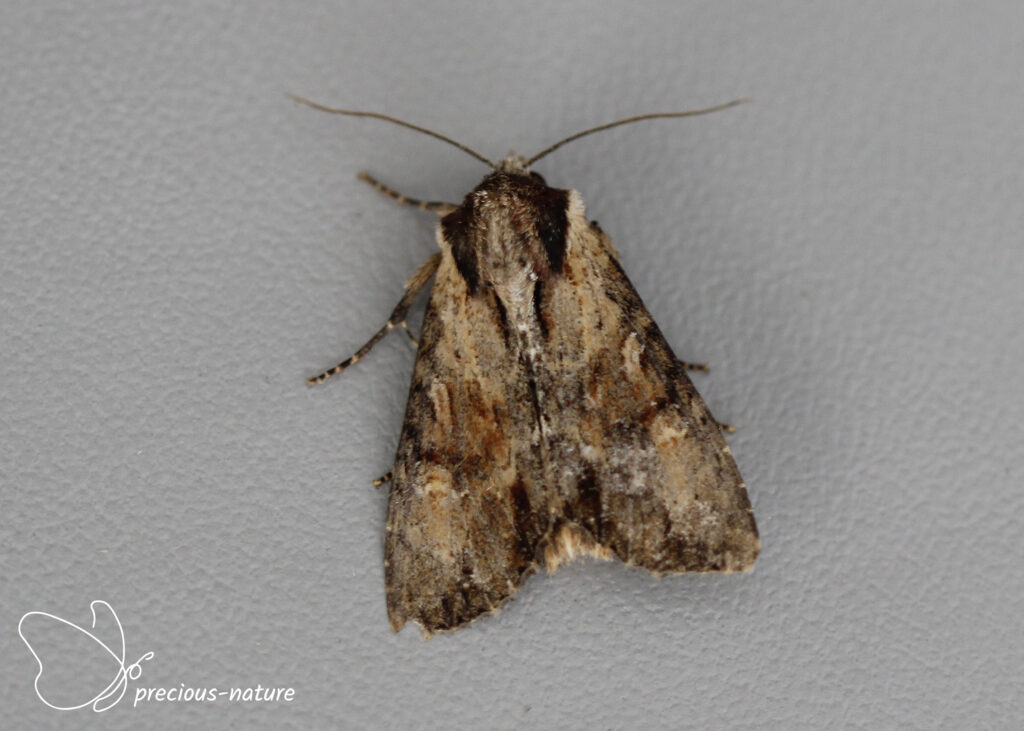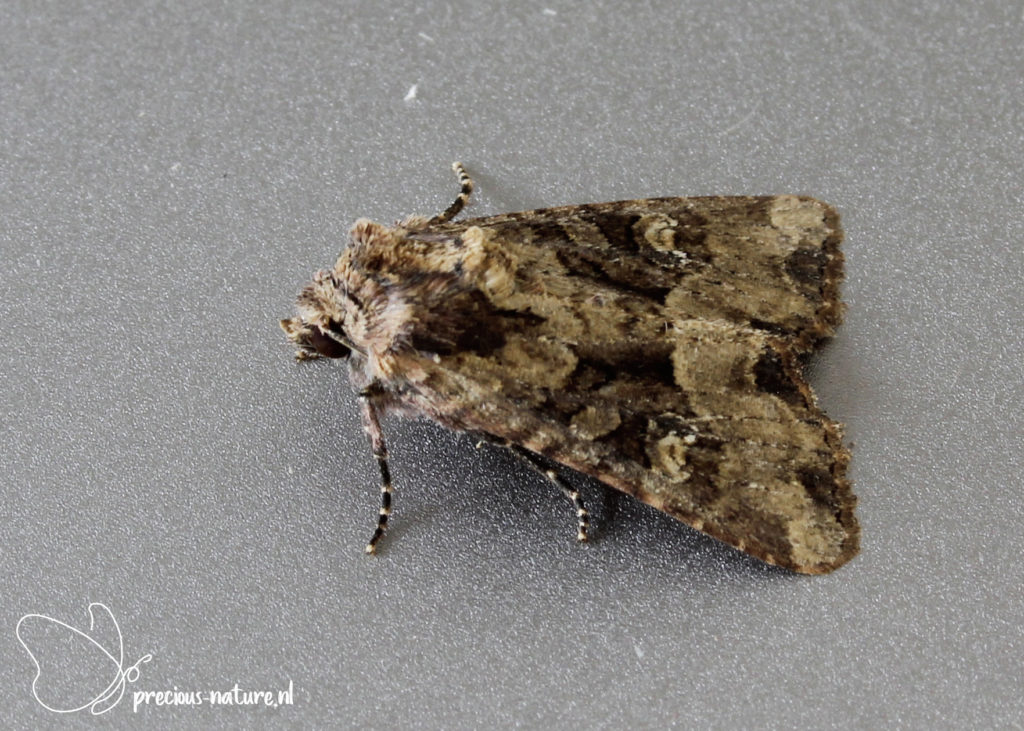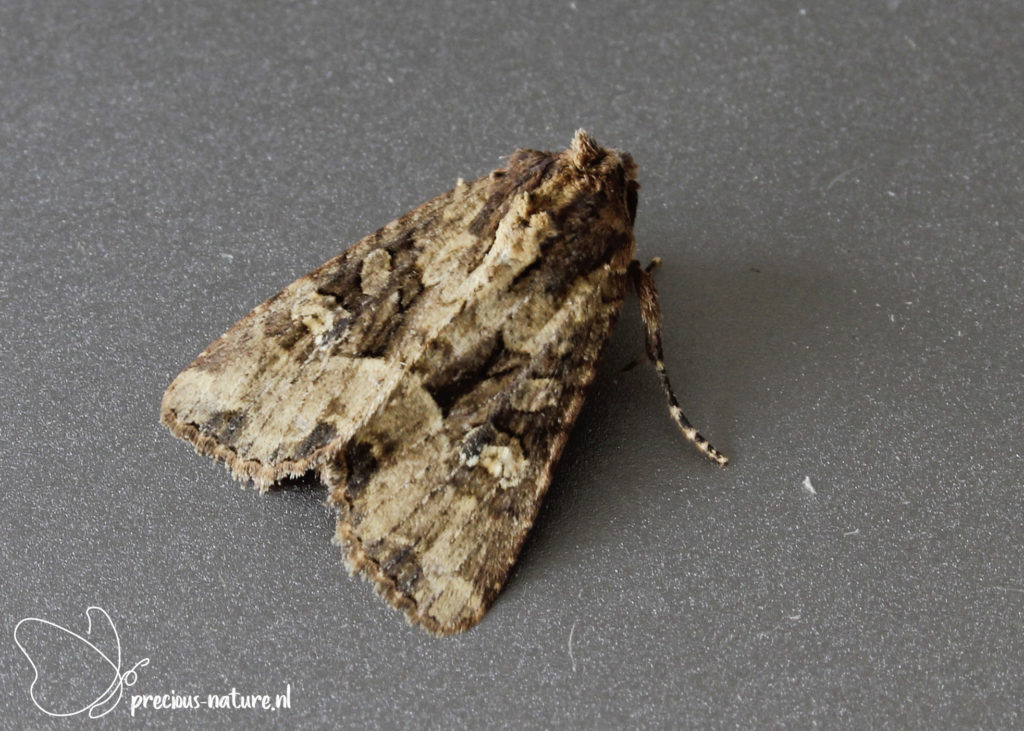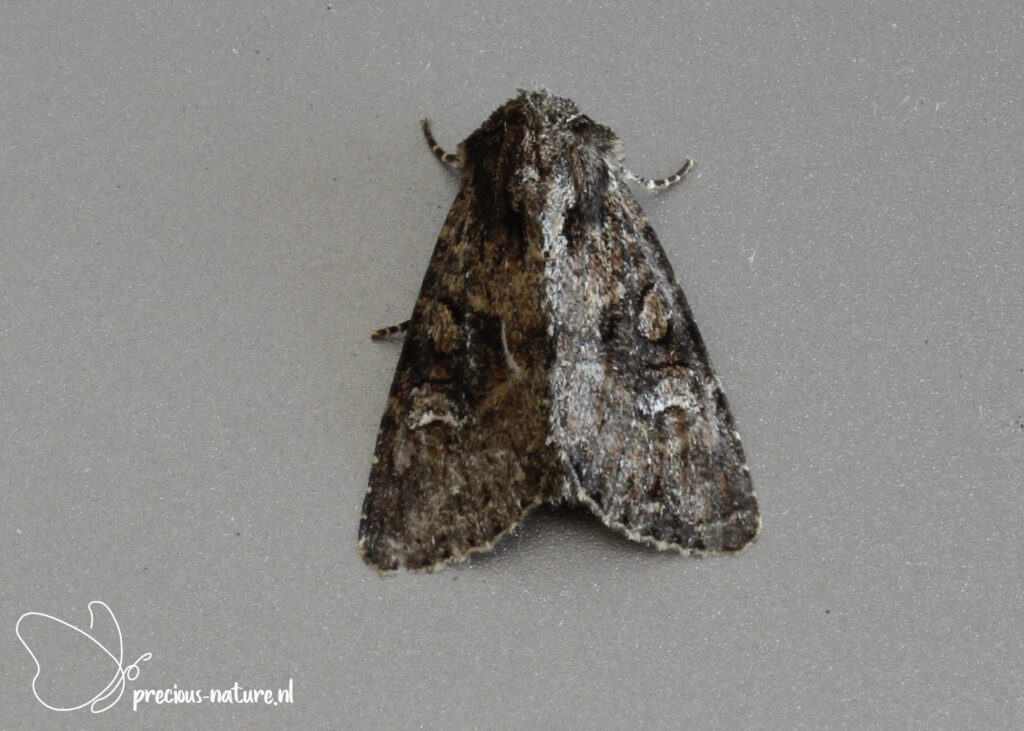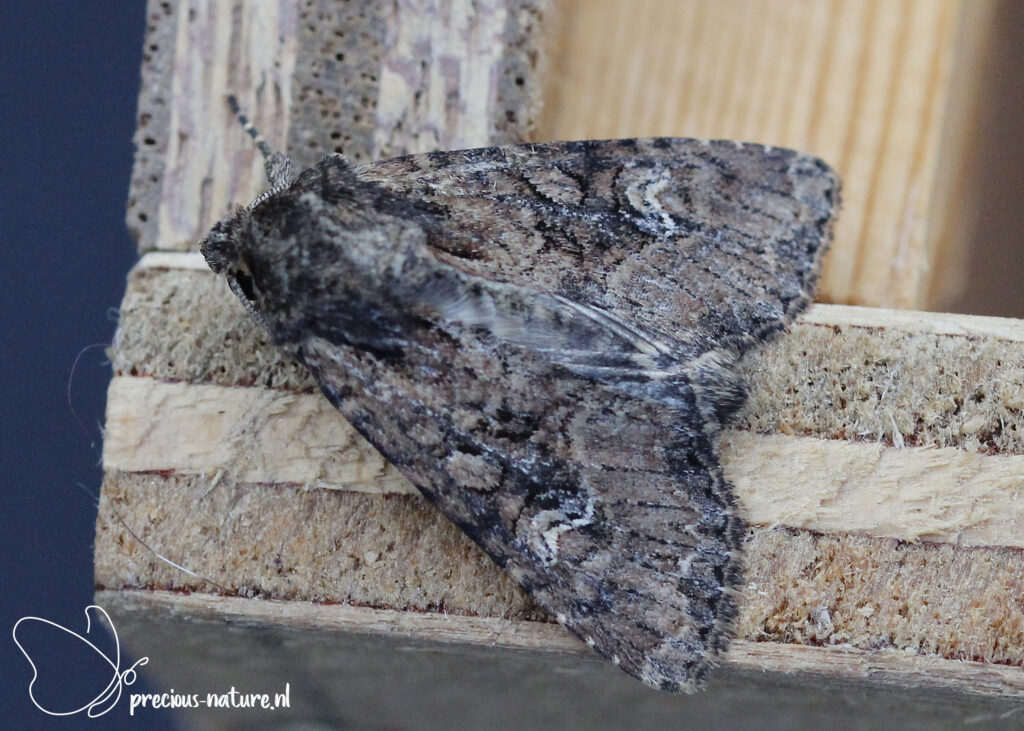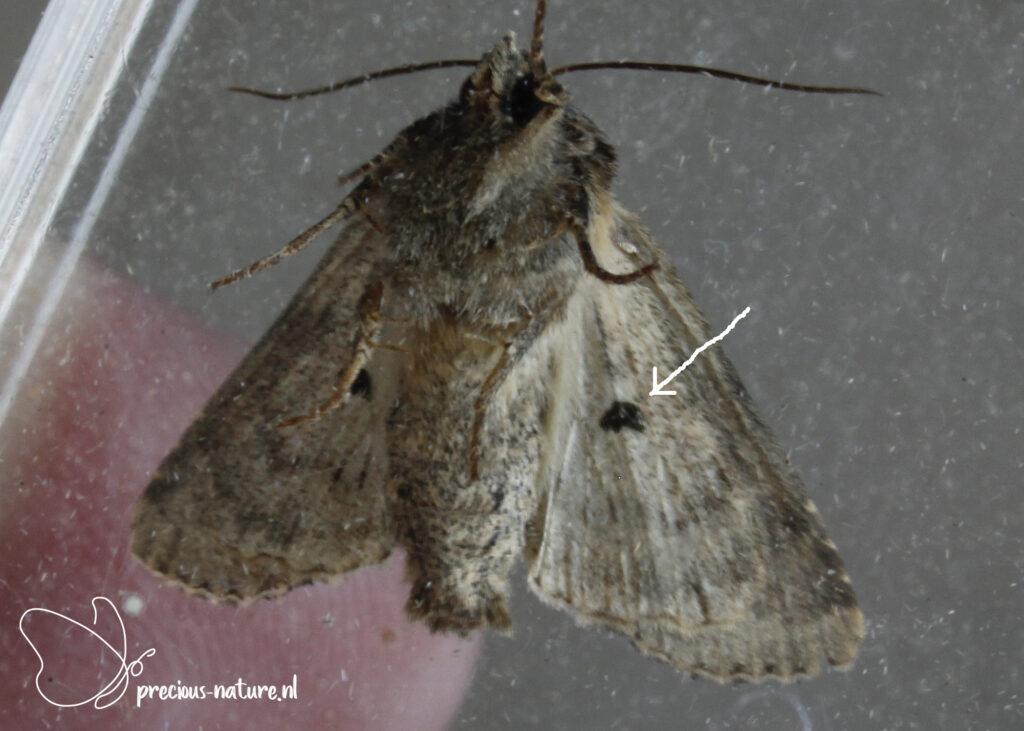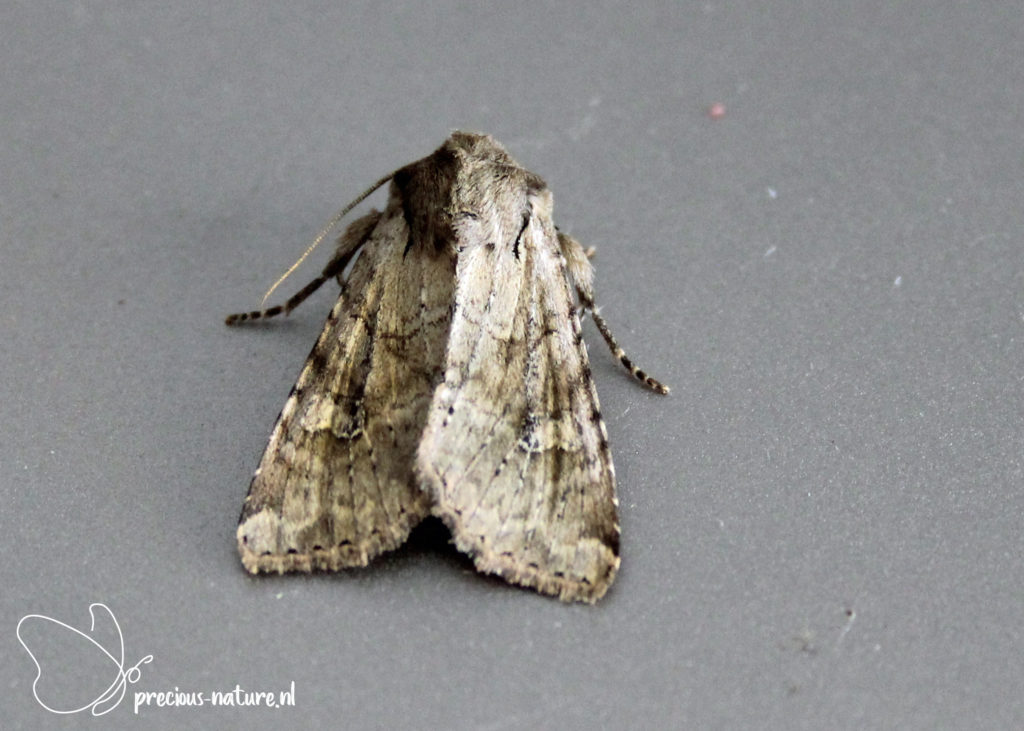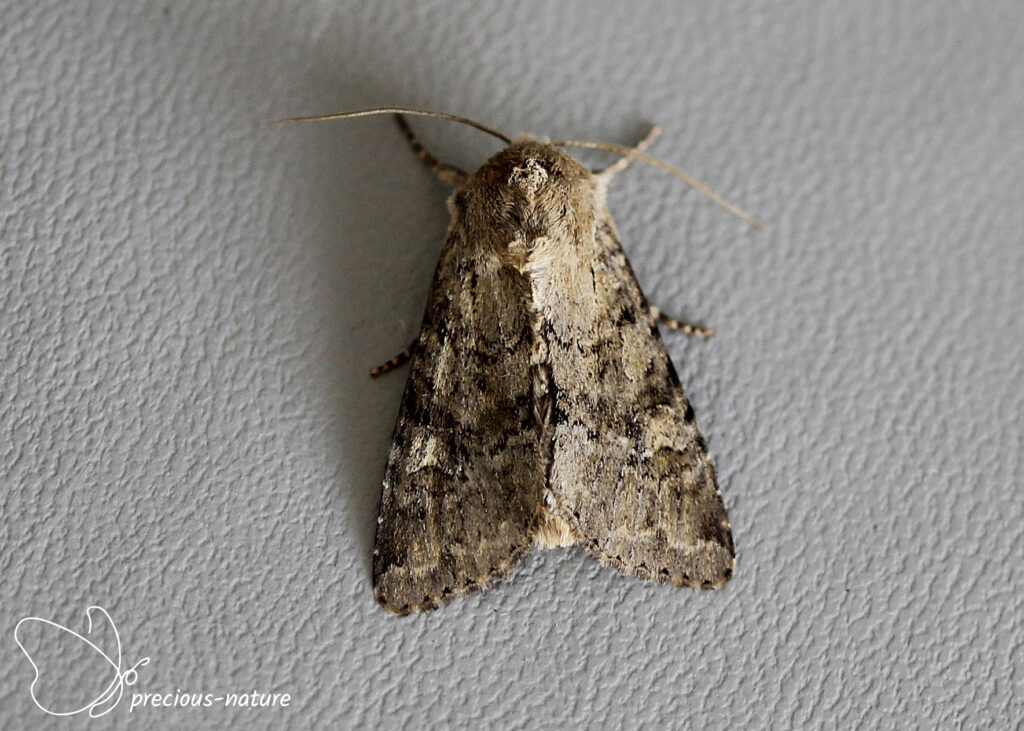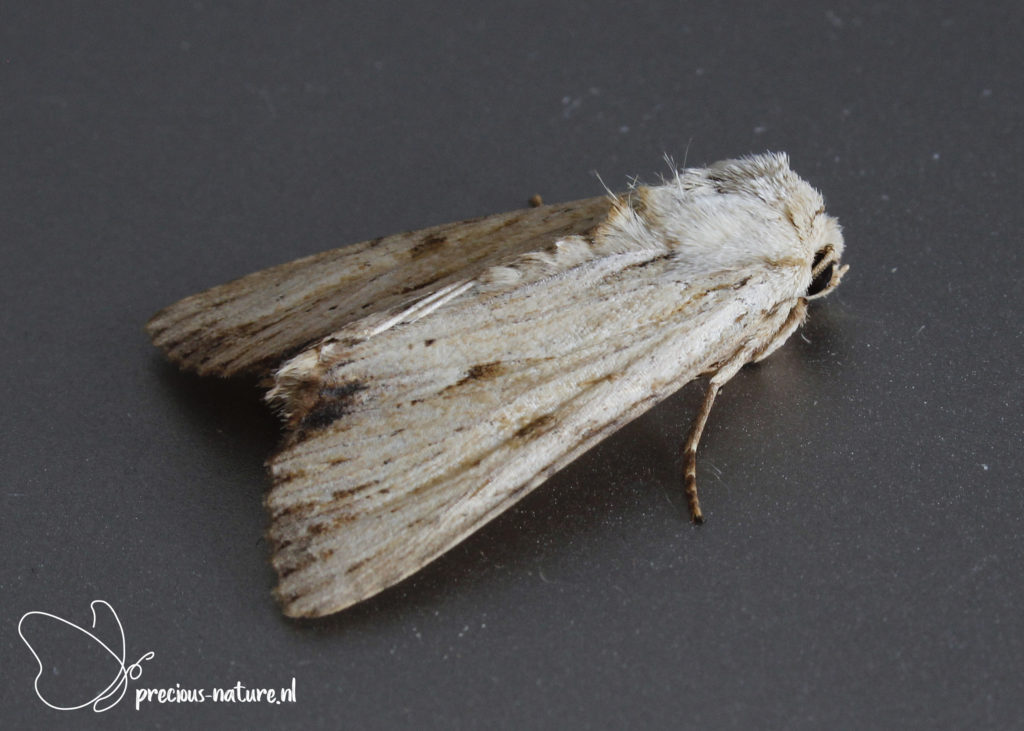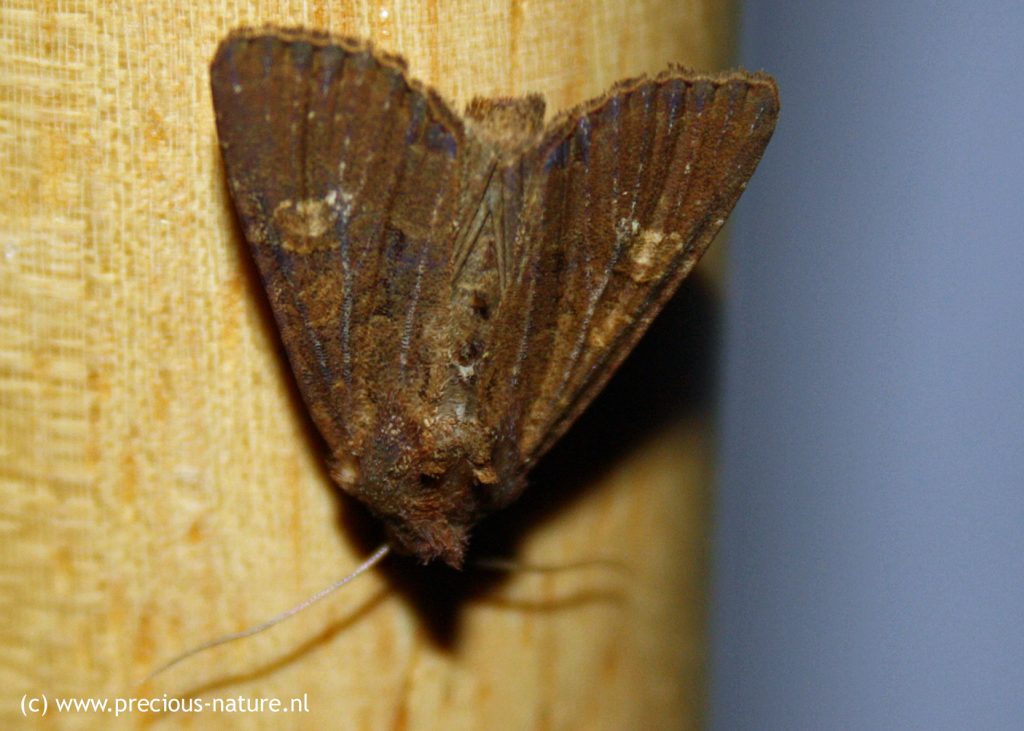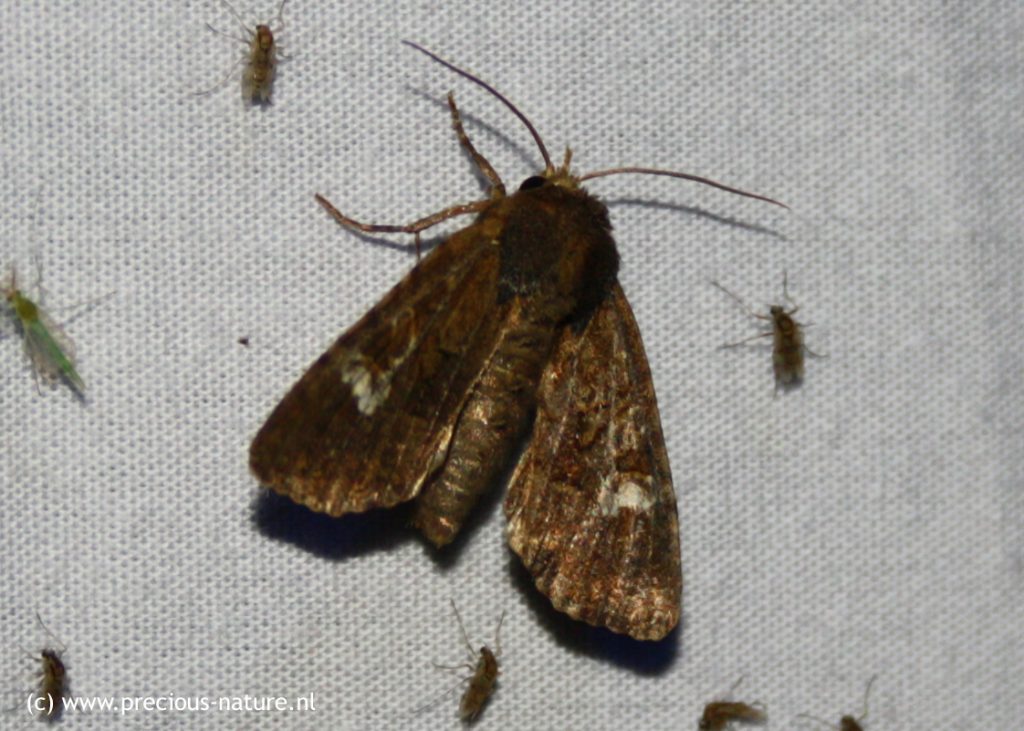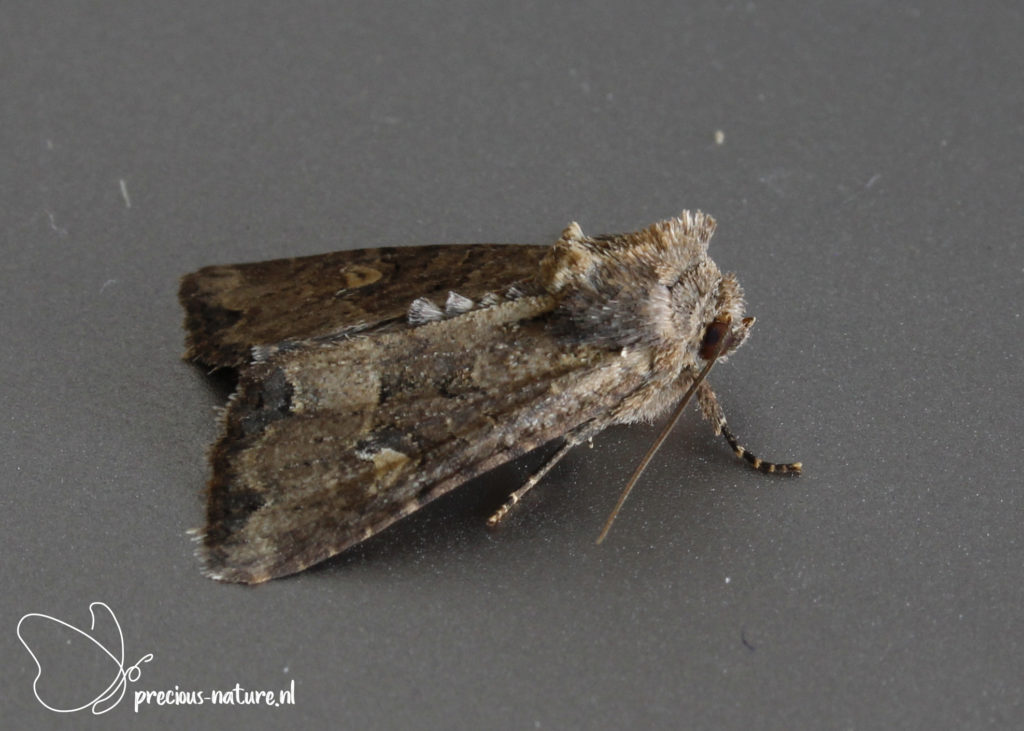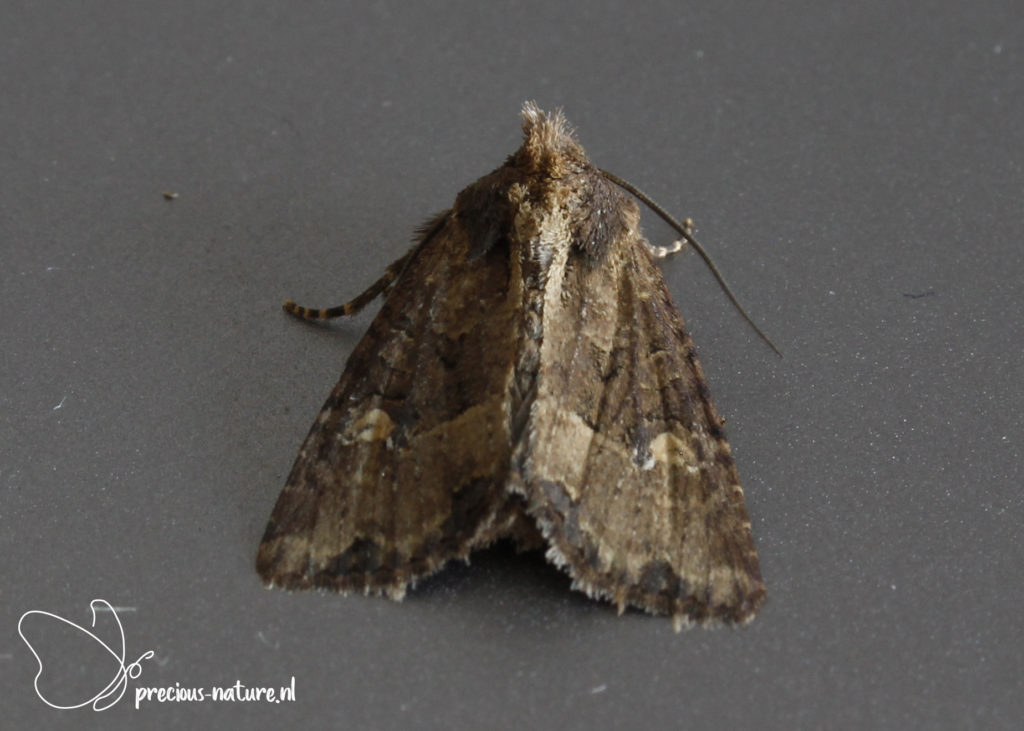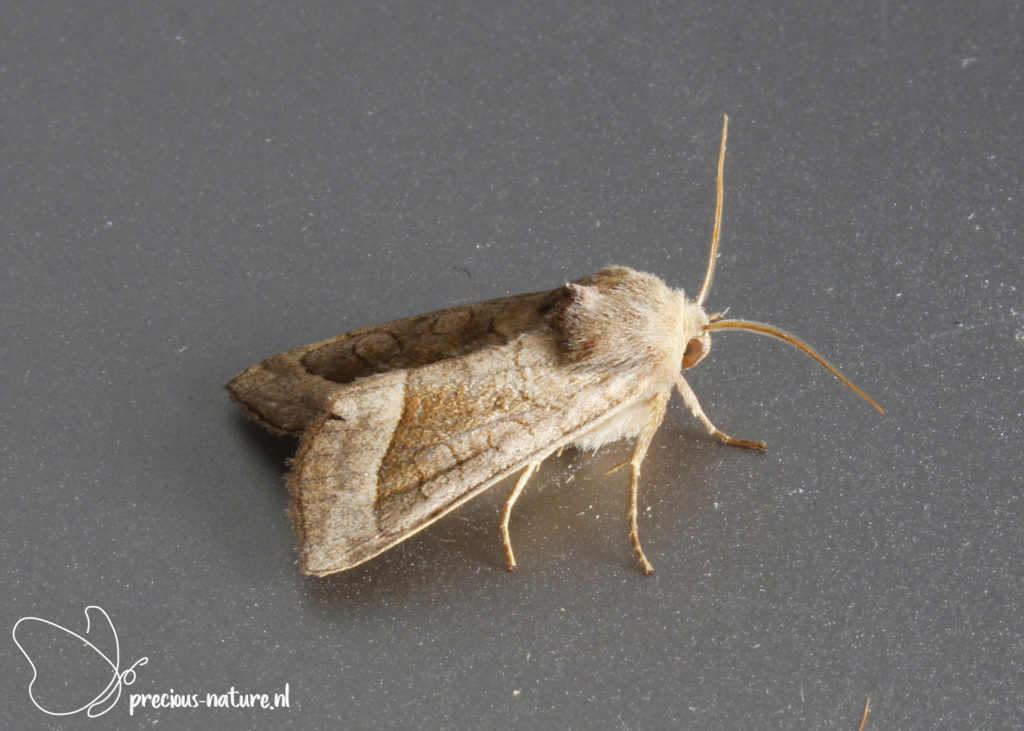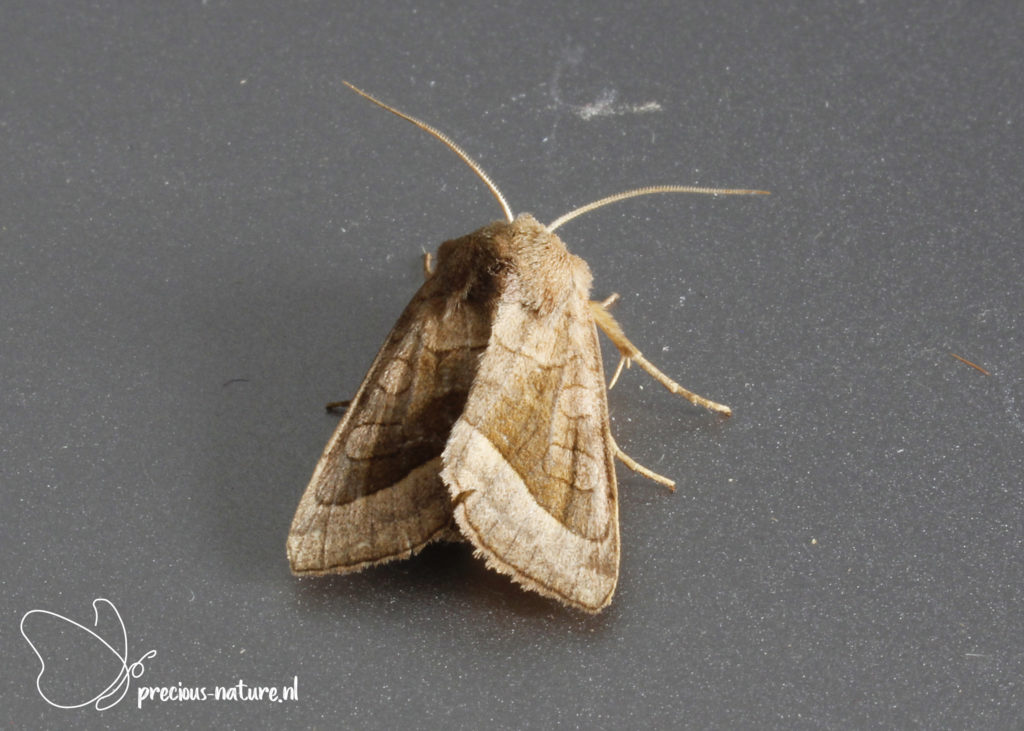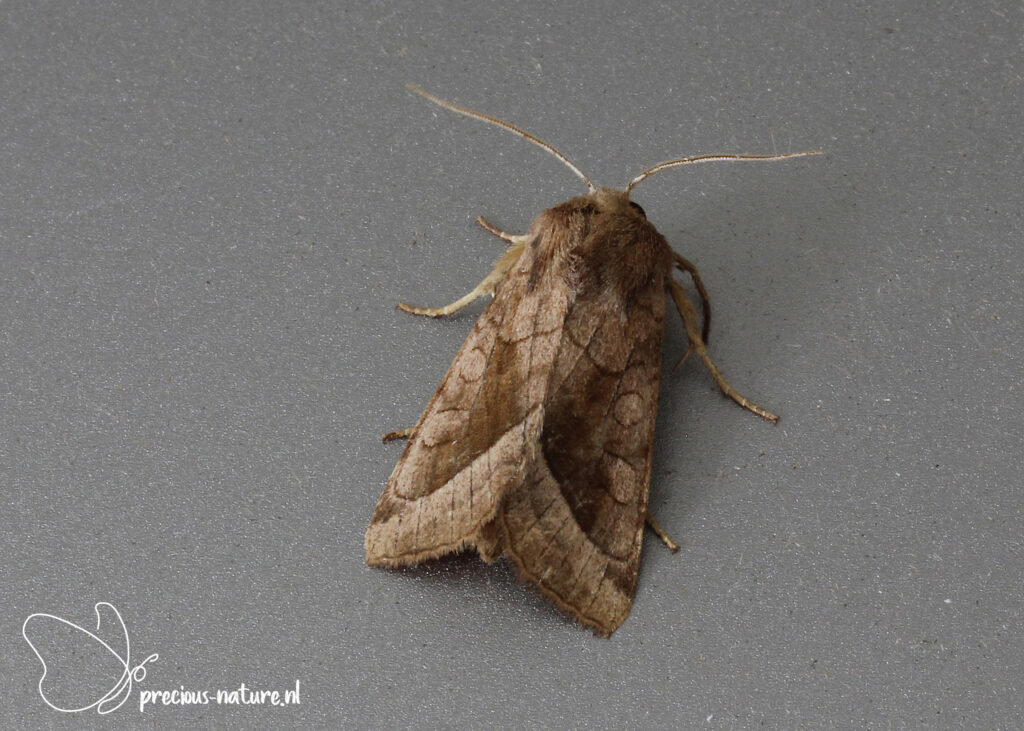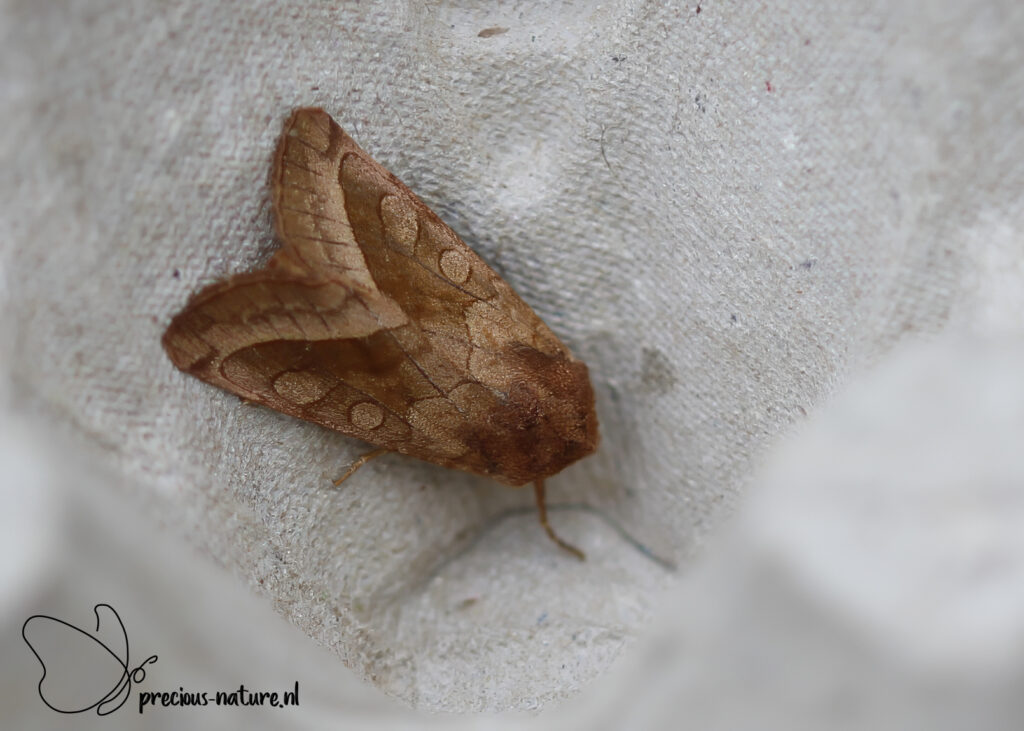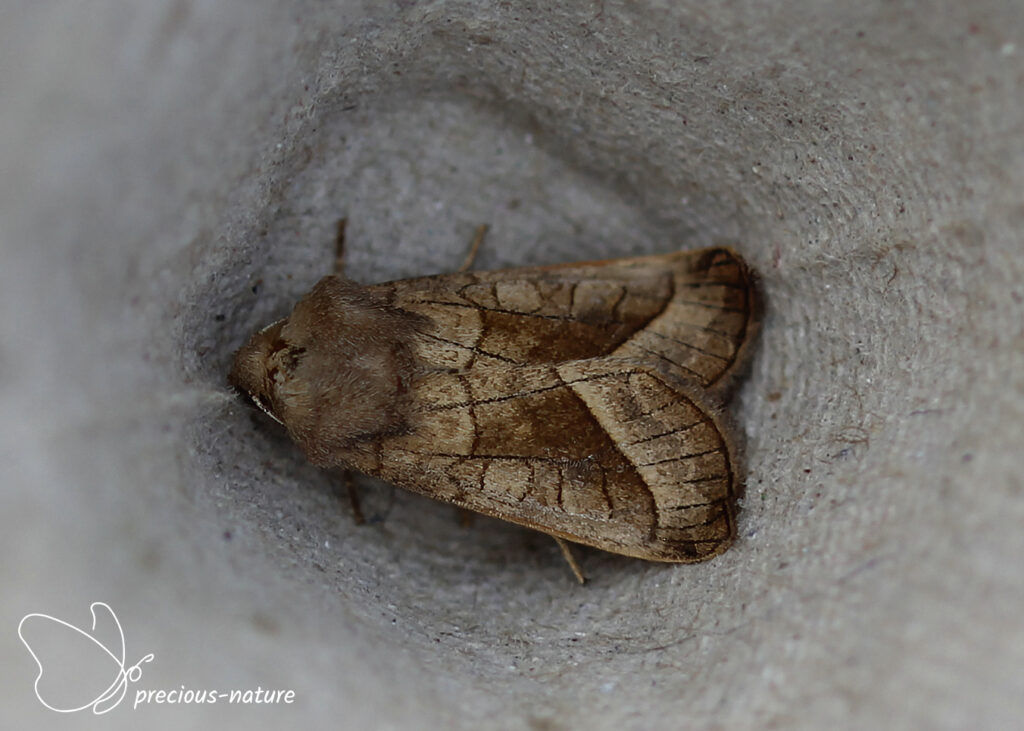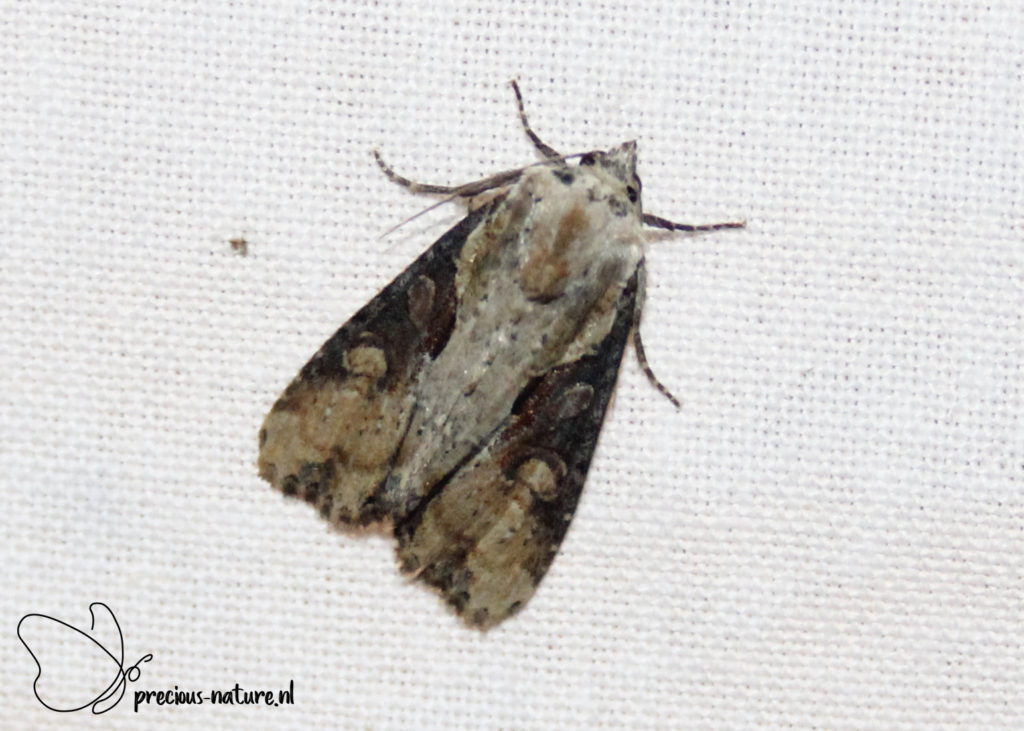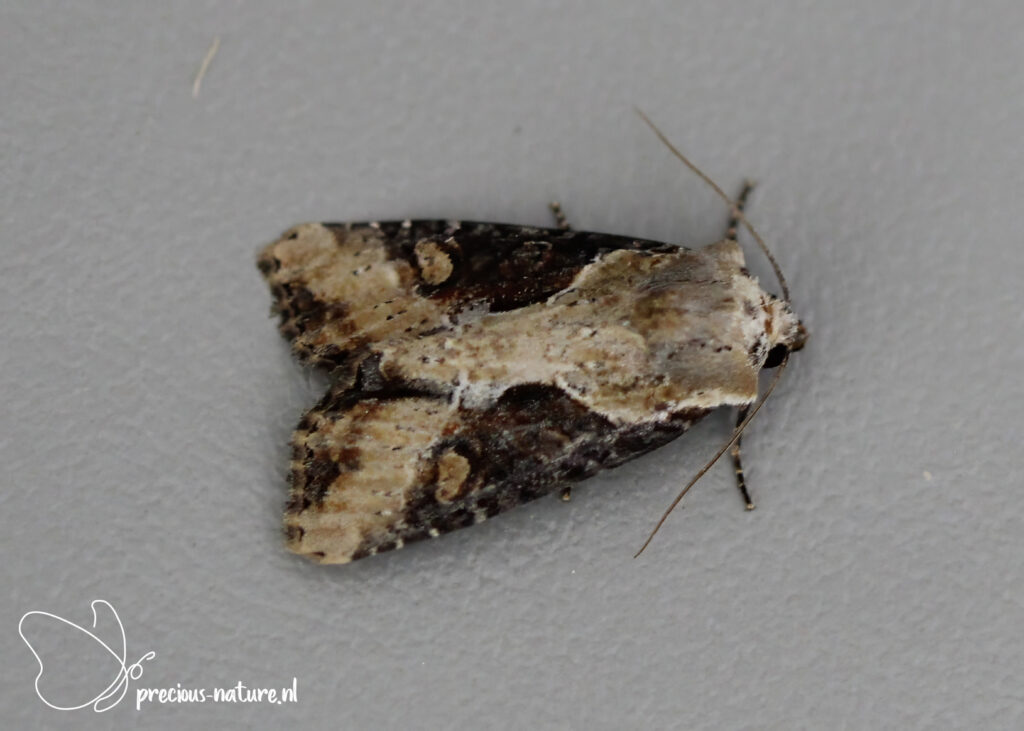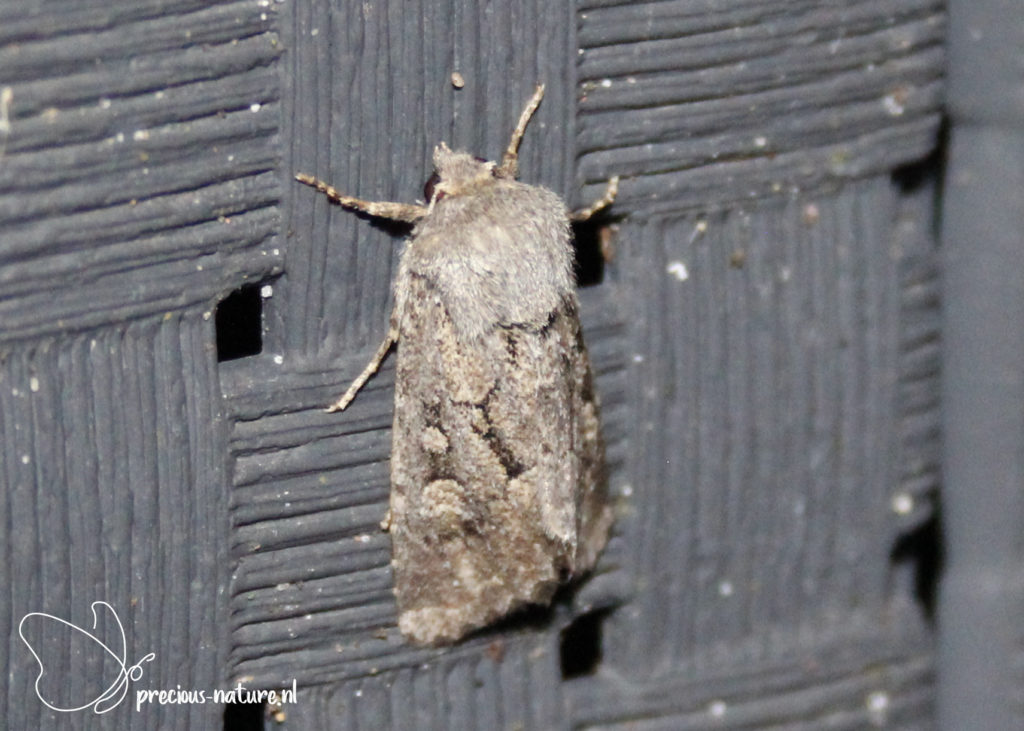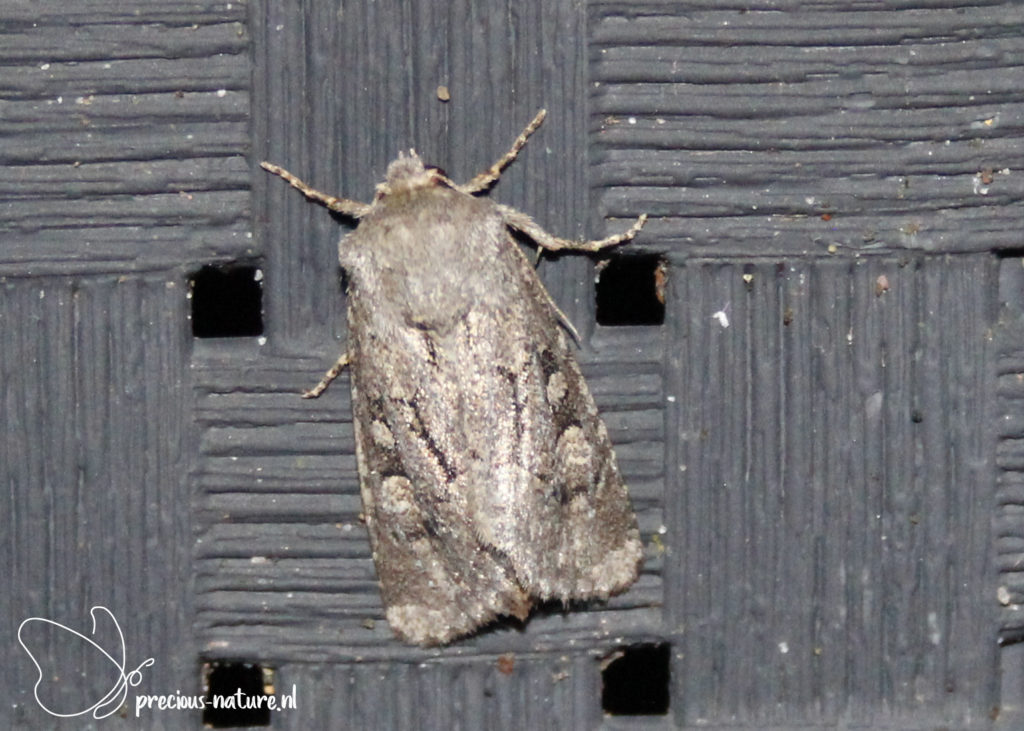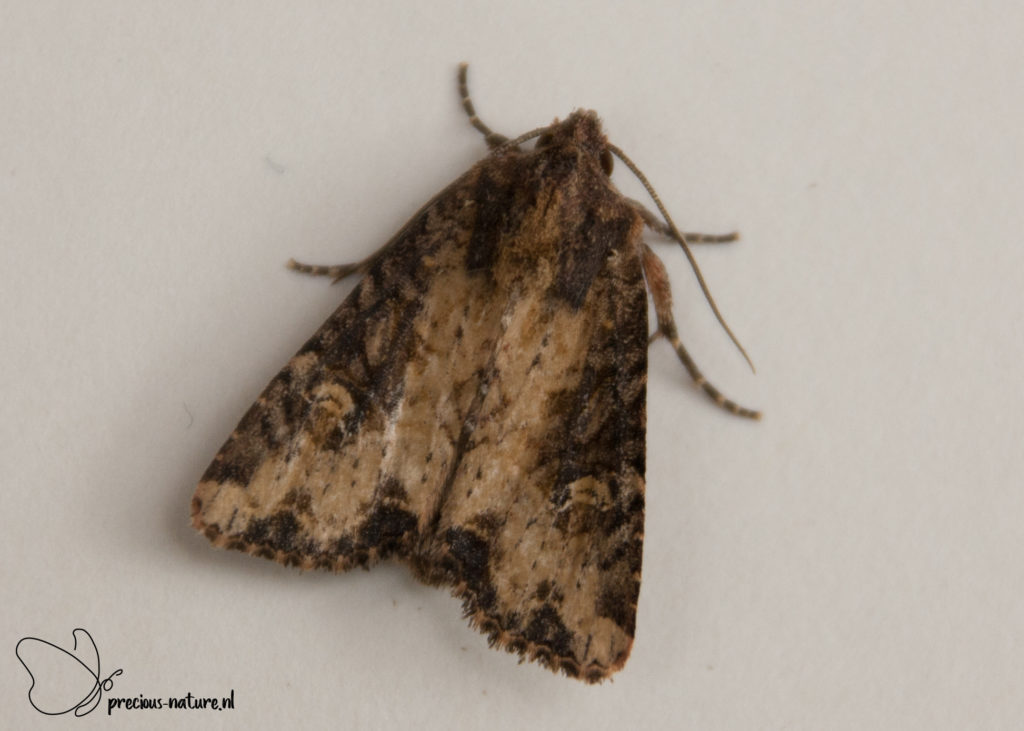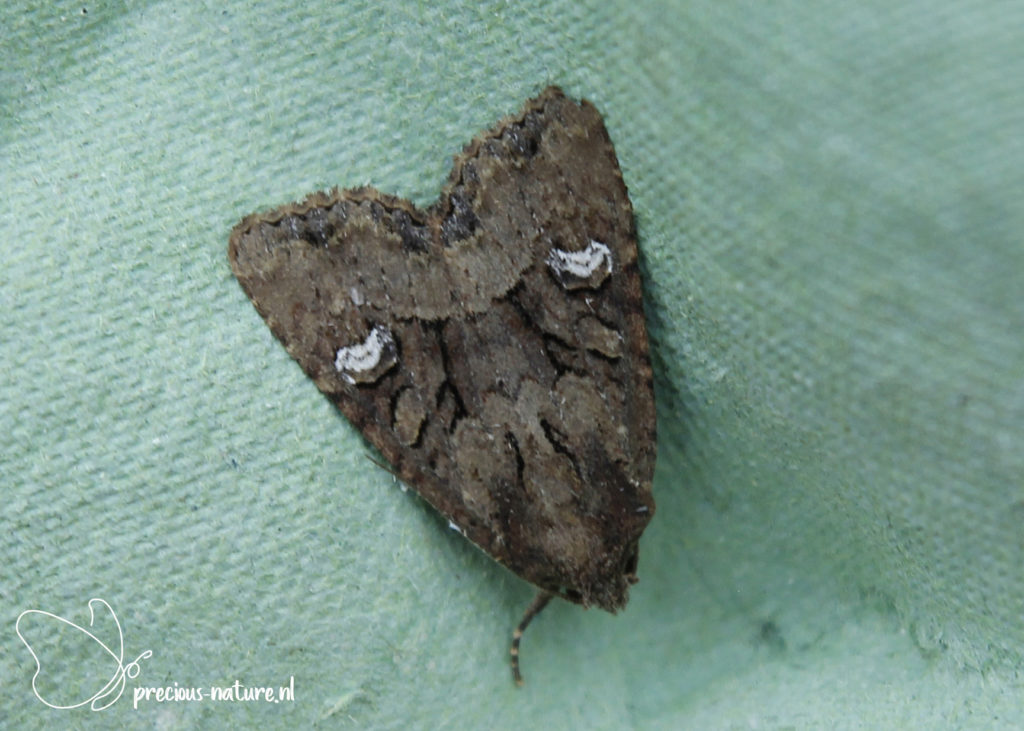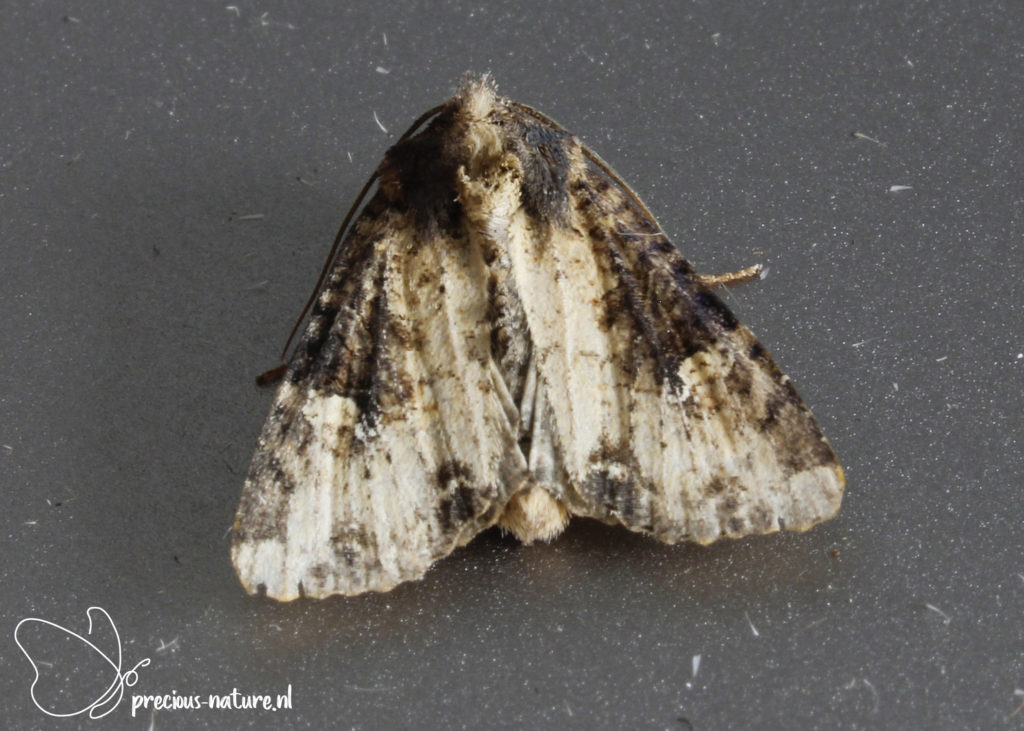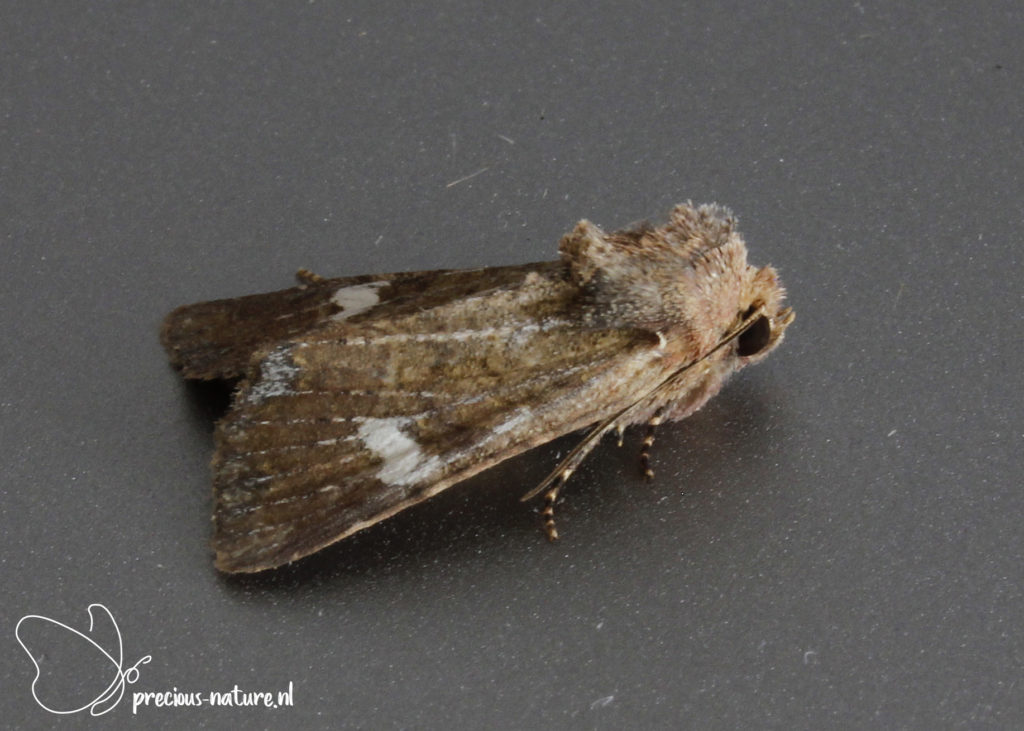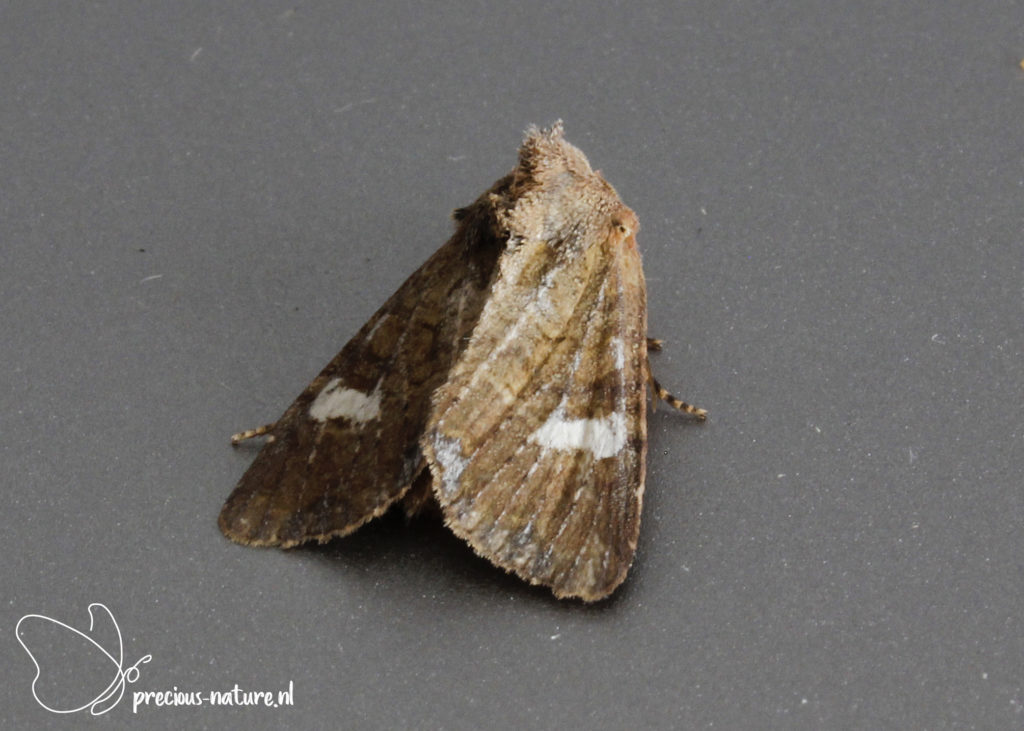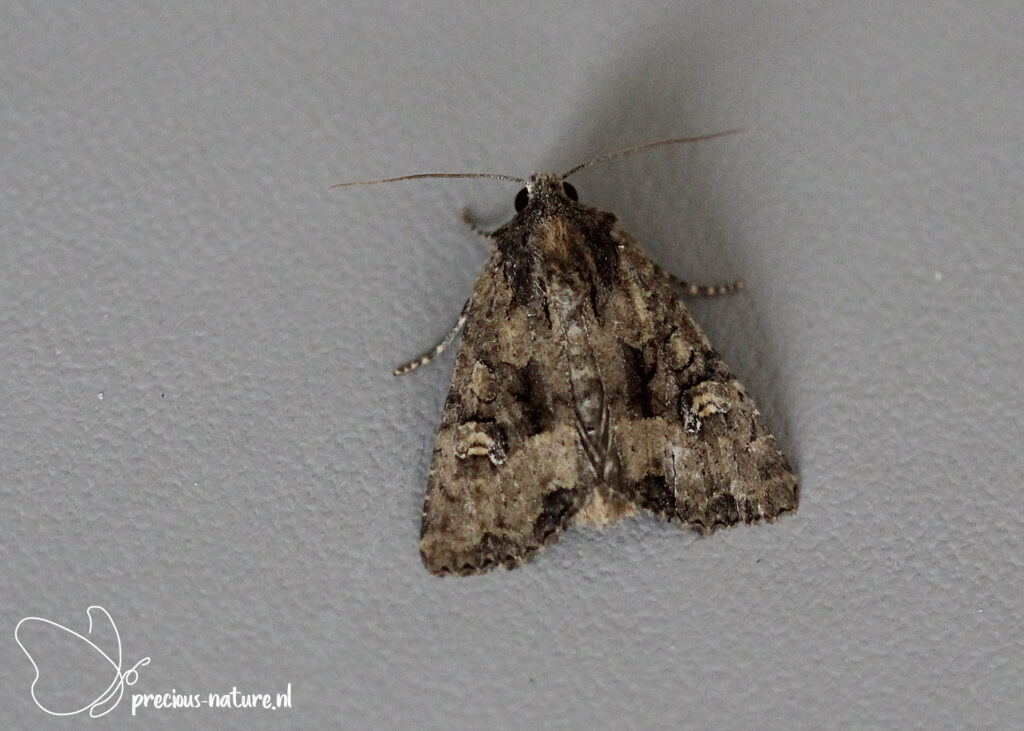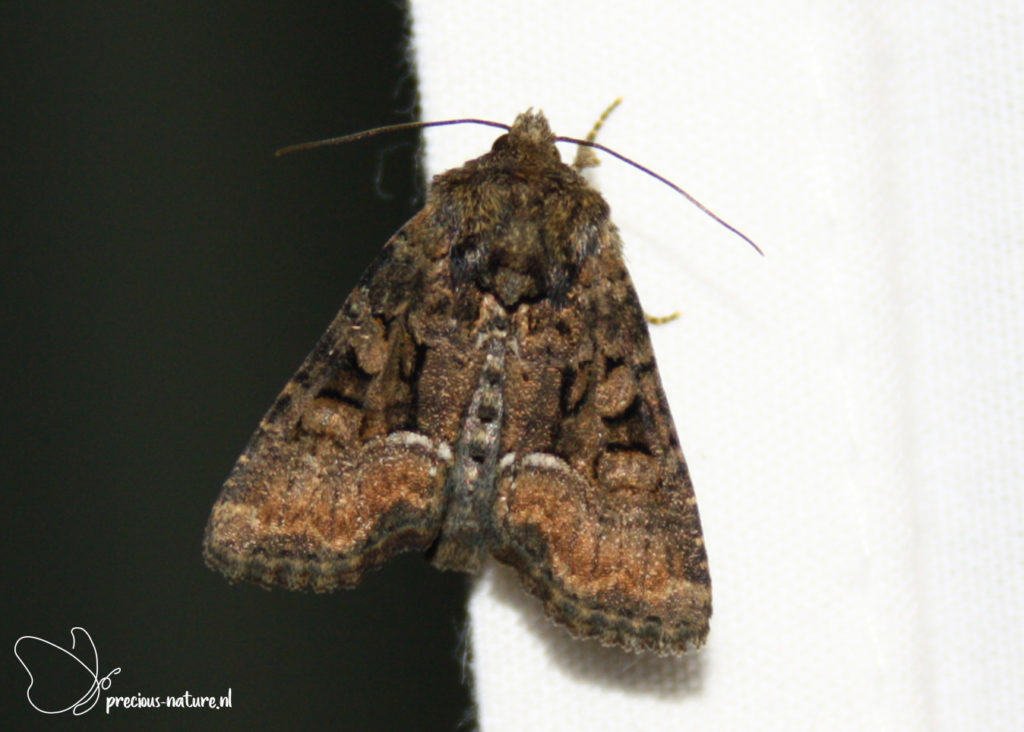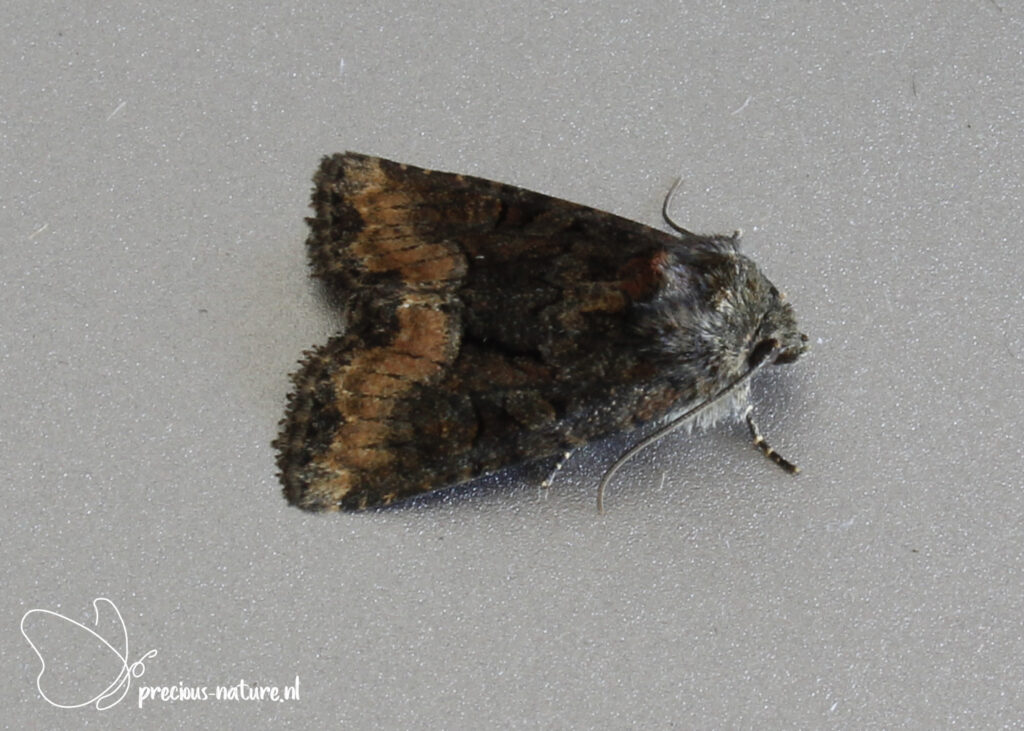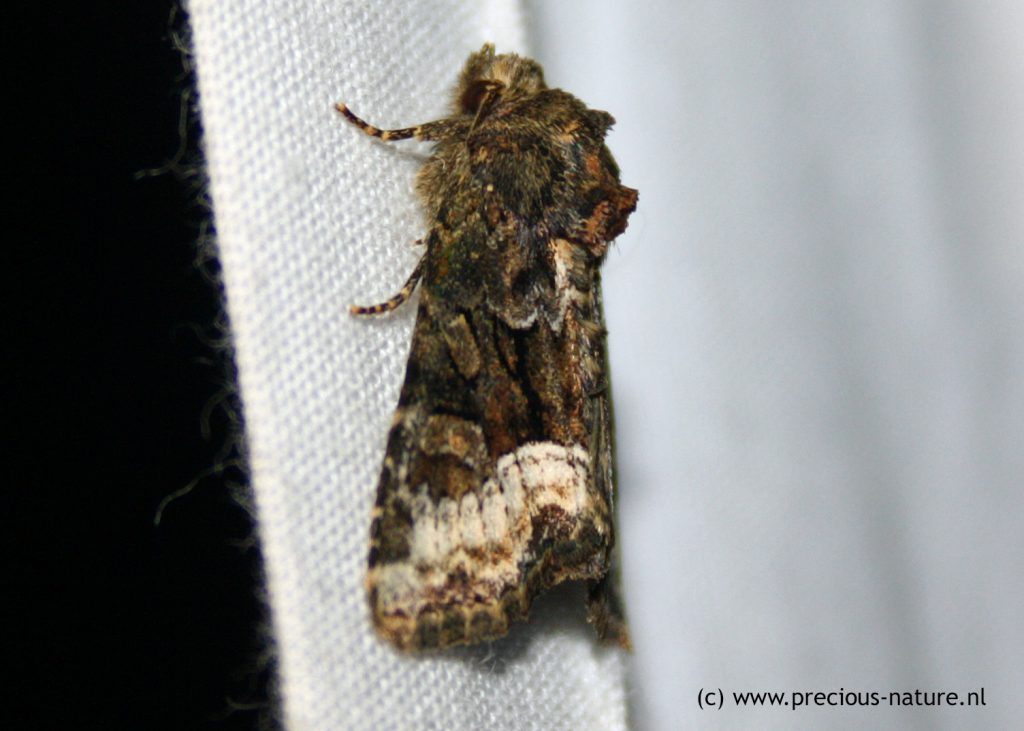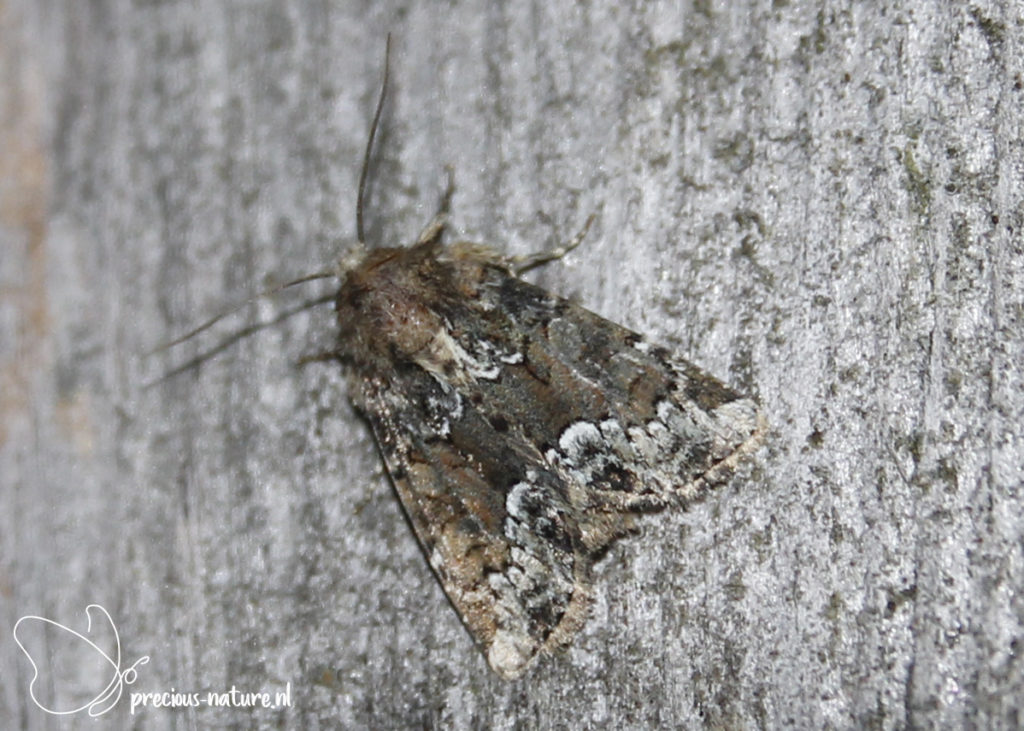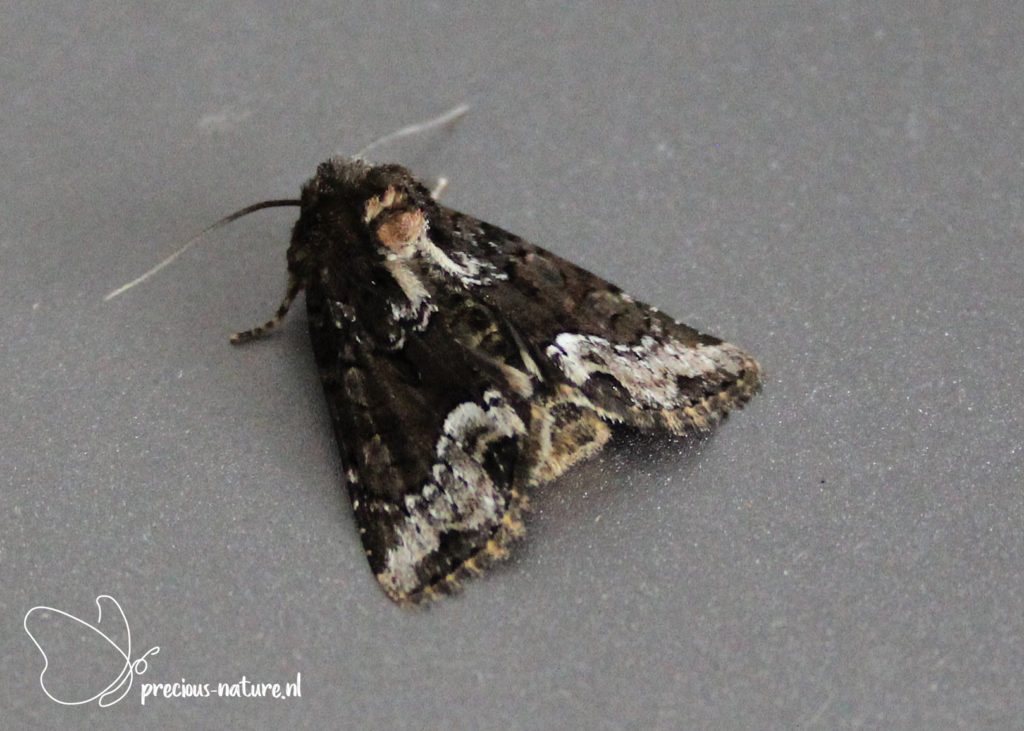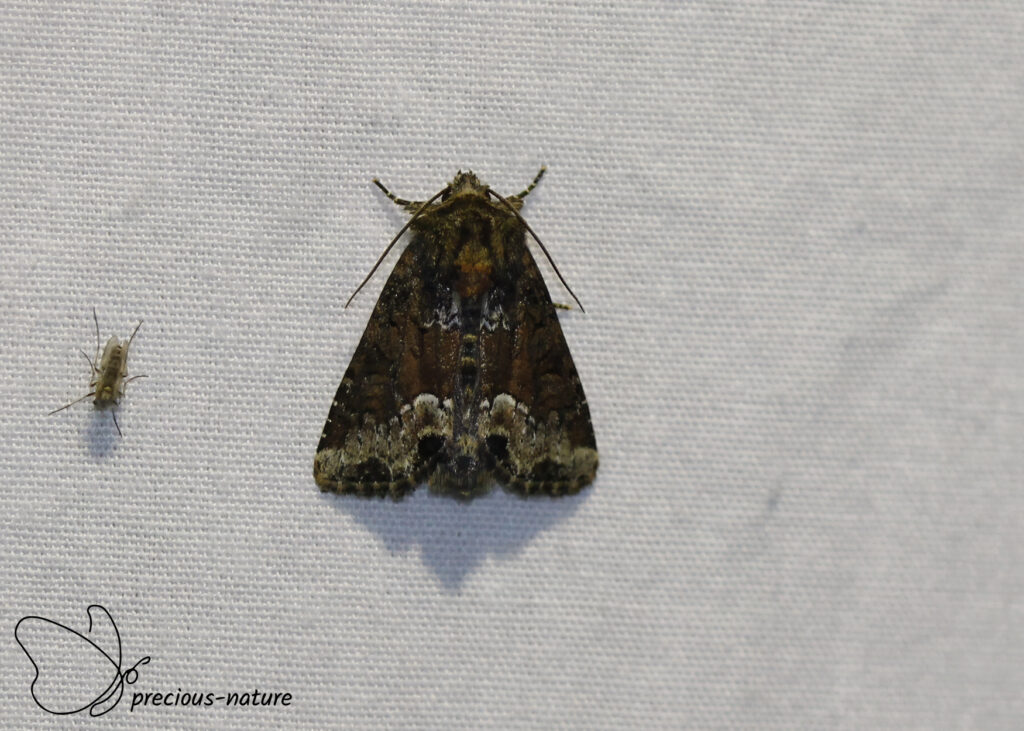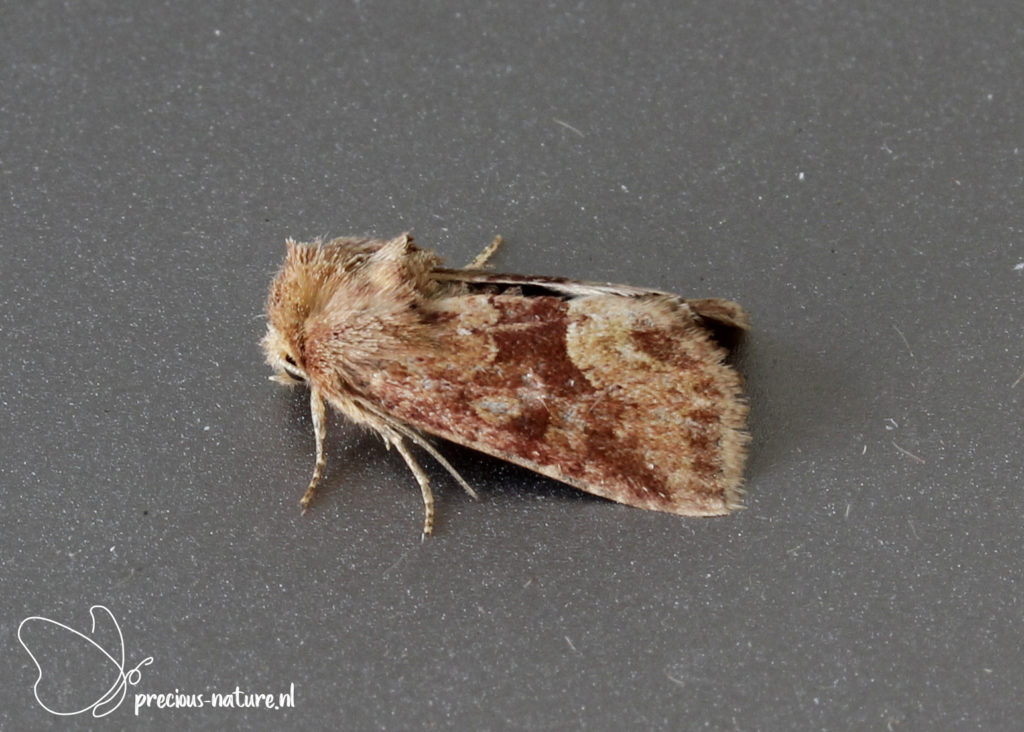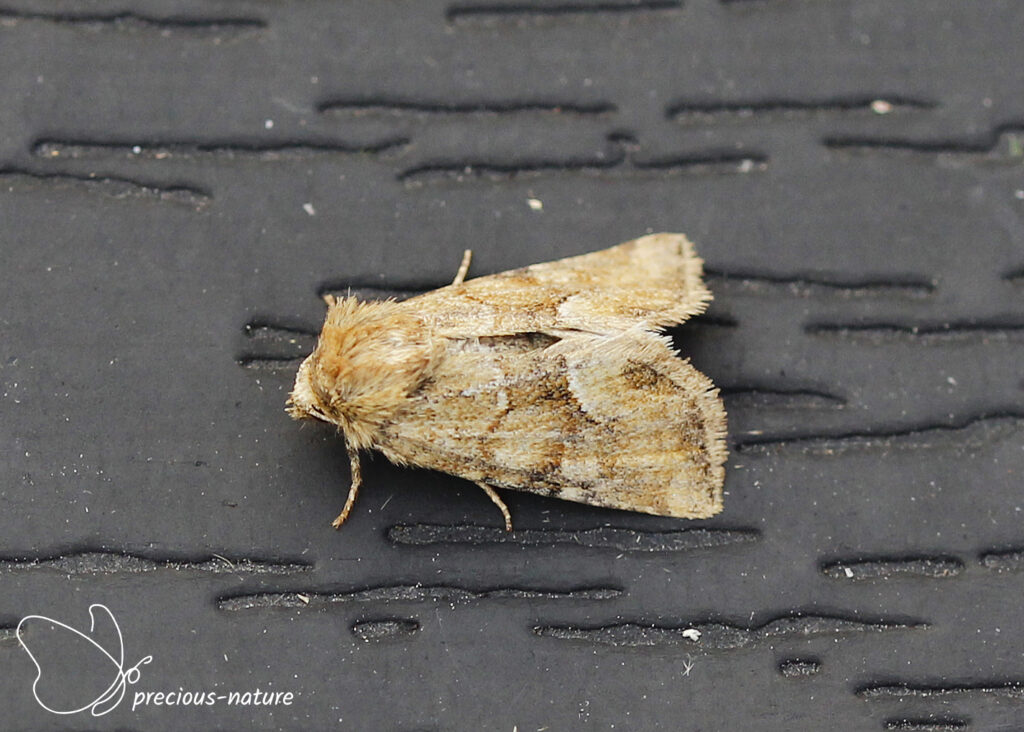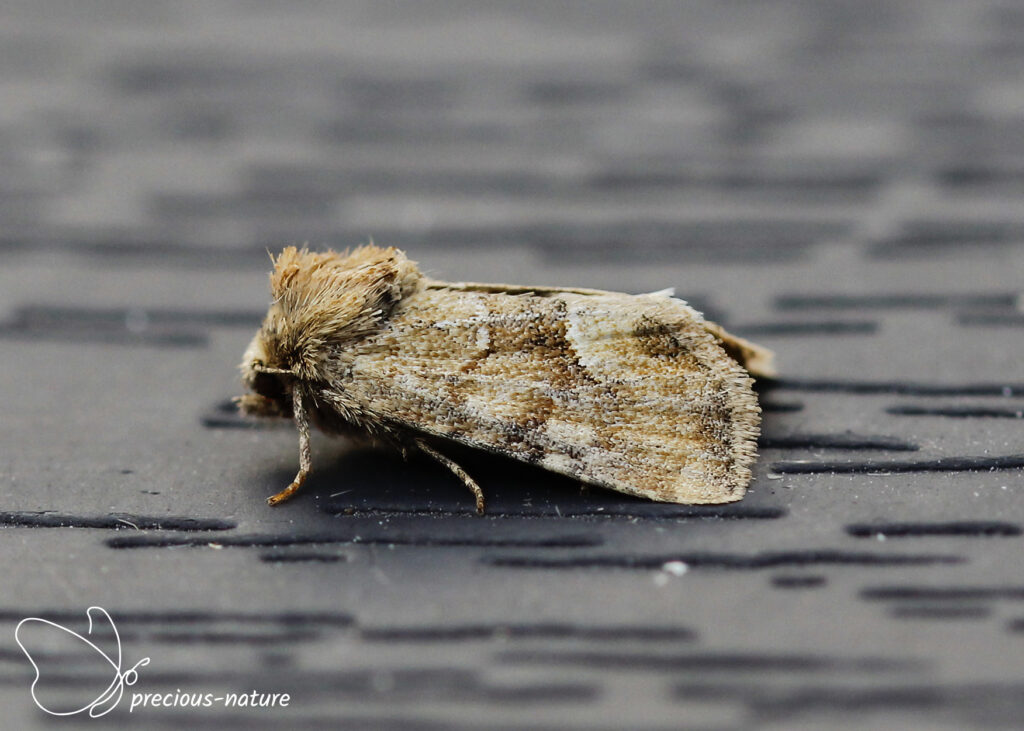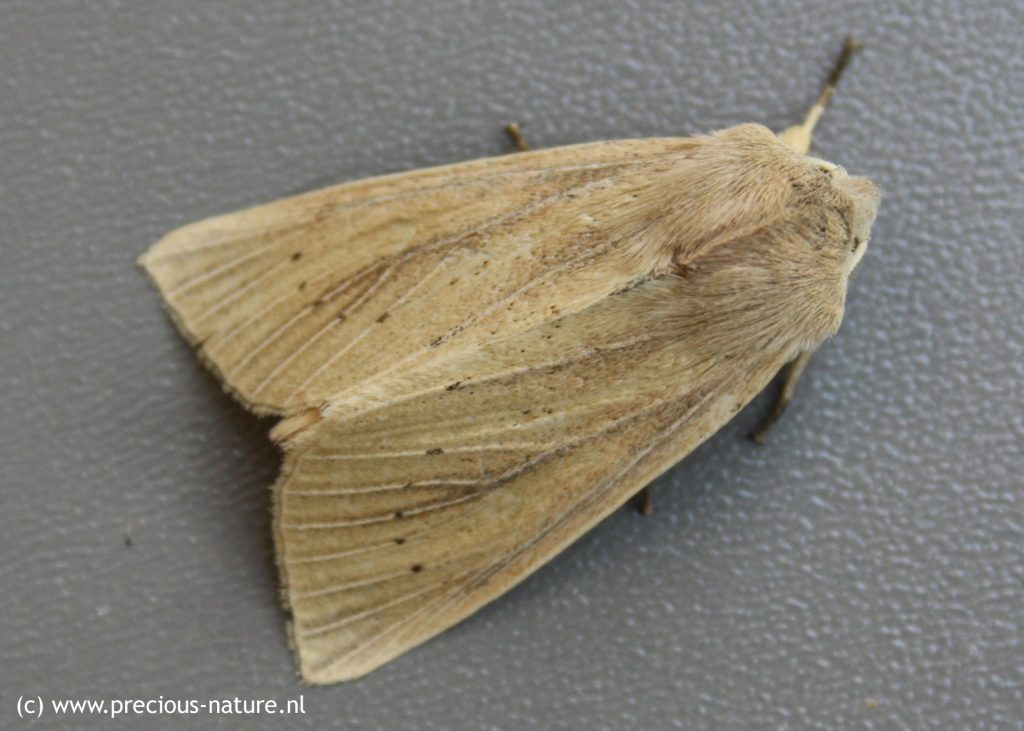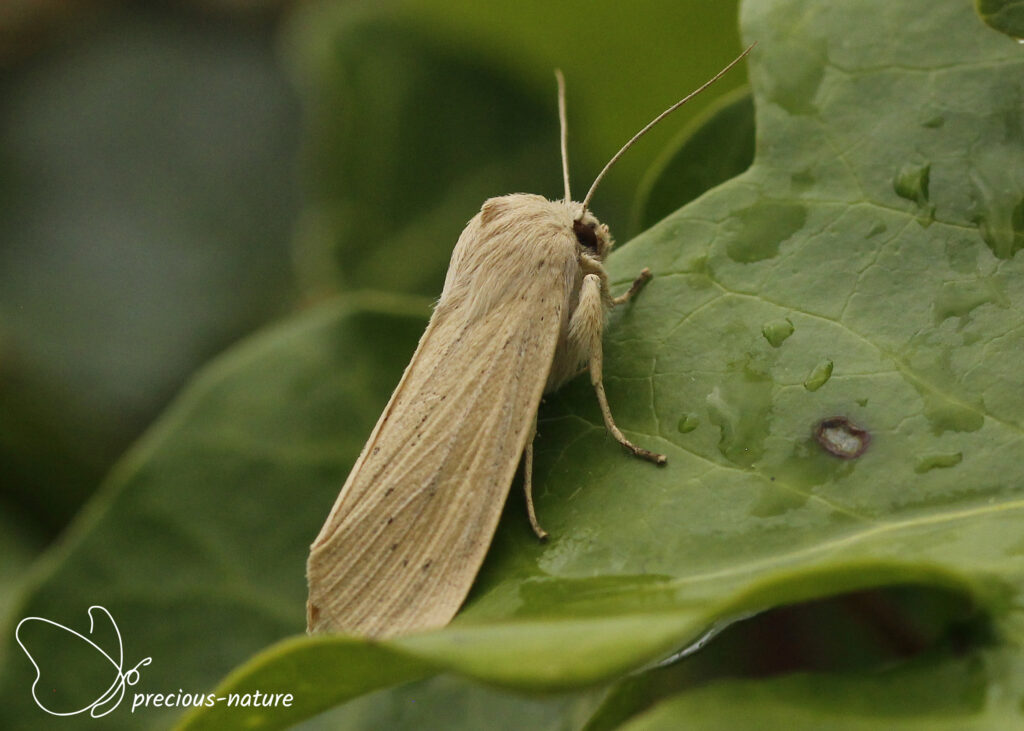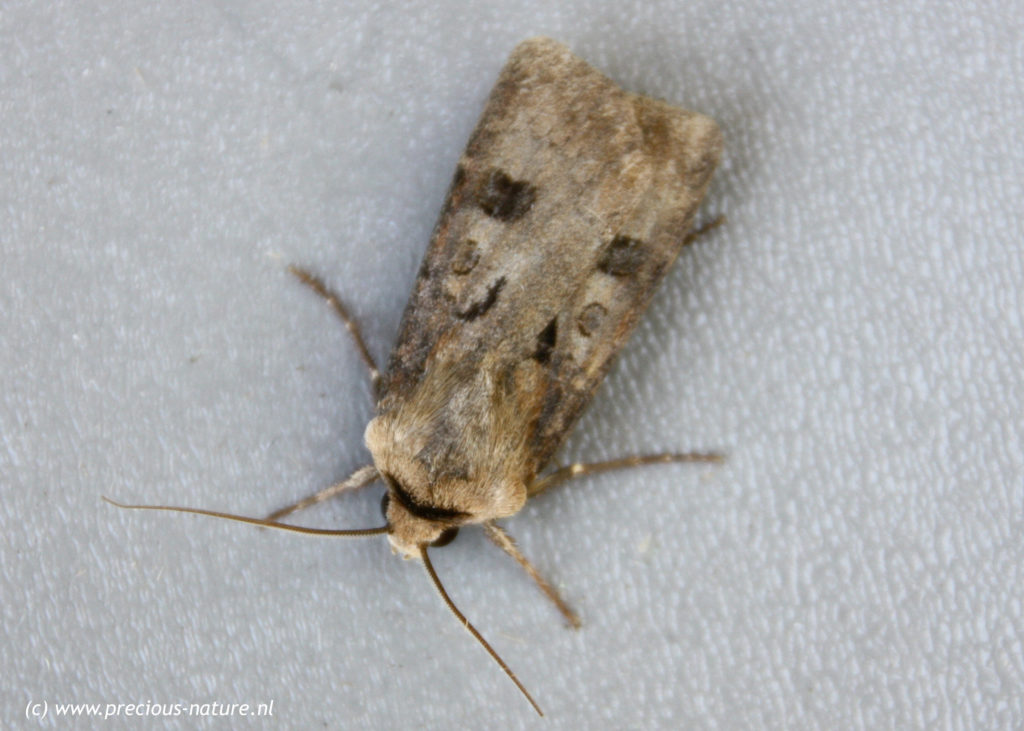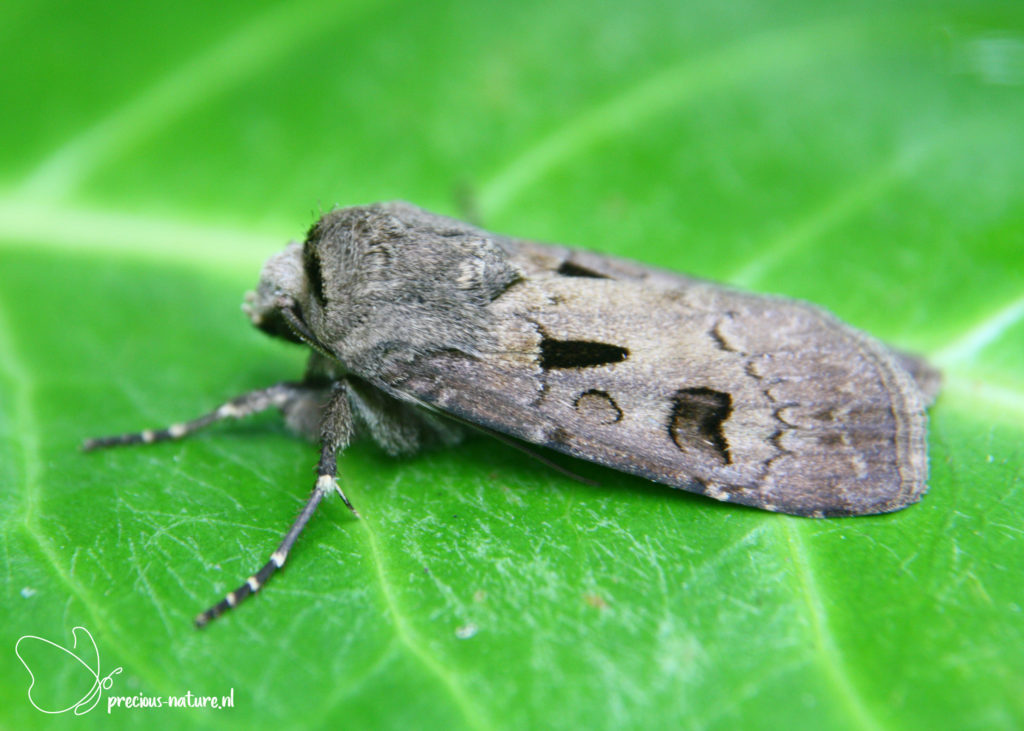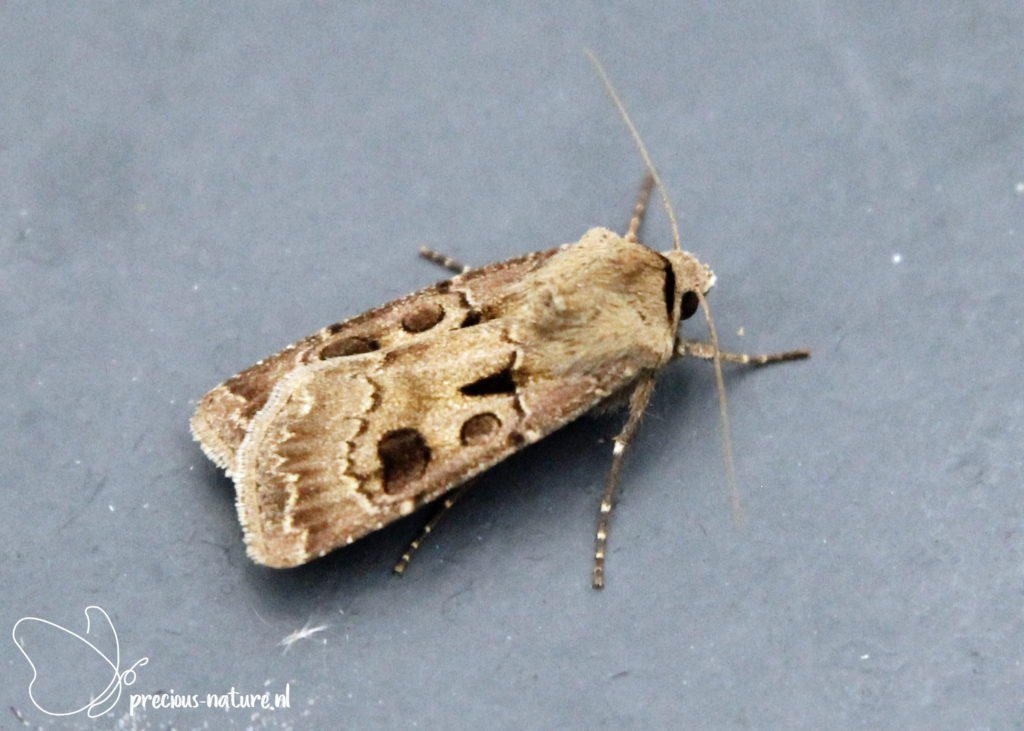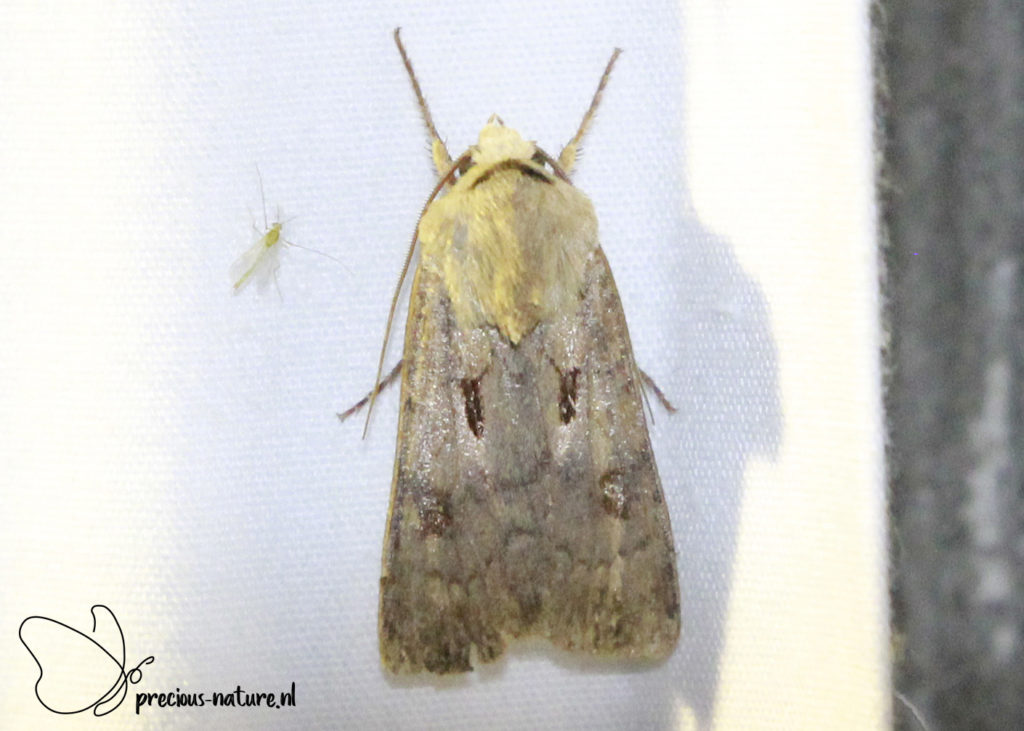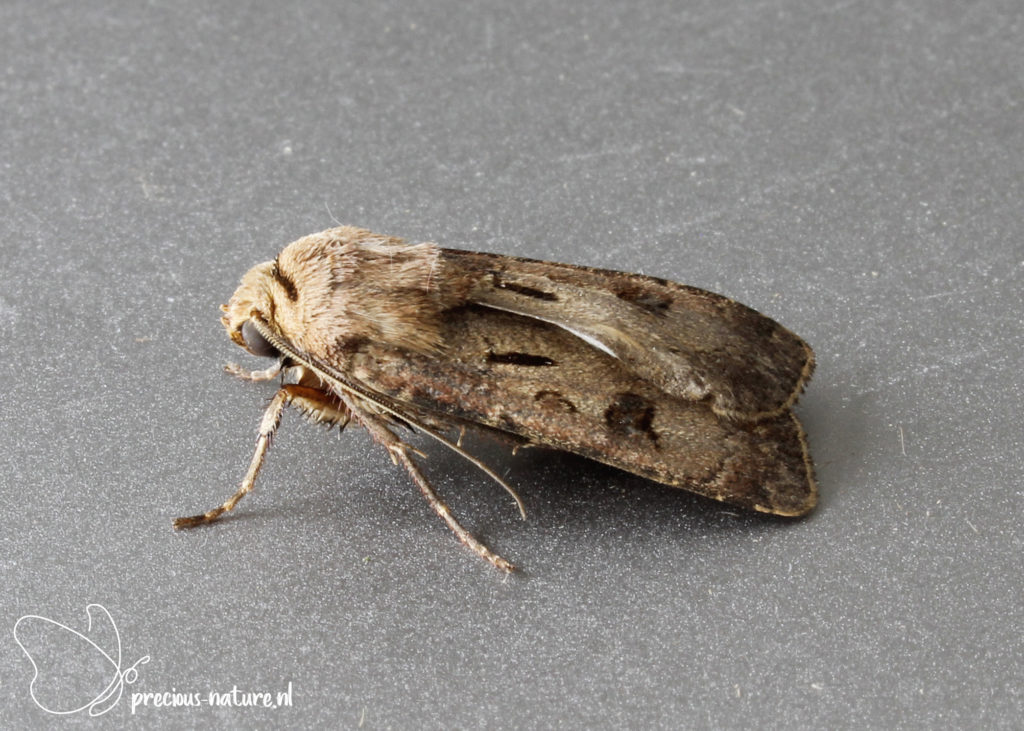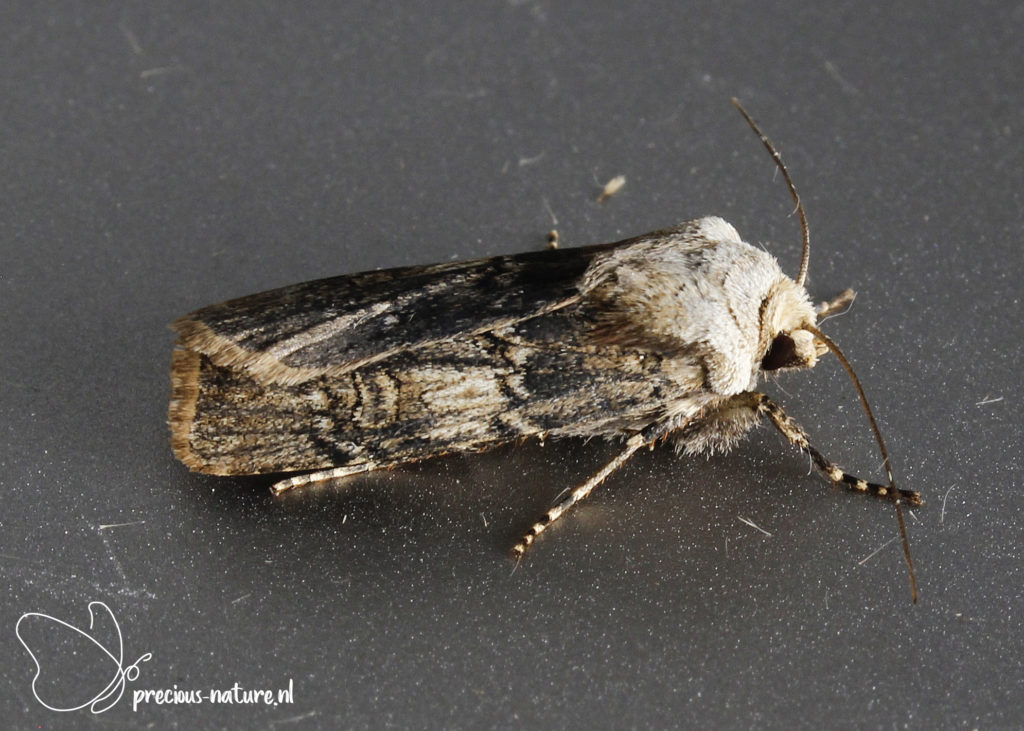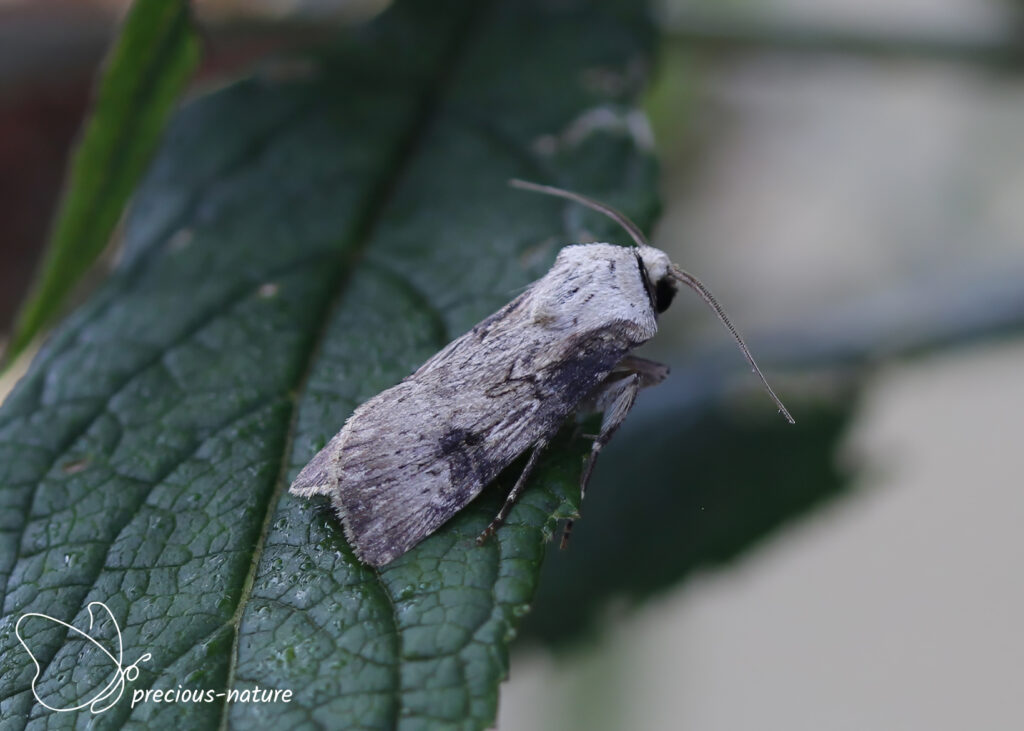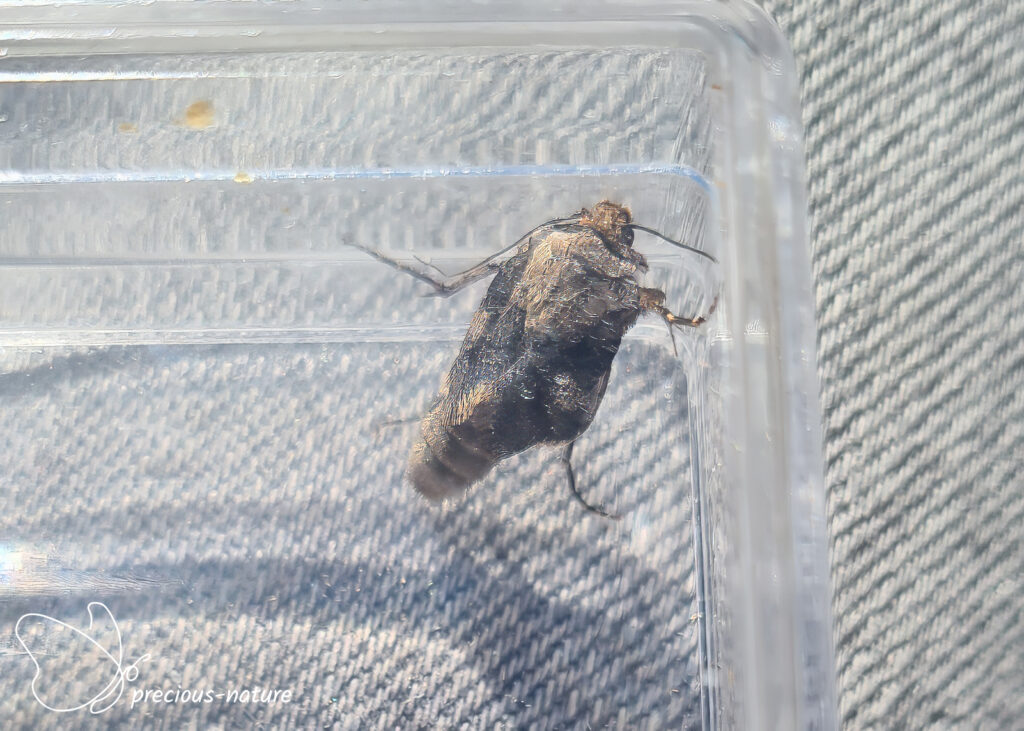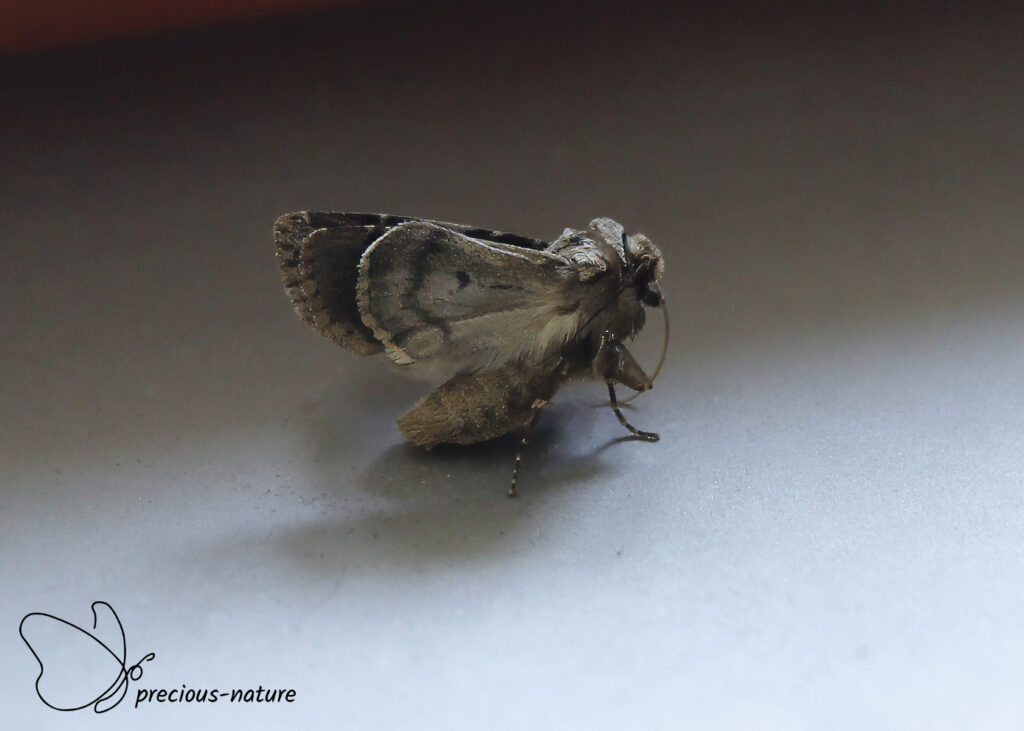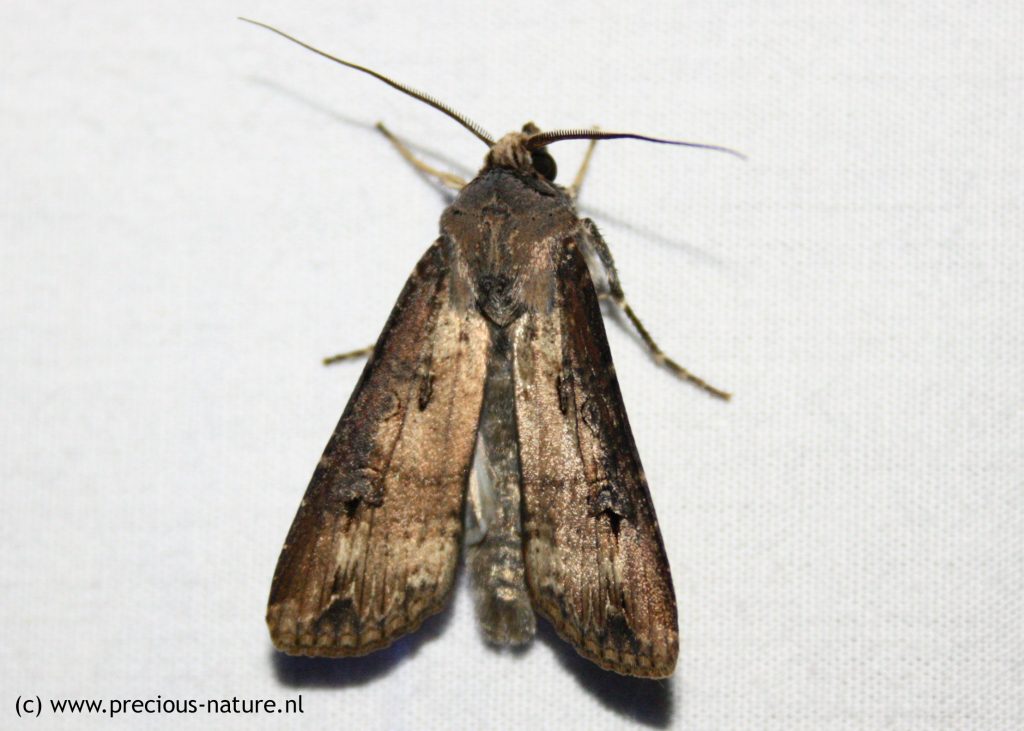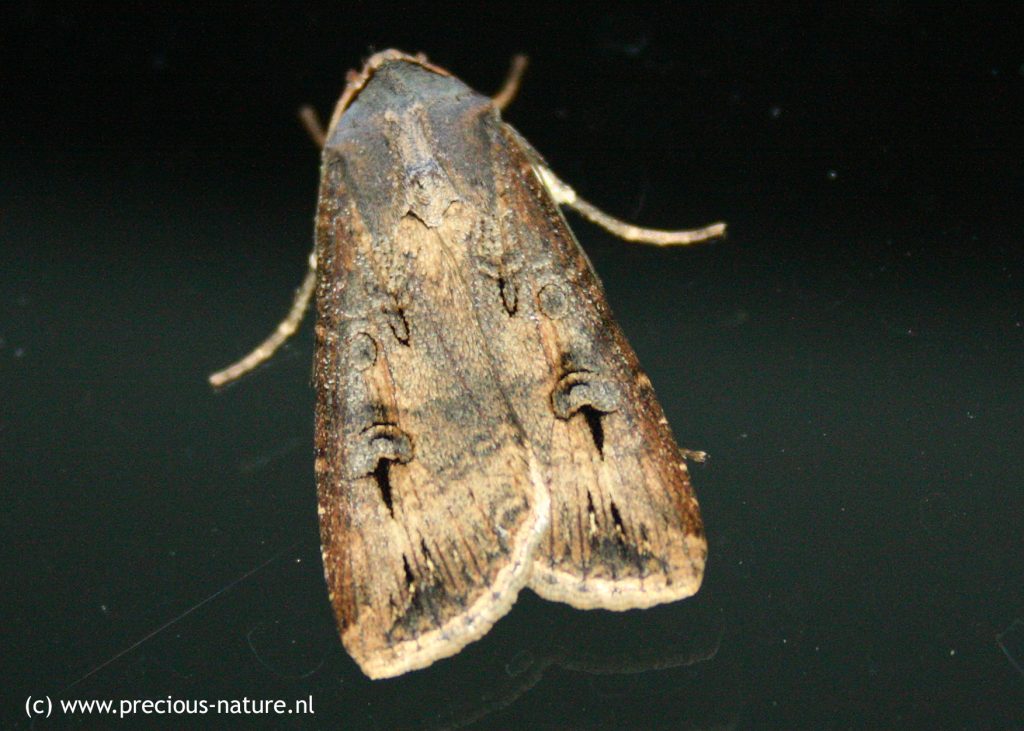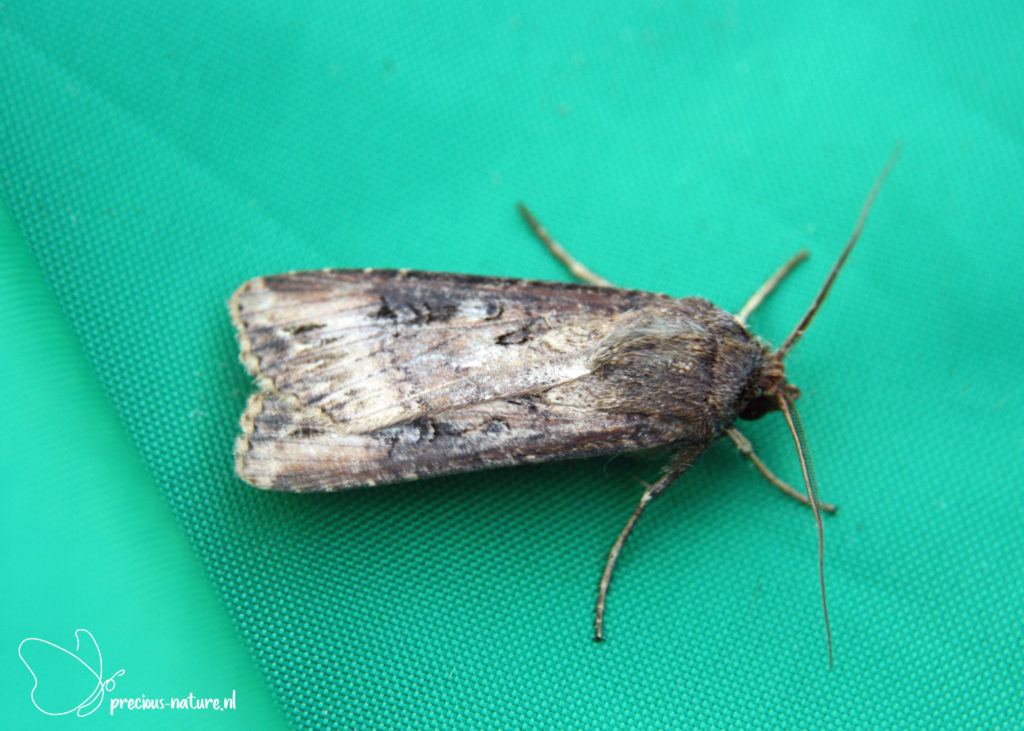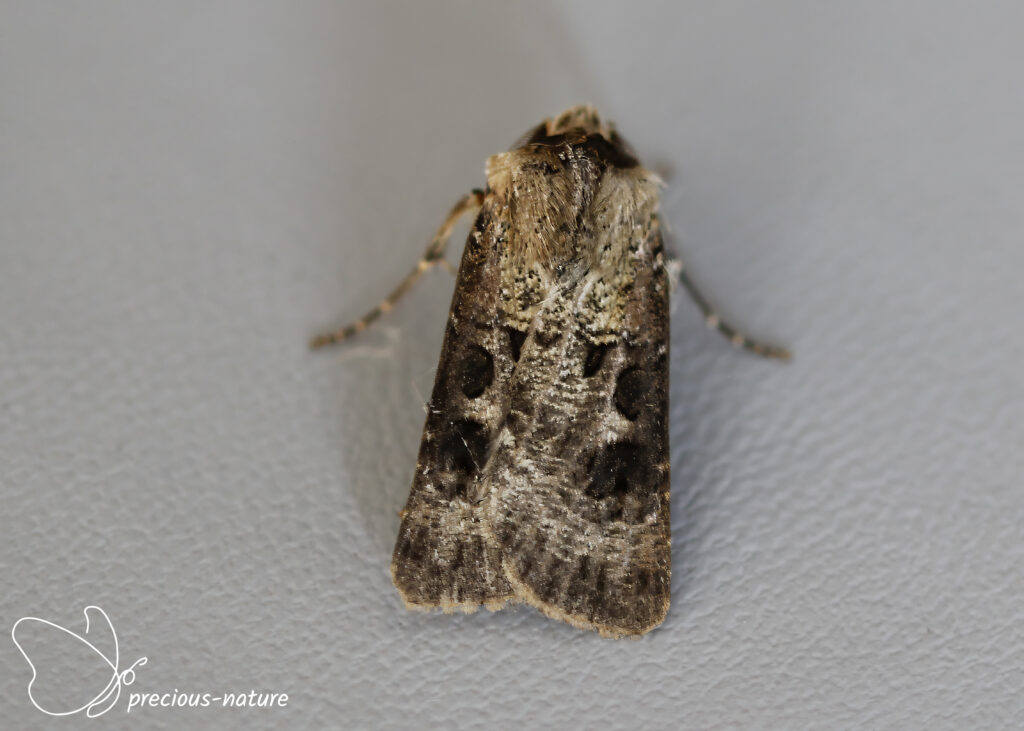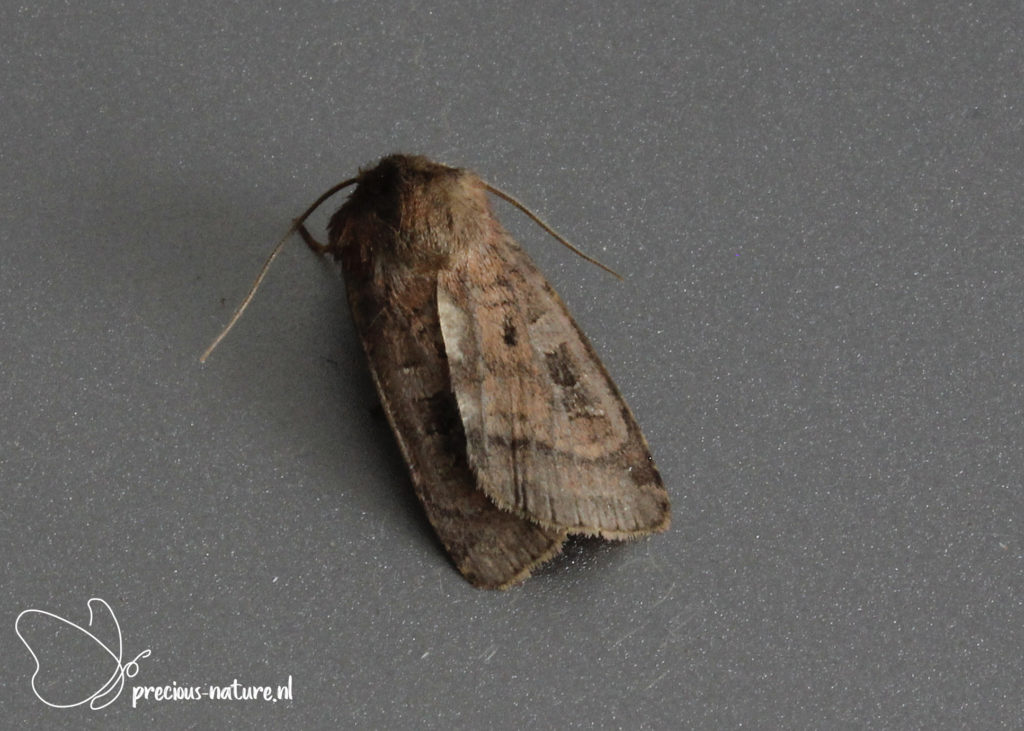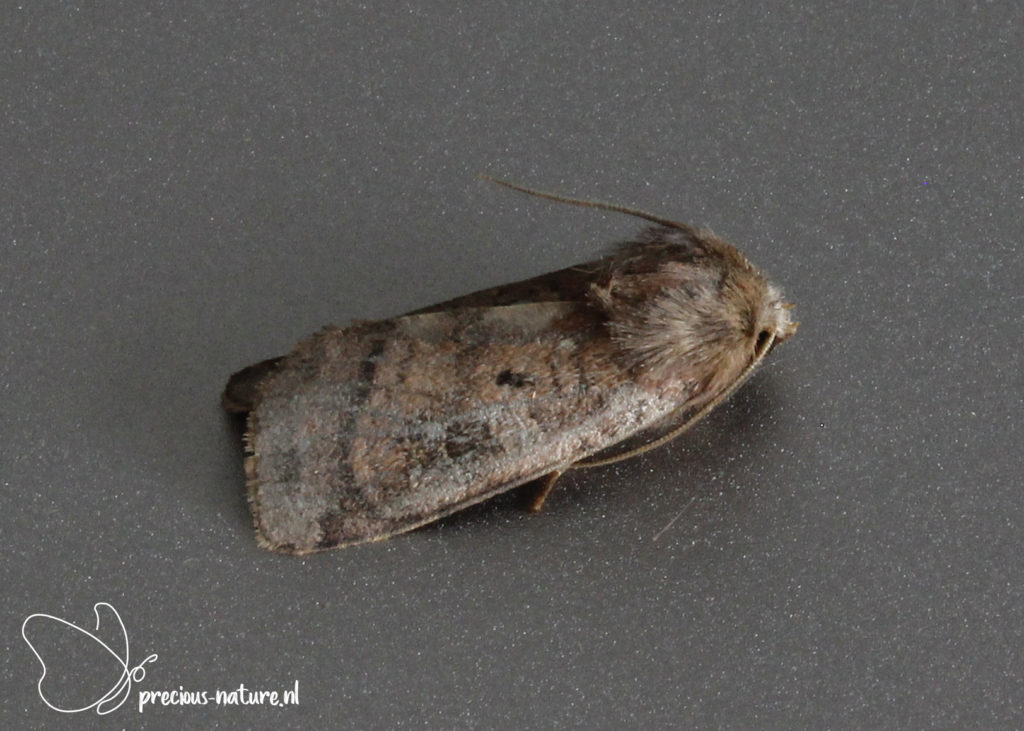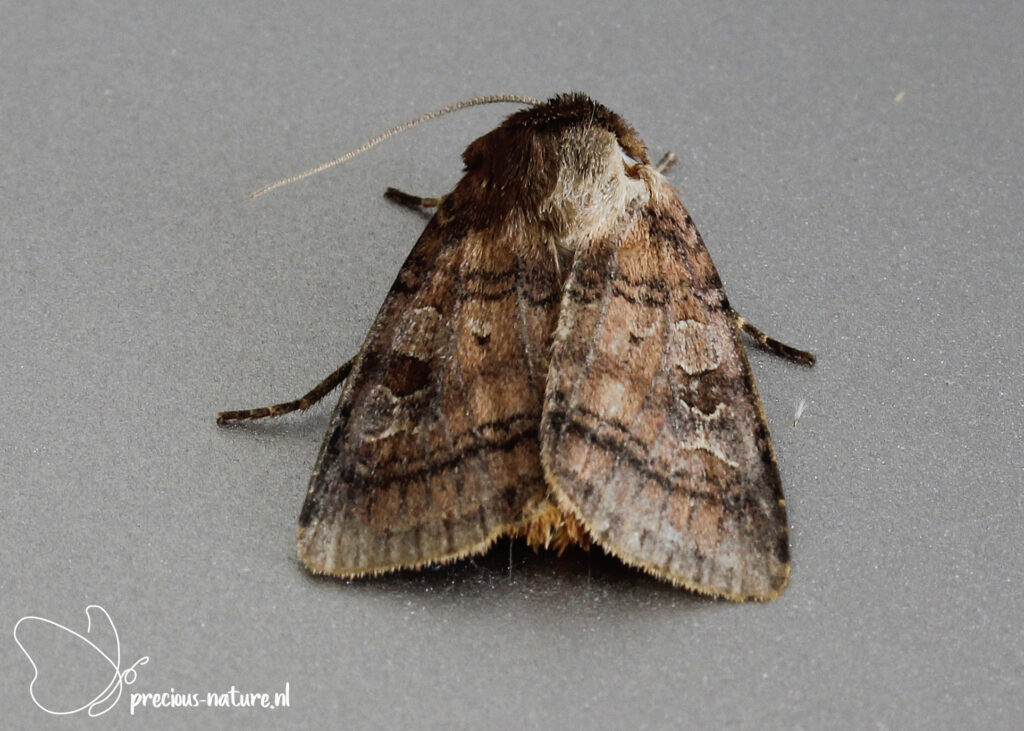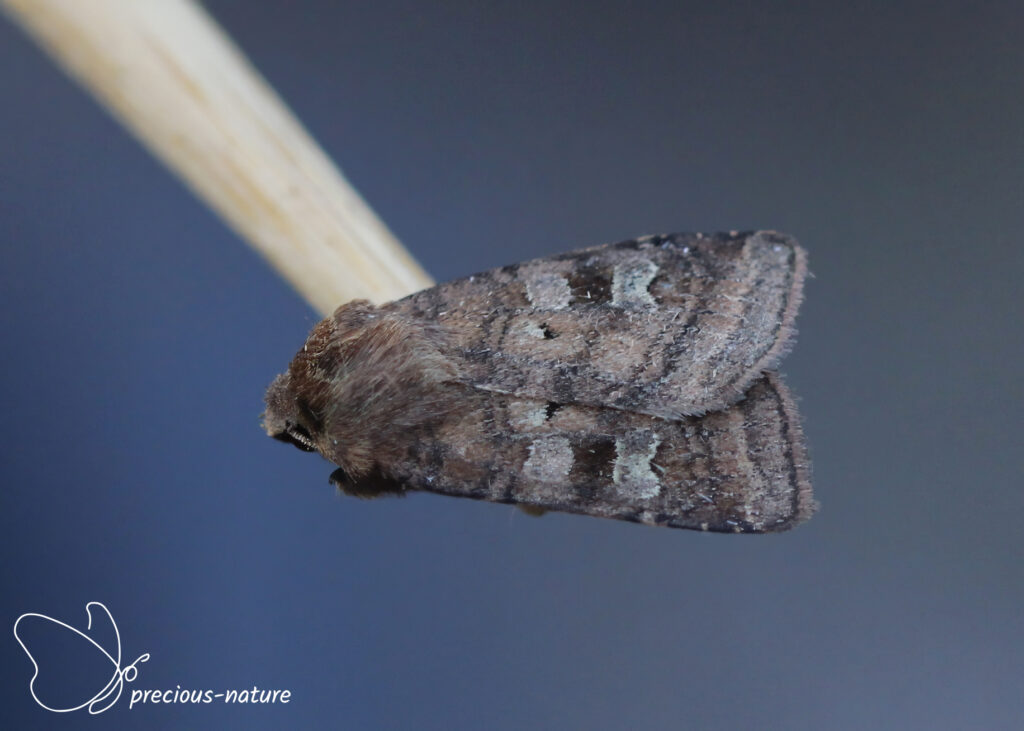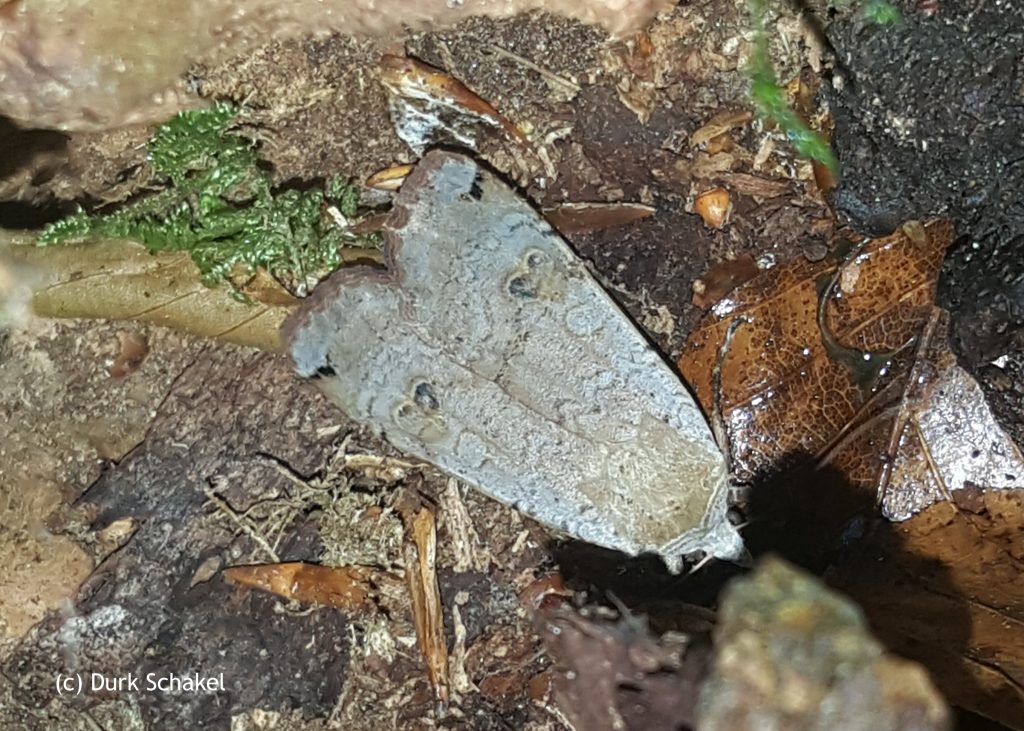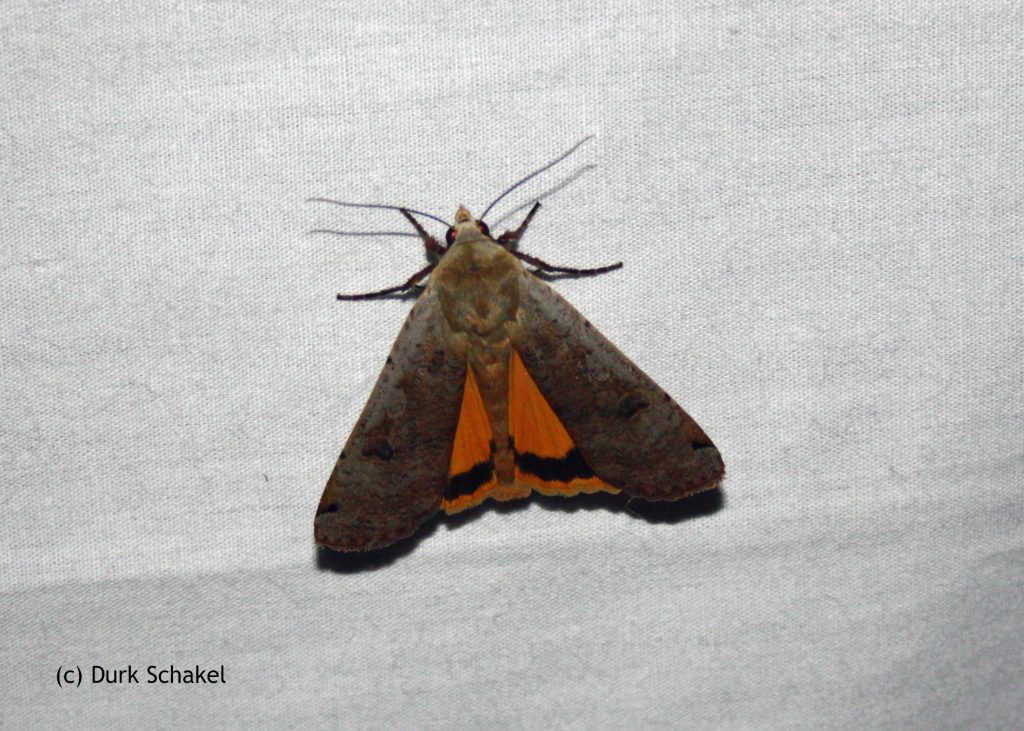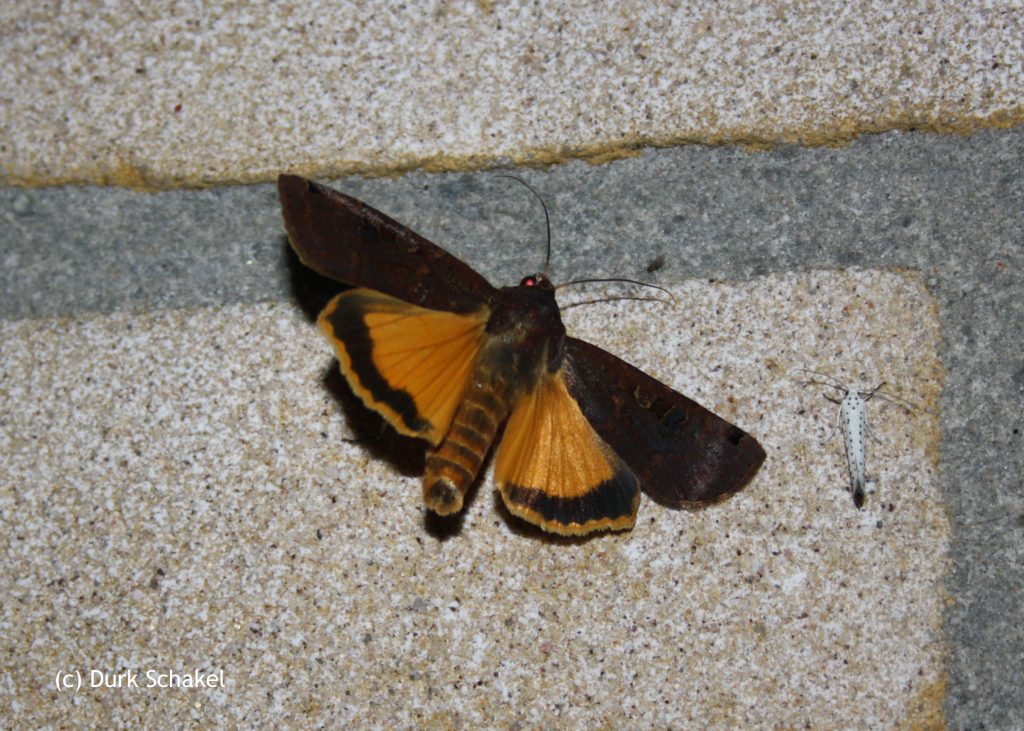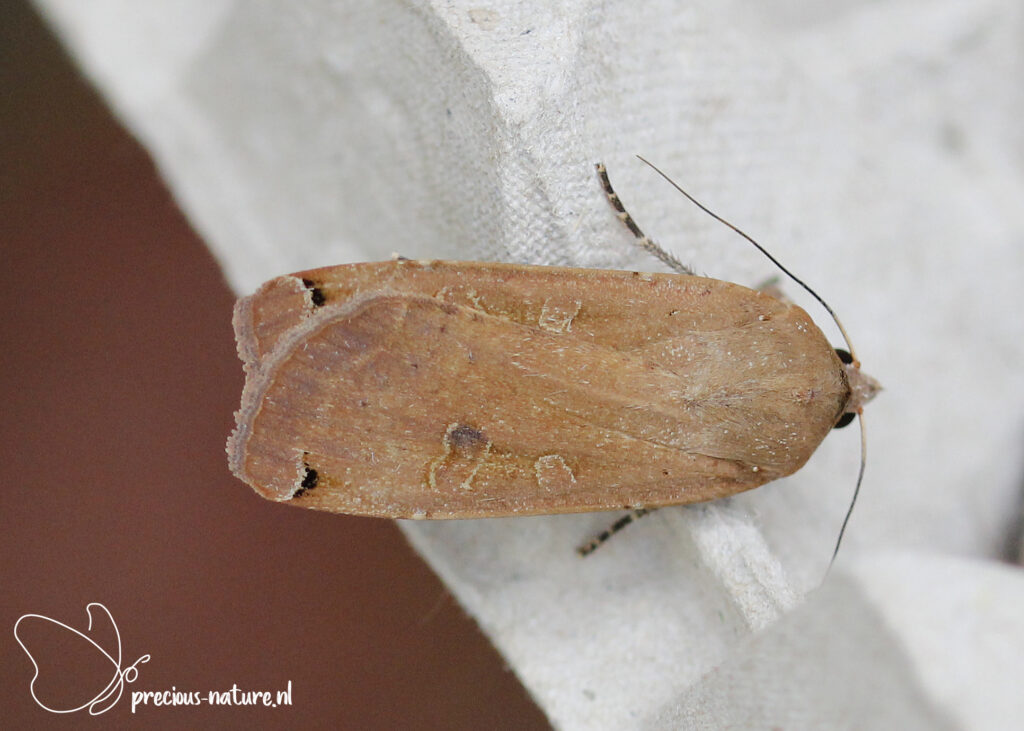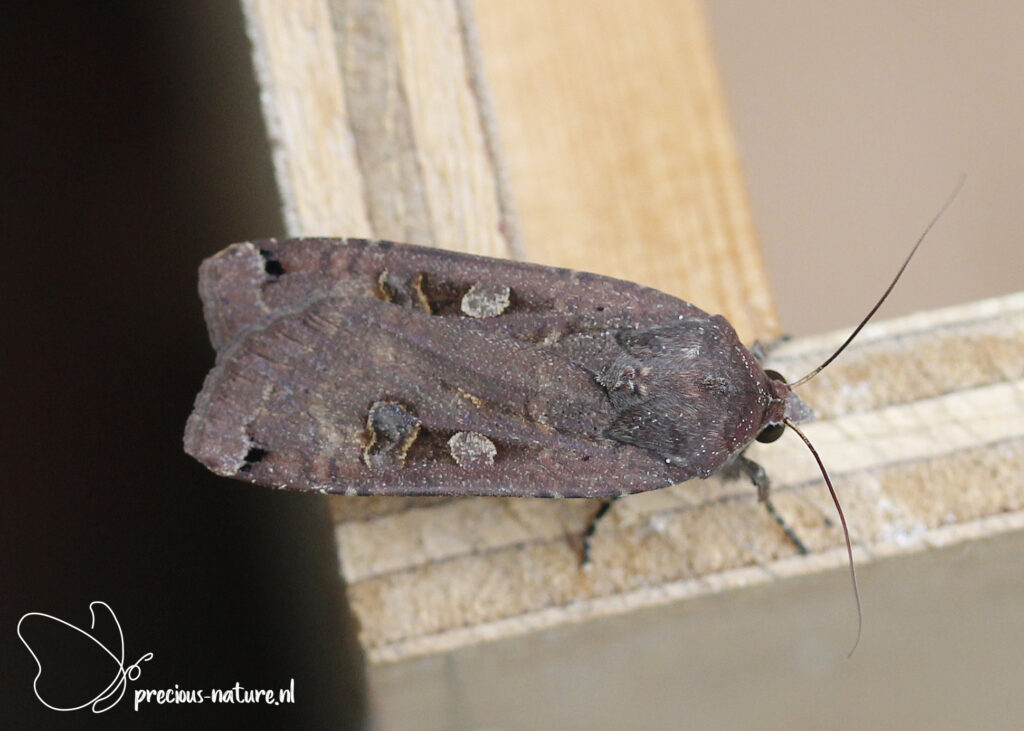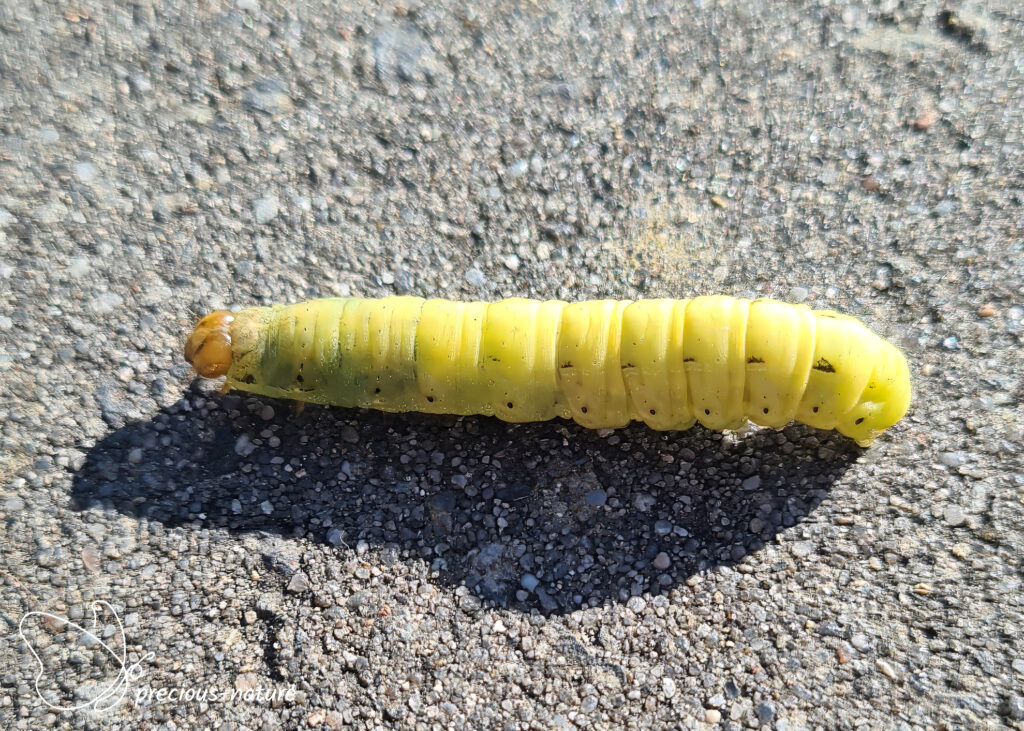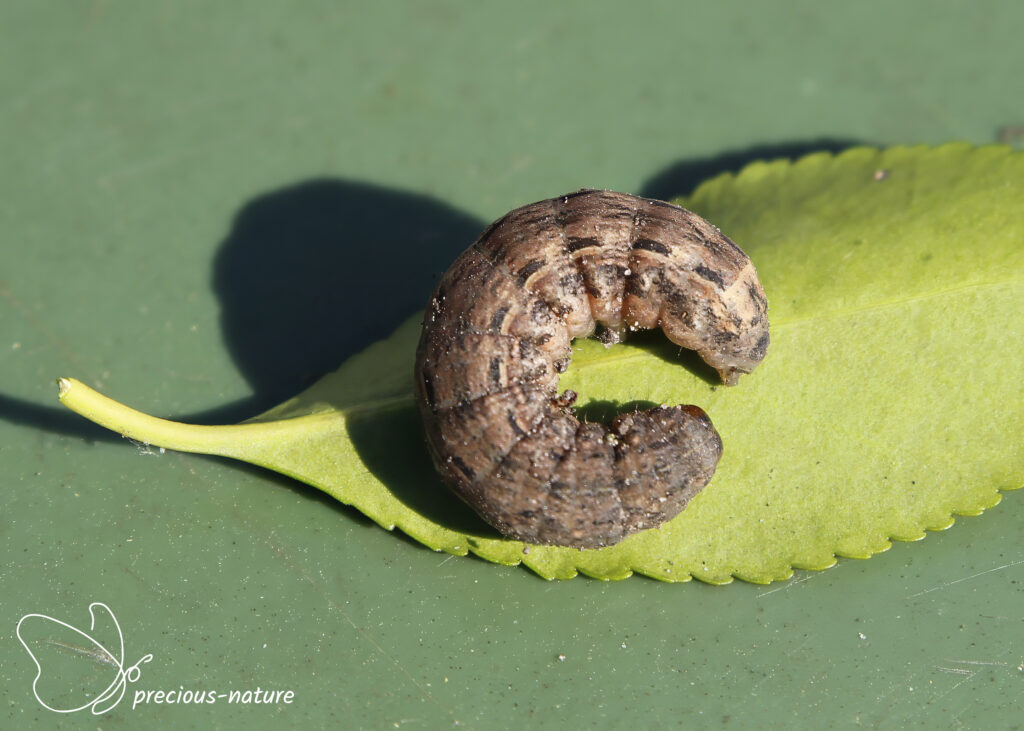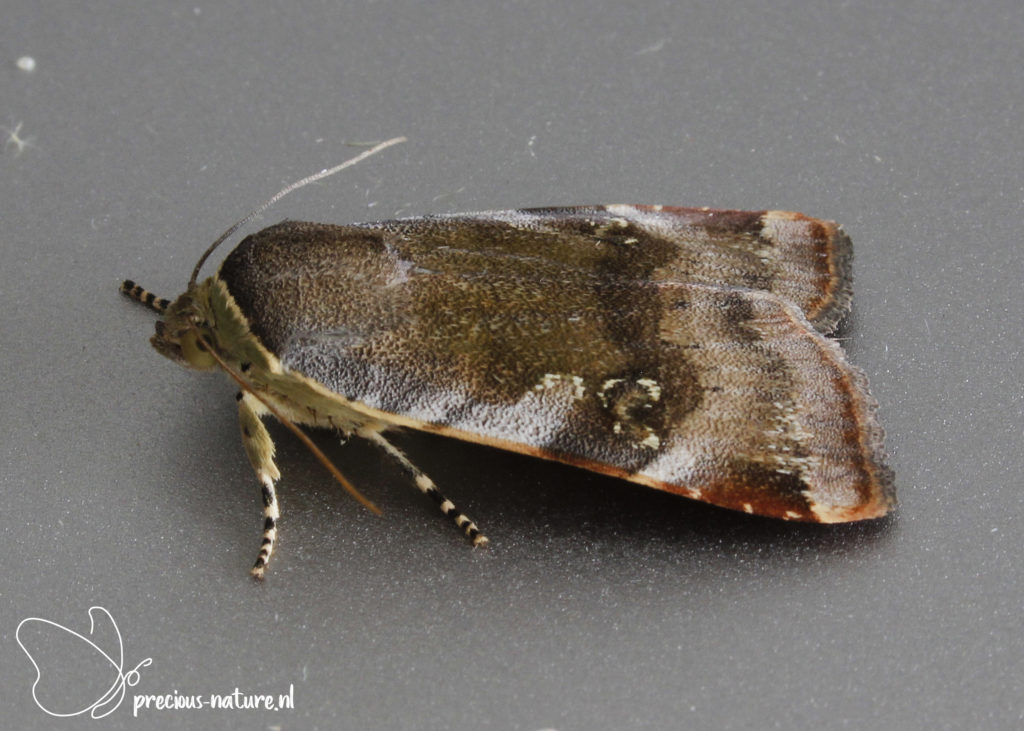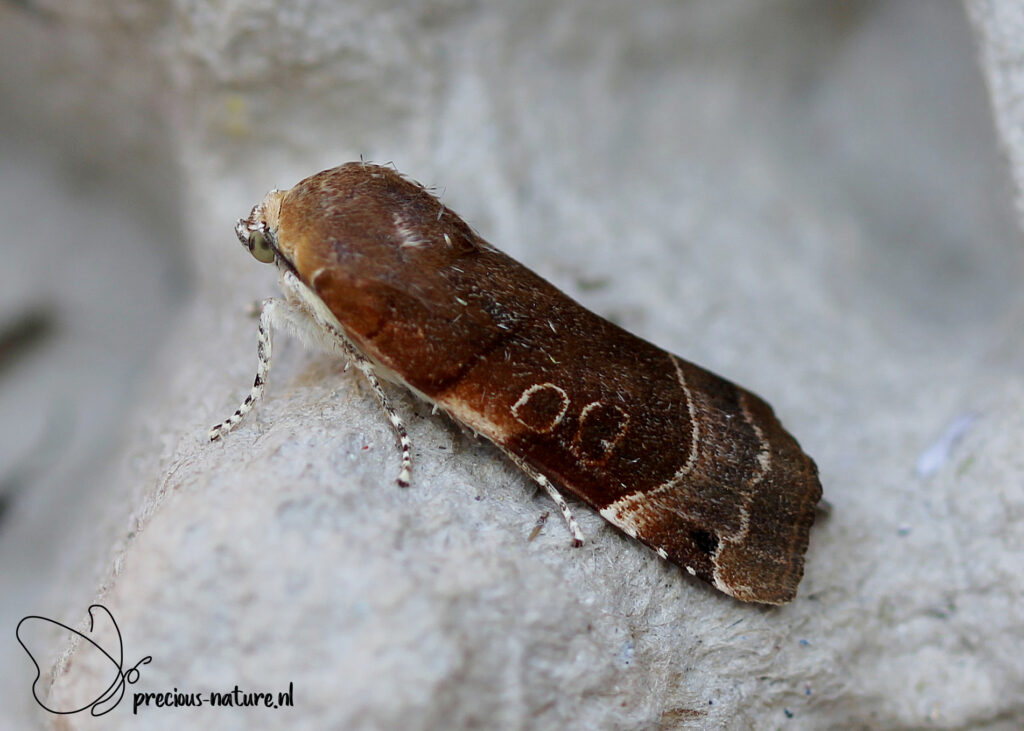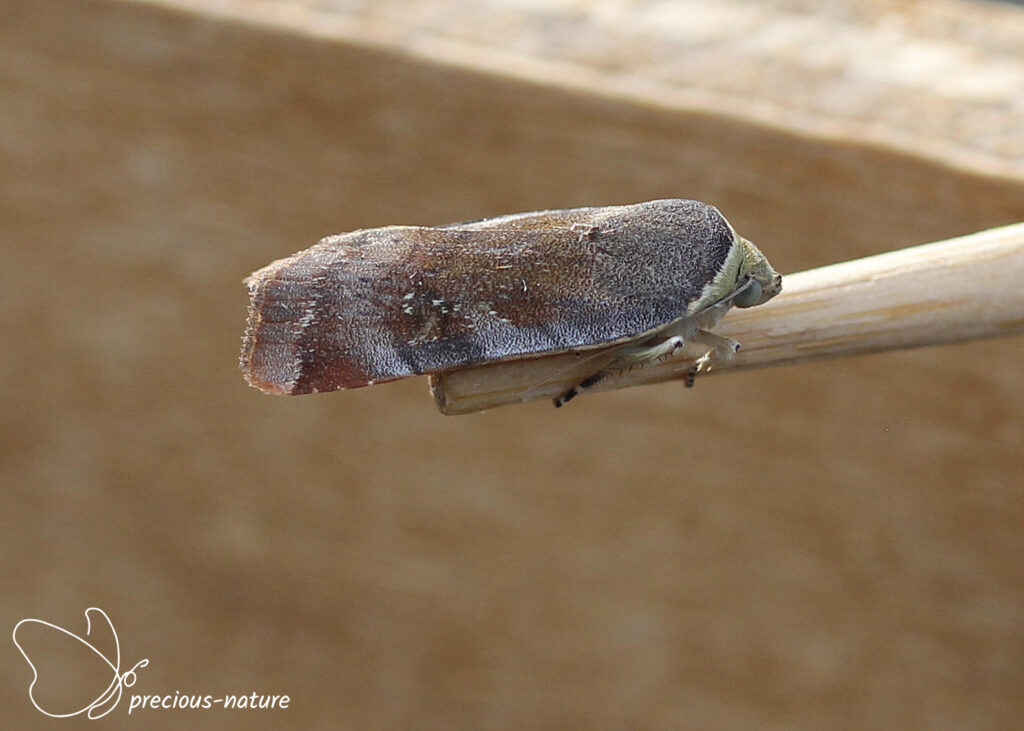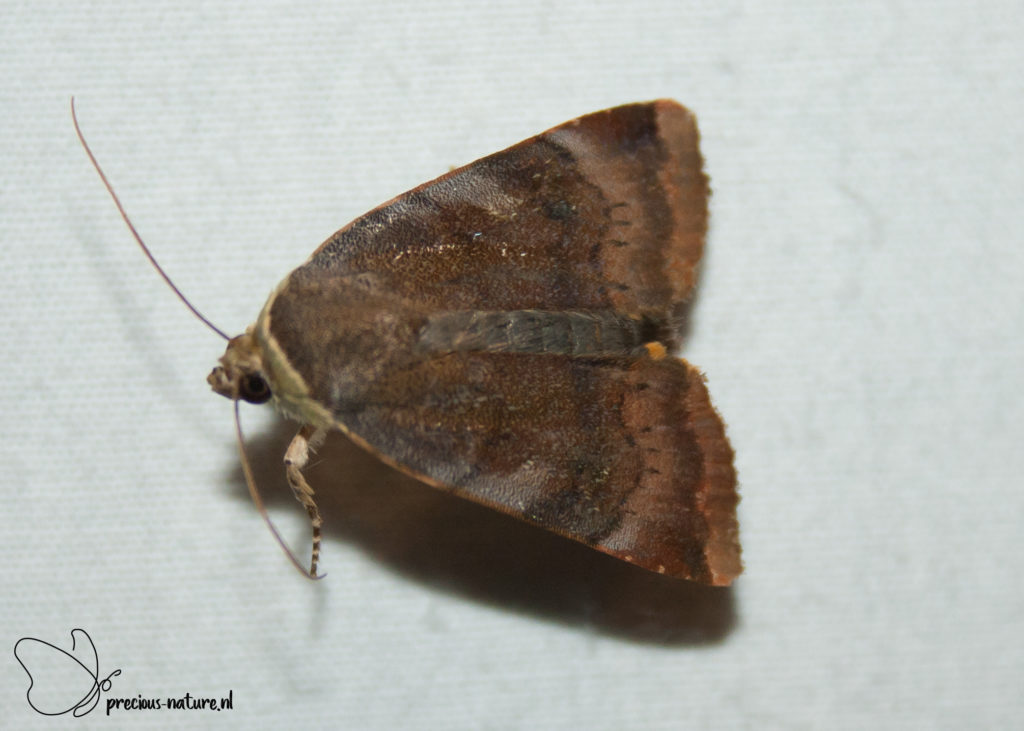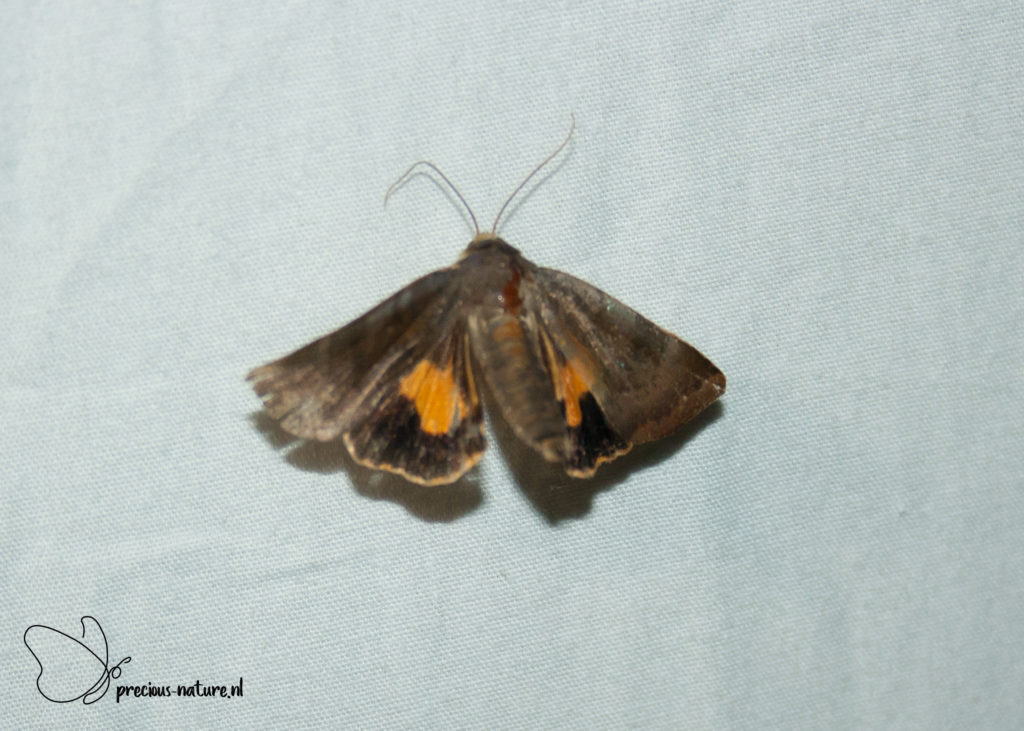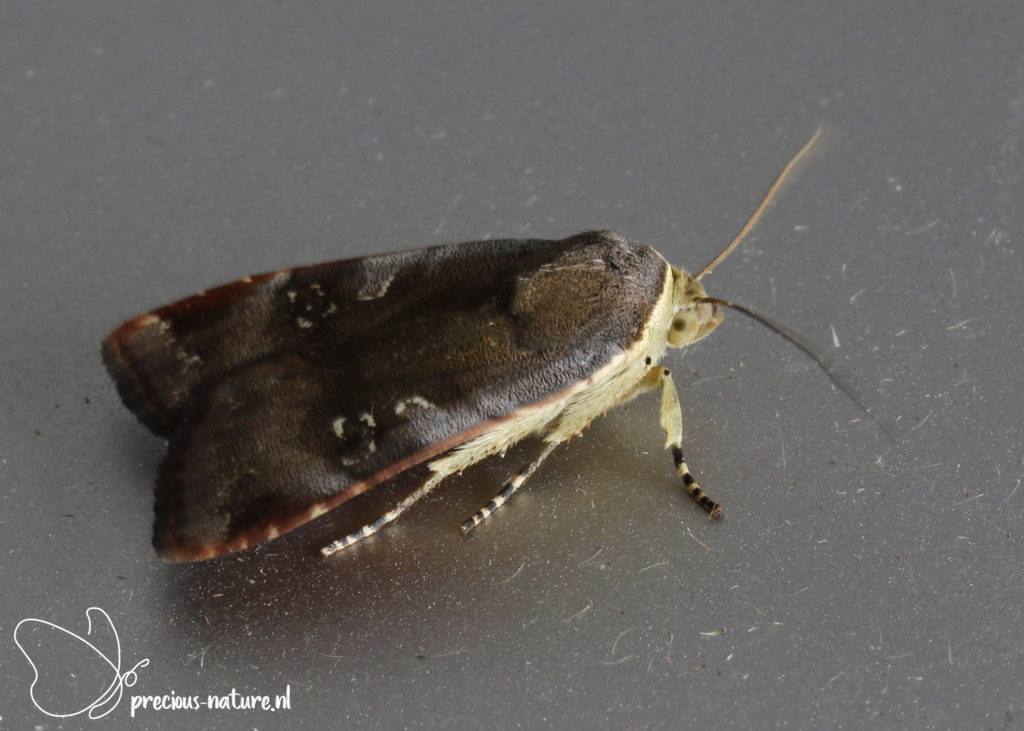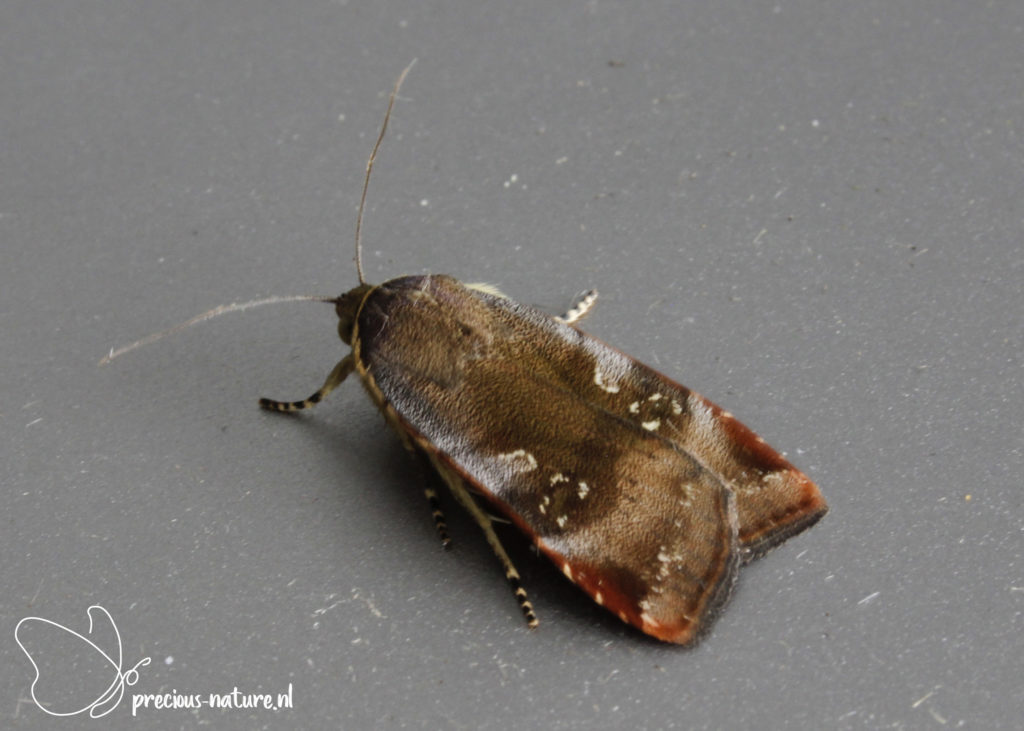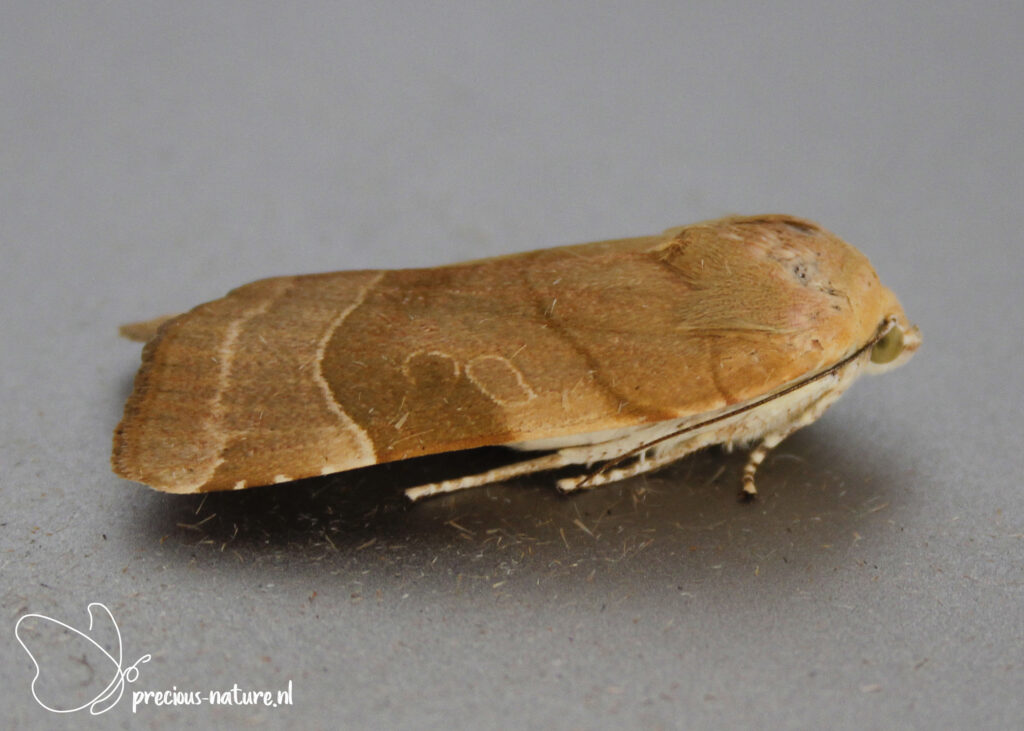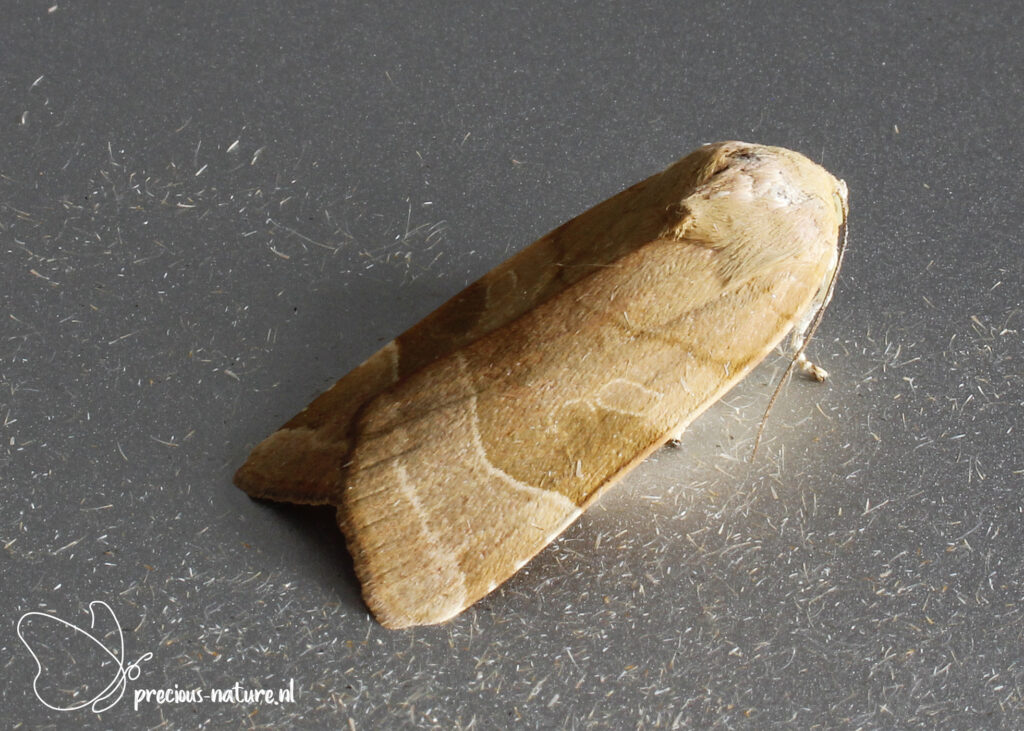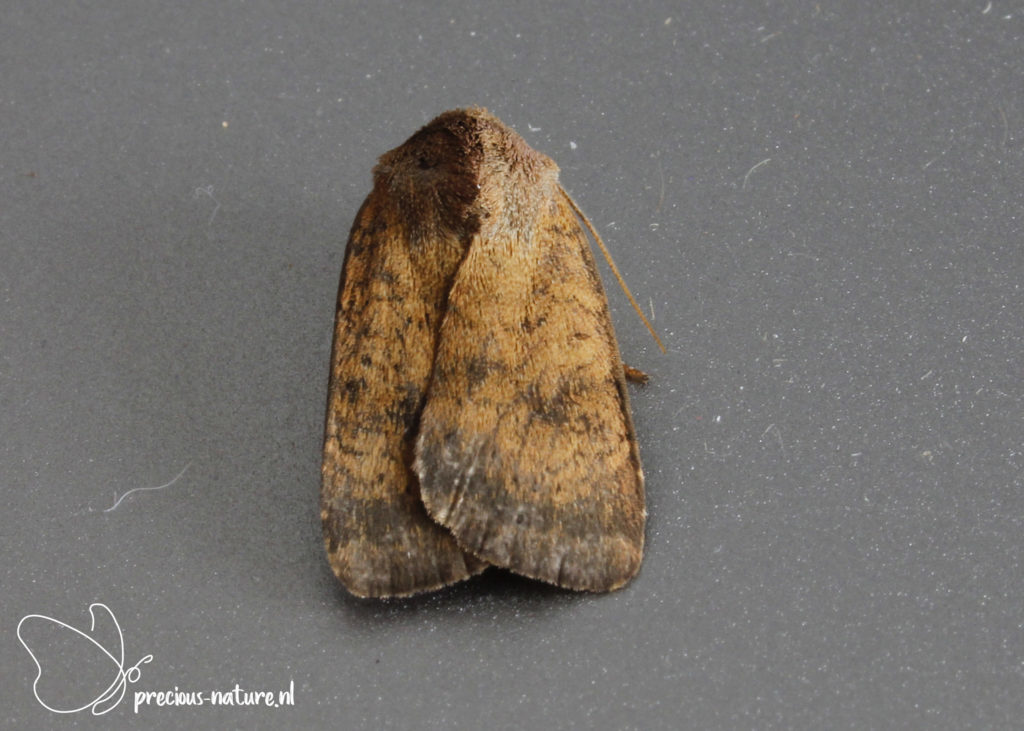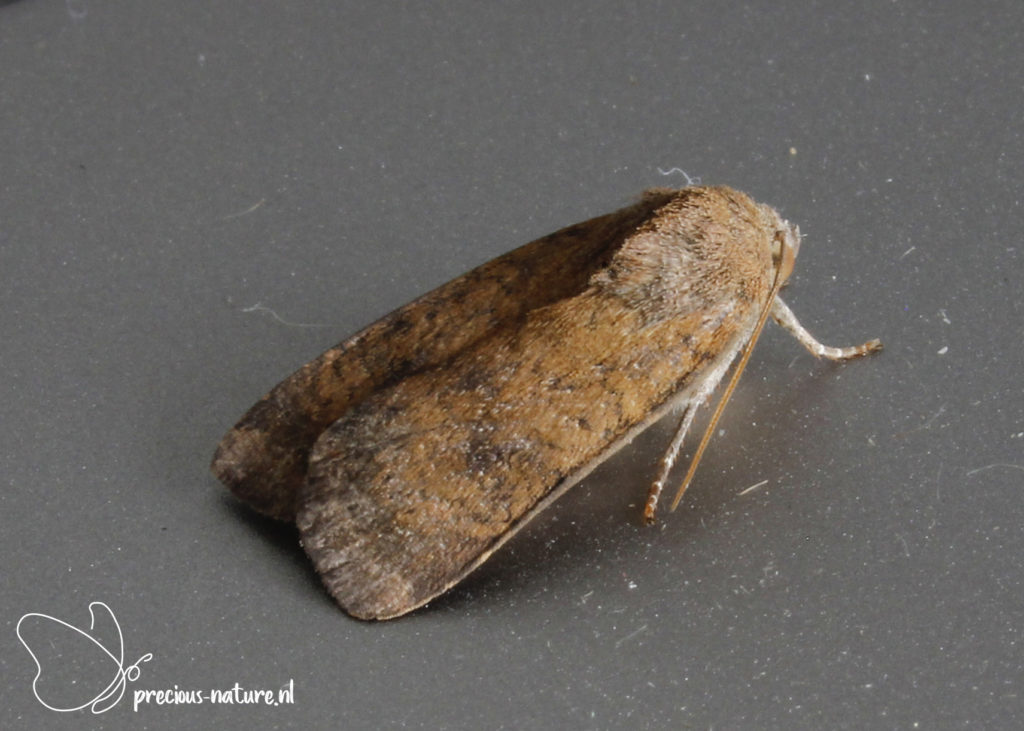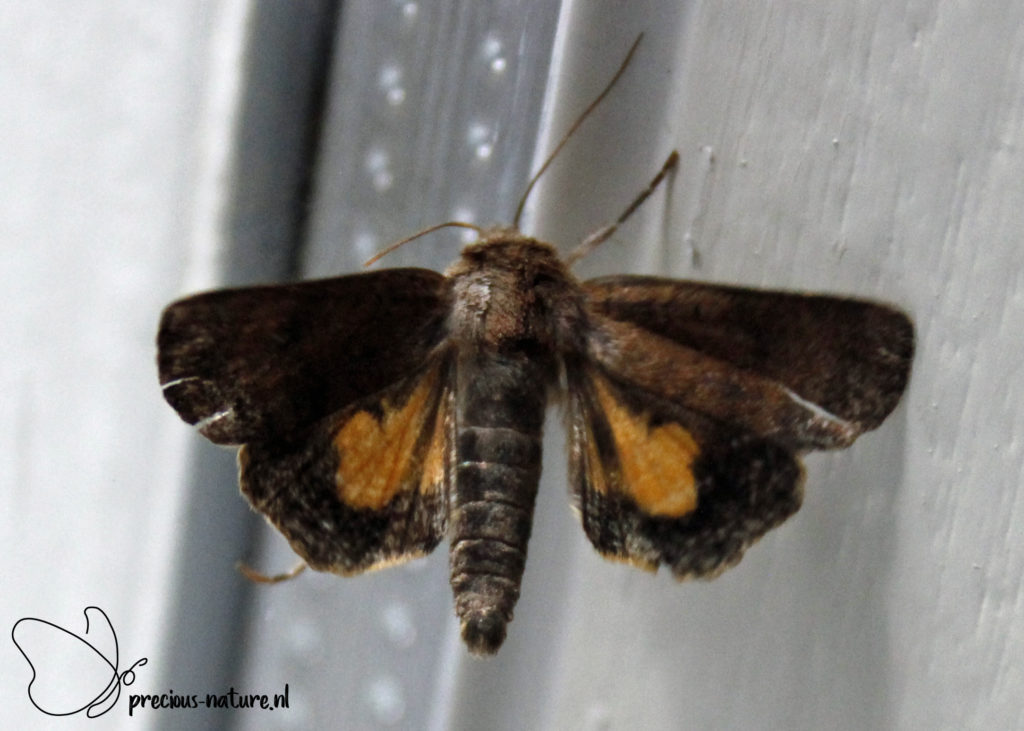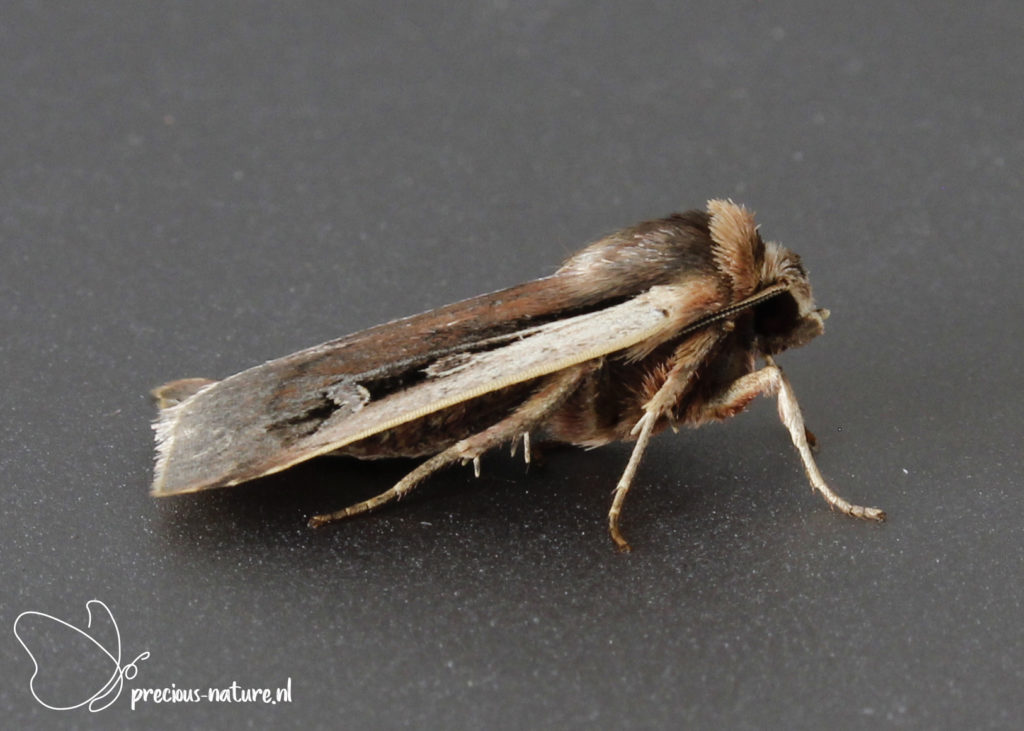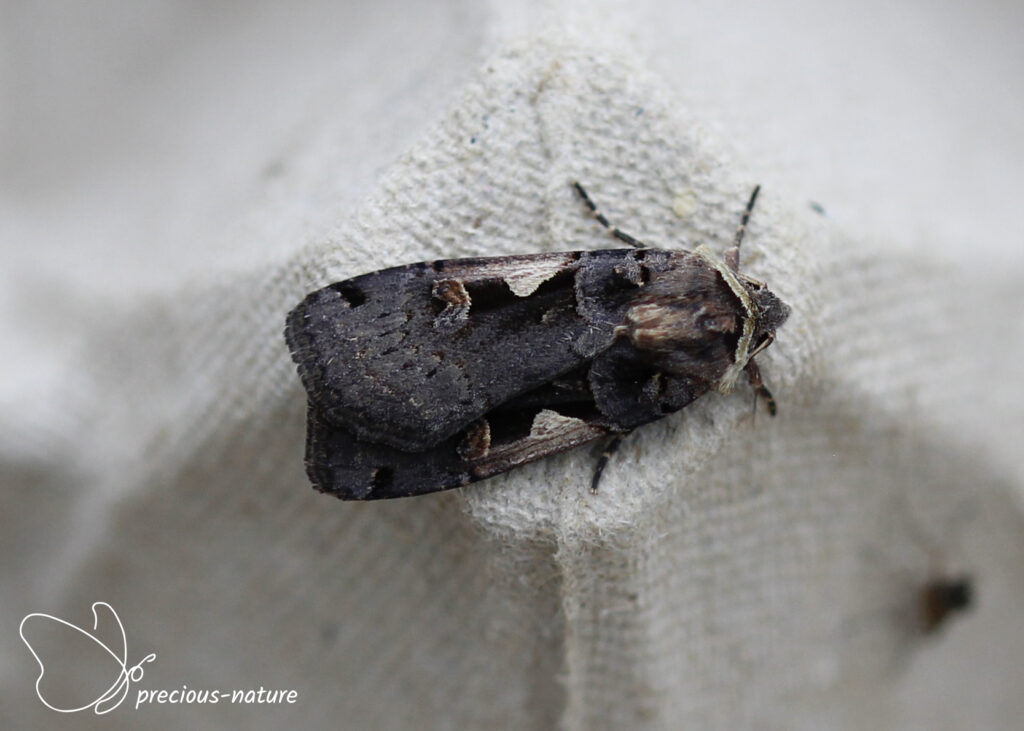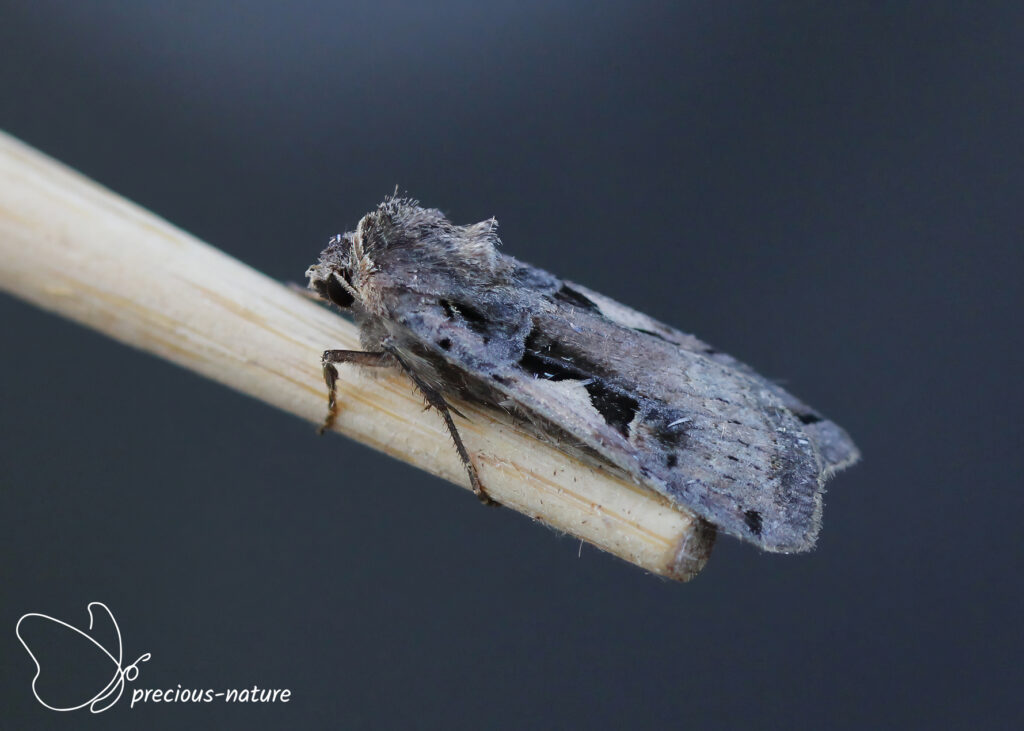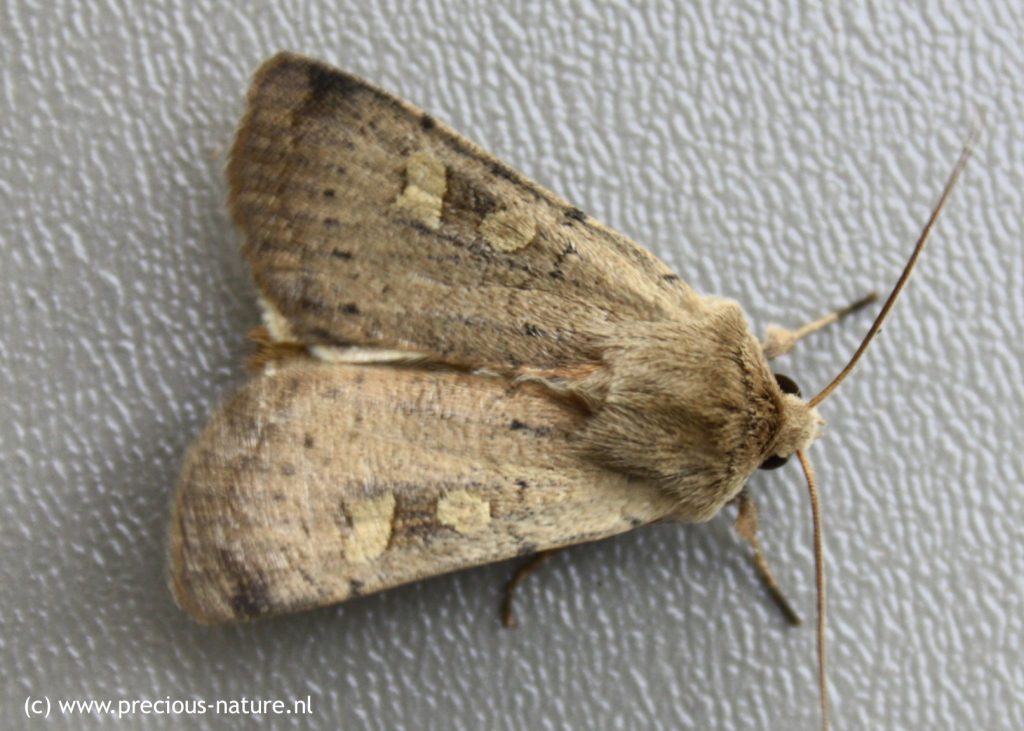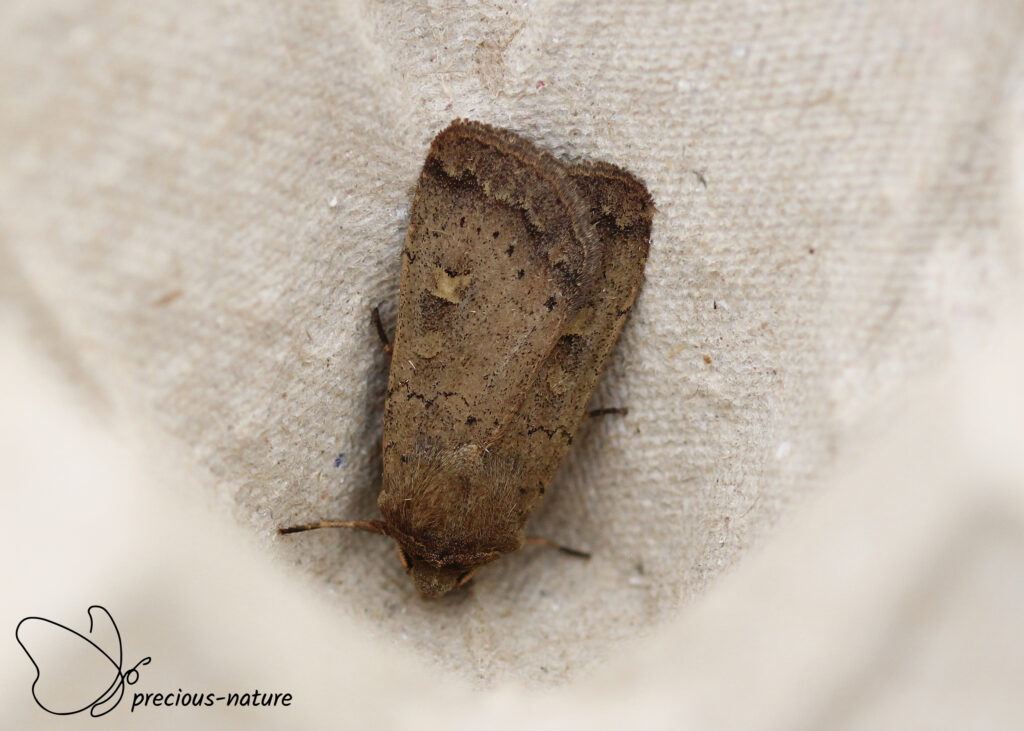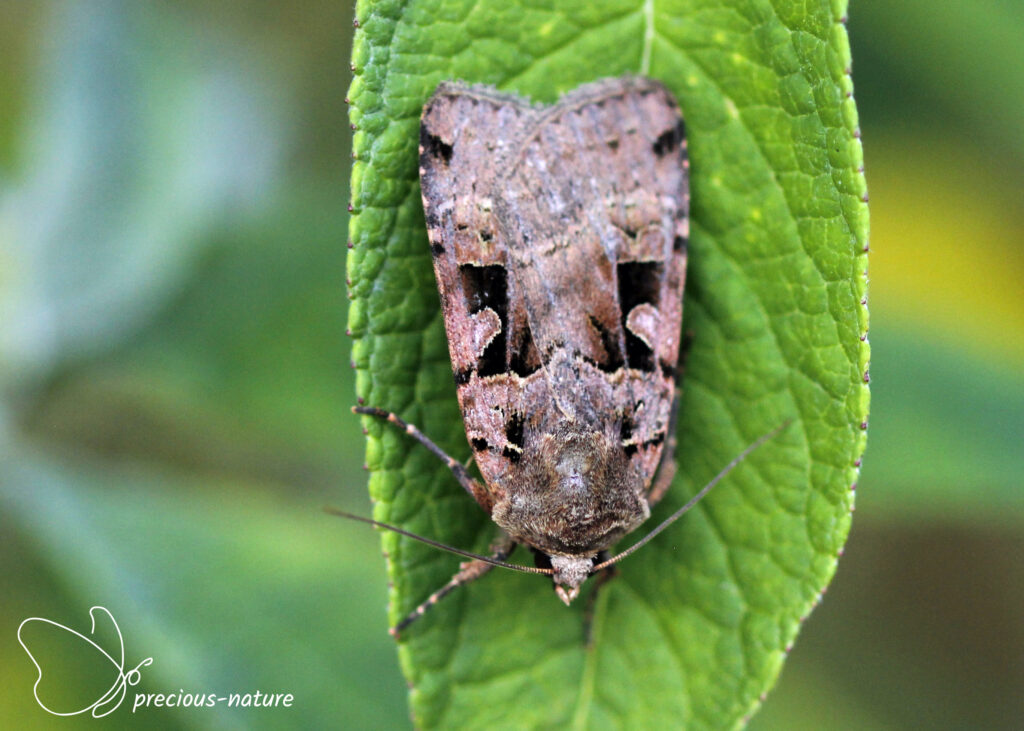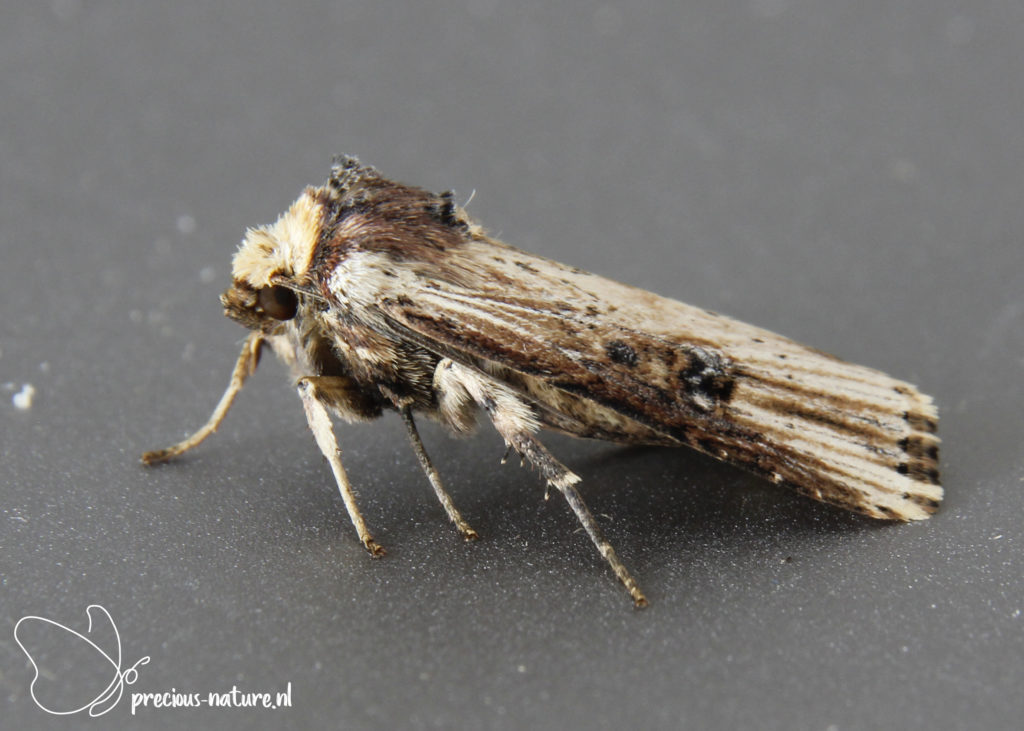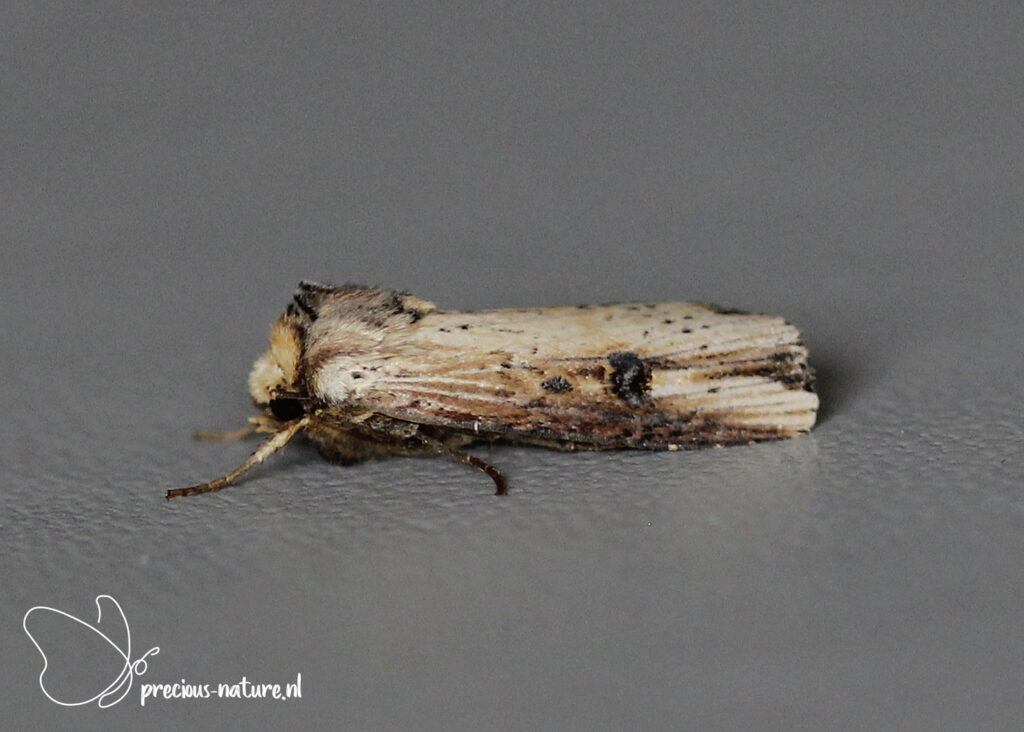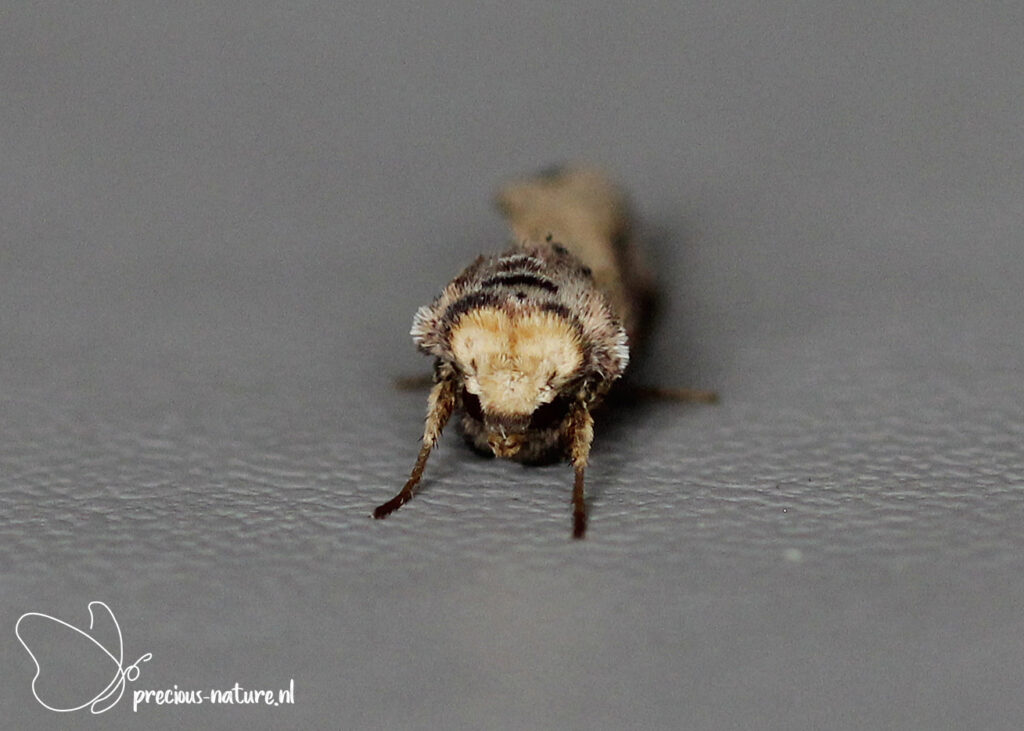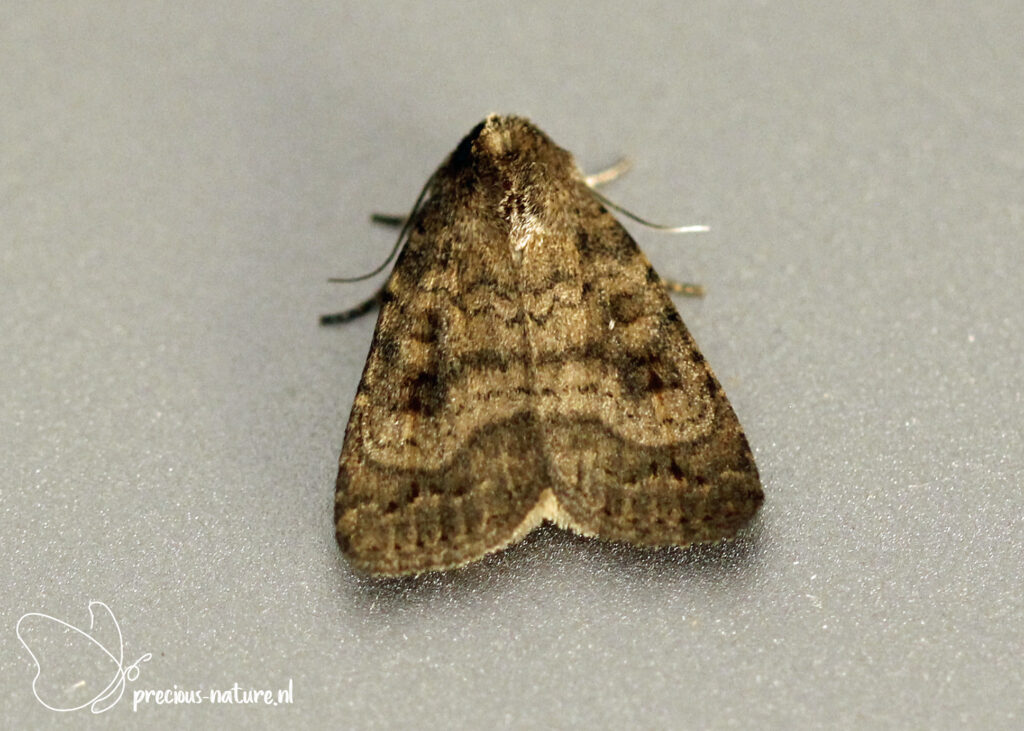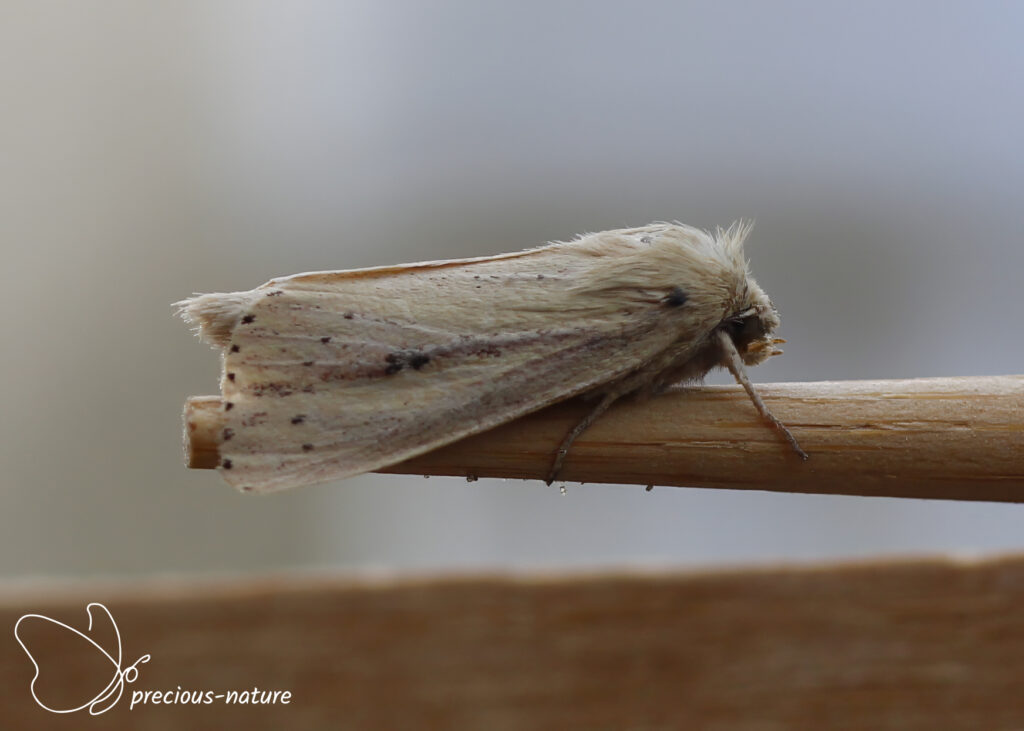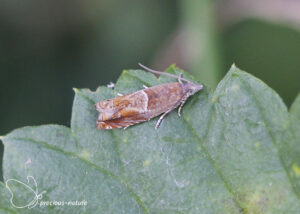Noctuinae is a subfamily of the Owlet Moths (Noctuidae). The forewing of these moths is generally rectangular. In the resting position, the wings are folded over each other above the abdomen. The head is broad and flattened and has no tufts of protruding hair.
Tribe: Apameini
Genus: Amphipoea
Saltern Ear – 2017 (NL)
(NCBI-index: 1.219315)
One of the three Amphipoea species recorded in the Netherlands is the Saltern Ear (Amphipoea fucosa). Characteristic is the large number of thin black cross lines that vary in intensity. The kidney mark is yellow, orange, or white and is noticeable. The base colour of the wings is light yellow-brown. The biotope where the species has been observed may support the determination. The Saltern Ear is mainly found in more or less moist grasslands in the coastal region and locally inland (river area). It flies in one generation from July to October, and the wingspan is 29-35 mm. Host plant: Various grasses. Dutch name: Weidevlekuil. Frisian name: Gielbrún flekûltsje.
Flying period:

Tribe: Apameini
Genus: Apamea
Dark Arches – 2008 (NL)
(NCBI-index: 875885)
The Dark Arches (Apamea monoglypha) is somewhat larger than its counterparts. The top of the forewing is grey-brown or grey-yellow, and the owl marks are visible. The oval mark is elongated and slopes upwards. In the light wave line near the termen of the forewings, a ‘W’ can be recognised, and on the top of the chest piece, there are two dark V-shaped lines. It flies in one generation from June to September, and the wingspan is 38-52 mm. Host plant: Common Couch, Cock’s-foot. Dutch name: Graswortelvlinder. Frisian name: Gerswoartelûltsje.
Flying period:

Tribe: Apameini
Genus: Apamea
Clouded-bordered Brindle – 2018 (NL)
(NCBI-index: 753153)
A variable species with two distinct colour forms is the Clouded-bordered Brindle (Apamea crenata). One colour is light yellow to brown, with a slightly red or grey tinted forewing. Striking are the dark brown, broad shoulders that run into two black stripes at the inner edge of the wing. In a resting position, the two black stripes seem to converge. Several reddish-brown spots and streaks are visible along the costa. There are also reddish-brown toothed spots on the costa. The other colour form has a reddish-brown forewing that is drawn quite smoothly and only shows the yellowish-outlined kidney and oval mark. The flight period is from the end of April to mid-July in one generation, and the wingspan is 36-44 mm. Host plant: Various grasses. Dutch name: Variabele grasuil. Frisian name: Fariabel gersûltsje.
Flying period:

Tribe: Apameini
Genus: Apamea
Small Clouded Brindle – 2019 (NL)
(NCBI-index: 689062)
A smaller Apamea species is the Small Clouded Brindle (Apamea unanimis). This owlet moth is recognisable by the always visible white border on the hollow part of the kidney mark. The forewing has a light to dark, reddish-brown or olive-brown colour and a variable, sometimes rough, marbled appearance. There are two black stripes at the base, one in the centre and one near the dorsum. The stripe in the centre and the blackish side of the shoulder form a striking, bold black smudge. On the hindwing, a clear crescent-shaped spot is missing from other Apamea species. The flight period is from early May to mid-July, and the wingspan is 30-38 mm. Host plant: Grasses, Reed-canary Grass. Dutch name: Rietgrasuil. Frisian name: –
Flying period:

Tribe: Apameini
Genus: Apamea
Rustic Shoulder-knot – 2019 (NL)
(NCBI-index: 689061)
The most characteristic of the Rustic Shoulder-knot (Apamea sordens) is the usually slightly branched black streak at the base of the forewing. The forewing is relatively broad, sand-coloured, or greyish-brown and has a pointed apex. The oval and kidney marks are pretty large, and the kidney mark is often largely or entirely outlined in white. A reddish spot can sometimes be seen in the marginal area. The flight period is from the end of April to the end of July in one generation, and the wingspan is 34-42 mm. Host plant: Various grasses, including Cock’s-foot. Dutch name: Kweekgrasuil. Frisian name: –
Flying period:

Tribe: Apameini
Genus: Apamea
Light Arches – 2021 (NL)
(NCBI-index: 987881)
The Light Arches (Apamea lithoxylaea) is a fairly light, sparsely marked owlet moth. The wings are light straw yellow and are finely drawn with dark brown to black-brown lines and dots. A pair of transverse lines, formed by small dark dots, runs across the pointed forewing. The hindwing has no transverse lines but does have an anal angle. The wing shape, the light-coloured thorax, and the lack of the transverse line on the hindwing distinguish this owlet moth from the Reddish Light Arches (Apamea sublustris). The wingspan is 43-50 mm, and the flight period is one generation from June to September. Host plant: Various grasses. Dutch name: Bleke grasworteluil. Frisian name: –
Flying period:

Tribe: Apameini
Genus: Helotropha
The Crescent – 2018 (NL)
(NCBI-index: 987462)
The first specimen I spotted of the Crescent (Helotropha leucostigma) was a bit of a puzzle because it was already a somewhat faded specimen. This owlet moth’s costa and termen form a somewhat right angle. The top of the forewing is chocolate brown or reddish, and the kidney mark is quite strikingly white. Some specimens are drawn quite smoothly, but some specimens show clearly veined white veins, as with my first specimen. In addition, a remarkably light band can often be seen in the marginal area, the inner edge of which is straight. This owlet moth flies in one generation from June to early October, and the wingspan is 37-44 mm. Host plant: Yellow Flag. Dutch name: Gele lis-boorder. Frisian name: Barchjeblomboarder.
Flying period:

Tribe: Apameini
Genus: Hydraecia
Rosy Rustic – 2018 (NL)
(NCBI-index: 214171)
With the bluish light of the UV lamp that I use when attracting moths, you sometimes do not see everything. I often shine a flashlight to see if I am dealing with a new species. Then you suddenly notice a Rosy Rustic (Hydraecia micacea) sitting unobtrusively on a yellow brick that holds the canvas in place. This yellow-coloured, sometimes pinkish-brown, owlet moth has two dark central transverse lines on the front wing. The inner is irregular and has a striking kink at the dorsum. The outer transverse line runs diagonally across the wing and sharply turns at the costa towards the base. The part between the two transverse lines is darker than the rest of the wing. The oval and kidney marks are darkly rimmed. The flying period is one generation, from July to November. The wingspan is 28-45 mm. Host plant: Various low plants like Dock. Dutch name: Aardappelstengelboorder. Frisian name: –
Flying period:

Tribe: Apameini
Genus: Lateroligia
Double-lobed – 2020 (NL)
(NCBI-index: 688364)
The Double Lobed (Lateroligia ophiogramma, alternatively Apamea ophiogramma) is a slender-built owlet moth with a sand-colored or light reddish-brown forewing. Characteristics include the reddish-brown to dark brown field along the coast. The field consists of oval and light-coloured kidney marks and ends in a broad, black-edged lob that runs into the midfield. There are sometimes specimens that are almost entirely dark brown, but the dark lob is also clearly visible in these forms. The wingspan is 32-35 mm, and the flight period runs from June to mid-August for one generation. Host plant: Reed grass, Grain grass. Dutch name: Moeras-grasuil. Frisian name: Sompegersûltsje.
Flying period:

Tribe: Apameini
Genus: Luperina
Flounced Rustic – 2020 (NL)
(NCBI-index: 988174)
The Flounced Rustic (Luperina testacea) is an owlet moth variable in size, width, and colour. The drawing on the forewing is pretty constant. The kidney and oval marks are usually partially black-edged, and the black median lines mark the dark midfield. The colour of the forewing varies from dull straw-coloured, through light and dark brown to blackish brown, usually with a slight speckling. The hindwing is white or sometimes grey and slightly translucent, showing the light brown veins. The wingspan is 30-35 mm, and the flight period runs from July to early October for one generation. Host plant: Various grasses. Dutch name: Gewone grasuil. Frisian name: Gewoane gersûltsje.
Flying period:

Tribe: Apameini
Genus: Mesapamea
Common Rustic – 2017 (NL)
(NCBI-index: 988129)
An owlet moth with many variations in colour, from light to dark, is the Common Rustic (Mesapamea secalis). The forewing has a rounded back edge and a blunt apex. The kidney mark, sometimes predominantly white to cream-coloured, has a clear white outline. The median lines vary in intensity and are sometimes connected by a black stain. Some specimens have a relatively recognisable and even appearance, while others are blotchy. It is almost indistinguishable from the Lesser Common Rustic (Mesapamea secalella). Very dark specimens with a chalk-white kidney mark usually belong to the Lesser Common Rustic, and on average, this species is slightly smaller. Specimens with a pronounced white marking on the forewing always belong to the Common Rustic. In most cases, genitalia research is needed. The flying period spans one generation, from May to September, and the wingspan ranges from 24 to 32 mm. Host plant: Cock’s-foot, Tall Fescue, Tufted Hair-grass, and cereal crops. Dutch name: Halmrupsvlinder. Frisian name: –
Flying period:

Tribe: Apameini
Genus: Oligia
Tawny Marbled Minor – 2018 (NL)
(NCBI-index: 988008)
The Tawny Marbled Minor (Oligia latruncula) is very similar to the other species in its family. It is often smaller, dark, and grey to blackish, with the wide band in the marginal area having a brown to coppery colour. The chest piece usually shows no orange or reddish tufts of hair. The apex can be brownish but also light grey or light brown. The white, wavy line, which borders the dark median band, is very noticeable against the lighter ones. The flight period is from mid-May to August, and the wingspan is 24-27 mm. Host plant: A variety of grasses. Dutch name: Donker halmuiltje. Frisian name: –
Flying period:

Tribe: Apameini
Genus: Oligia
Marbled Minor – 2018 (NL)
(NCBI-index: 988009)
The Marbled Minor (Oligia strigilis), like the other minors, is very variable and difficult to distinguish from the other species in its family. The drawn copies are best distinguished because of their black bar between the two central transverse lines and the rather light band in the zoom field. It features an orange tuft on the top of the chest piece, a characteristic design element. Furthermore, the multi-incised, vigorous and lobed inner edge of the light band in the zoom field is characteristic. The notches are visible as thin black stripes on the veins in the marginal area. The most noticeable lob is chalk white and is closest to the dorsum. When in doubt, genitals should provide a solution. The flight period is one generation, from May to the end of August, and the wingspan is 22-25 mm. Host plant: Various grasses. Dutch name: Gelobd halmuiltje. Frisian name: –
Flying period:

Tribe: Apameini
Genus: Oligia
Middle-barred Minor – 2019 (NL)
(NCBI-index: 1.870138)
The Middle-barred Minor (Oligia fasciuncula) is best recognised among the minors. The ground colour of the top of the forewing is yellow-brown to orange-brown. The dark median band is most characteristic, bordered by white-lined transverse lines. The oval and kidney marks are light-coloured and not noticeably edged. The flying period is one generation, from May to July, and the wingspan is 22-26 mm. Host plant: Various grasses. Dutch name: Oranjegeel halmuiltje. Frisian name: Oranjegiel halmûltsje.
Flying period:

Tribe: Apameini
Genus: Rhizedra
Large Wainscot – 2018 (NL)
(NCBI-index: 988156)
The Large Wainscot (Rhizedra lutosa) is a reasonably large owlet moth. The narrow, tapering forewing often has a sharp, sometimes slightly bent apex. The base colour ranges from straw grey or light greyish brown to light reddish-brown. A grey or blackish pollination is often present on the wing. A light vein is visible on the forewing, and a small dark core is present on the almost invisible kidney mark. The post-median line consists of a row of dark dots. The chest piece often has a delicate, comb-like median line. The flying period spans one generation, from late July to November, and the wingspan ranges from 42 to 50 mm. Host plant: Common reed. Dutch name: Herfstrietboorder. Frisian name: Hjerstreidboarder.
Flying period:

Tribe: Noctuini
Genus: Agrotis
Heart and Dart – 2015 (NL)
(NCBI-index: 215162)
The Heart and Dart (Agrotis clavis) has a light brown to dark brown ground colour. On the forewing, you can always see a striking dark dart mark in the longitudinal direction of the veins. The owl marks are coloured darker than the ground colour and are recognisable. It flies in two generations from May to October, and the wingspan is 30-38 mm. Host plant: Ribwort Plantain, Fat-hen. Dutch name: Gewone worteluil. Frisian name: Gersûltsje.
Flying period:

Tribe: Noctuini
Genus: Agrotis
Shuttle-shaped Dart – 2017 (NL)
(NCBI-index: 1.857961)
The Shuttle-shaped Dart (Agrotis puta) has a light oval mark on the forewing with a dark core. The male has a light brown forewing, and the kidney mark is difficult to see. The oval mark does stand out clearly. The female has a much more dark-coloured forewing. It flies in two generations from April to October, and the wingspan is 30-32 mm. Host plant: Sorrel, Dandelion, and lettuce. Dutch name: Puta-uil. Frisian name: Putaûltsje.
Flying period:

Tribe: Noctuini
Genus: Agrotis
Dark Sword-grass – 2018 (NL)
(NCBI-index: 56364)
An easily recognisable owlet moth is the Dark Sword-grass (Agrotis ipsilon). Characteristic is the elongated, black, arrow-shaped streak outside the kidney mark. This streak extends far into the costal area and sometimes touches the more minor arrow spots on the inside of the wave line. In a resting position, the wings are folded over each other, creating a narrow and long impression. The wings vary in colour from light to dark brown, with the light specimens having a dark streak along the front edge. The flight period spans from April to October, occurring in two generations, and the wingspan ranges from 35 to 50 mm. Host plant: Various herbaceous plants, grasses, and vegetables. Dutch name: Grote worteluil. Frisian name: Grutte woartelûle.
Flying period:

Tribe: Noctuini
Genus: Agrotis
Heart and Club – 2024 (NL)
(NCBI-index: 997525)
The ground colour of the rather blunt forewing of the Heart and Club (Agrotis clavis) varies from very light brown or greyish light brown with dark brown spots to almost entirely dark brown or even almost black. The lighter forms often have a forewing with a dark leading edge. The dart mark is oval and not filled. You can see a light stripe in the dart mark. Around the owl marks are often fine black scales that give the impression that the black edging of the owl marks has run out or has faded. The hindwing of the male is light to dark grey, and that of the female is dark grey with a central spot. The flight period is from mid-May to the end of July in one generation, and the wingspan is 35-40 mm. Host plant: Dandelion, Sorrel, Clover. Dutch name: Geoogde worteluil. Frisian name: –
Flying period:
![]()
Tribe: Noctuini
Genus: Diarsia
Small Square-spot – 2017 (NL)
(NCBI-index: 987925)
The Small Square-spot (Diarsia rubi) has a reddish glow (rubi = red) over the top of the forewing. The wing also has a reddish-brown or dark-brown band and speckling. The post-median line is edged on the outside with a dark line that gradually merges into a lighter zone. Between the kidney and the oval mark is a dark square spot. The flight period is from May to October in two generations, and the wingspan is 28-33 mm. Host plant: Dandelion, Sorrel, Foxglove. Dutch name: Gewone breedvleugeluil. Frisian name: Gewoan breedwjukûltsje.
Flying period:

Tribe: Noctuini
Genus: Noctua
Large Yellow Underwing – 2008 (NL)
(NCBI-index: 214277)
The Large Yellow Underwing (Noctua pronuba) is very variable in colour but a characteristic owlet moth with a long, narrow, rounded forewing. The colour of the forewing can vary from red-brown to black-brown with slight marking to light brown with light brown or grey marbling. There is a black spot where the wave line touches the costa. The hindwing is orange with a narrow black dorsum. The kidney and oval marks are visible. It flies at night in one generation from June to October, and the wingspan is 42-52 mm. During the day, they are hidden in low bushes or plants. Host plant: Dock, Marigolds, Foxglove, Annual Meadow-grass. Dutch name: Huismoeder. Frisian name: Tsjoenster.
Flying period:

Tribe: Noctuini
Genus: Noctua
Lesser Broad-bordered Yellow Underwing – 2017 (NL)
(NCBI-index: 987995)
The Lesser Broad-bordered Yellow Underwing (Noctua janthe) is difficult to distinguish from the Langmaid’s Yellow Underwing (Noctua janthina). This is especially the case in the resting position. The difference between the two is best seen in the yellow hindwing. This owlet moth has a purple or reddish-brown forewing with a dark transverse band that turns into a light zone. The owl marks are barely visible. The legs are coloured in a light, solid colour, with black rings in part. The flight period ranges from June to September, and the wingspan is 30-40 mm. Host plant: White Dead-nettle, Broad-leaved Dock, Scentless Mayweed. Dutch name: Open-breedbandhuismoeder. Frisian name: Iepenbreedbântsjoenster.
Flying period:

Tribe: Noctuini
Genus: Noctua
Lunar Yellow Underwing – 2017 (NL)
(NCBI-index: 1.858045)
The Lunar Yellow Underwing (Noctua orbona) is very similar to the Lesser Yellow Underwing (Noctua comes), which has a broader forewing. The Lunar Yellow Underwing has a delimited black spot on the primarily greyish-brown forewing close to the apex. This black spot is missing from the Lesser Yellow Underwing. The orange-yellow hindwing has a dark moon-shaped median spot, and a narrow black band runs along the termen. Often against the costa of the forewing, just below the kidney mark, there is a small dark spot with a whitish spot next to it. The flying period spans one generation, from May to September, and the wingspan ranges from 38 to 45 mm. Host plant: Various grasses and herbaceous plants. Dutch name: Zwartpuntvolgeling. Frisian name: Swartpuntfolgeling.
Flying period:

Tribe: Noctuini
Genus: Noctua
Langmaid’s Yellow Underwing – 2019 (NL)
(NCBI-index: 987996)
For the identification of the Yellow Underwings, it is essential to take a look at the top of the hindwings. They are very characteristic and allow you to identify the correct species. For the Langmaid’s Yellow Underwing (Noctua janthina), I was lucky enough to take a picture at the right time. This owlet moth is smaller than its relatives and has a purple or reddish forewing that sometimes looks blue-grey. The markings on the forewing are relatively difficult to see. You often see a clear banding. The most characteristic is the hindwing, which is ocher yellow with a large dark spot at the base of the wing and a very wide blackish band along the termen, which are joined together along the costa. You usually see black veins in the more or less enclosed round or oval orange field in between. The flying period is one generation, from late June to September, and the wingspan is 35 mm. Host plant: Various herbaceous plants. Dutch name: Kleine breedbandhuismoeder. Frisian name: Lytse broadbântsjoenster.
Flying period:

Tribe: Noctuini
Genus: Noctua
Broad-bordered Yellow Underwing – 2020 (NL)
(NCBI-index: 753202)
You should always focus on the hindwing to recognise the yellow underwing species and ensure correct identification. This is not immediately necessary for the Broad-bordered Yellow Underwing (Noctua fimbriata). The colour of the top of the forewing is variable, but the drawing is fairly constant. The male’s forewing is reddish-brown to olive green, and in the female, it is light brown, light green, or reddish-brown. The transverse lines are imperforate, and a broad black seam runs along the back edge of the orange-yellow hindwing. The white legs are ringed black and white at the end. The wingspan is 45-55 mm, and the flight period is from June to October for one generation. Host plant: Common Nettle, Sorrel, Birch, Blackberry, Privet, Willow. Dutch name: Breedbandhuismoeder. Frisian name: Breedbântsjoenster.
Flying period:

Tribe: Noctuini
Genus: Noctua
Least Yellow Underwing – 2021 (NL)
(NCBI-index: 987993)
The smallest Noctua species in the Netherlands is the Least Yellow Underwing (Noctua interjecta). The forewing is a striking warm orange-brown to reddish-brown. The various lines and owlet markings are barely visible, of which the inner lobe of the kidney mark is most clearly visible. The hindwing is orange-yellow with a broad dark brown band and a moon-shaped dark centre spot that sometimes coincides with the dark band. The dark centre spot is sometimes more visible on the underside of the wing than on the top. The wingspan is 31-36 mm, and the flight period is one generation from June to October. Host plant: Herbaceous plants. Dutch name: Kleine huismoeder. Frisian name: Lytse tsjoenster.
Flying period:

Tribe: Noctuini
Genus: Ochropleura
Flame Shoulder – 2017 (NL)
(NCBI-index: 320037)
The Flame Shoulder (Ochropleura plecta) is most noticeable because of its yellow-colored broad streak along the costa. A black streak is right next to this light streak, and the rest of the wing is dark brown. The owl marks are noticeable because of the white outline. On the head is a striking light brown hair tuft. The flight period is from April to October in two or three generations, and its wingspan is 24-30 mm. Host plant: Bedstraws, docks, Groundsel, Ribwort Plantain. Dutch name: Haarbos. Frisian name: Hierbosk.
Flying period:

Tribe: Noctuini
Genus: Xestia
Setaceous Hebrew Character – 2017 (NL)
(NCBI-index: 987431)
The striking, straw-yellow triangular spot along the costa of the forewing easily recognises the Setaceous Hebrew Character (Xestia c-nigrum). A black spot in the form of an angular ‘C’ adjoins this light spot. The collar of this owlet moth is also straw yellow. The rest of the forewing is dark grey. The hindwing is white and has a grey speckling along the termen. It flies in two generations from April to the end of November, and the wingspan is 28-38 mm. Host plant: Common Nettle, White Dead-nettle, willowherbs, and burdocks. Dutch name: Zwarte C-uil. Frisian name: Swart c-ûltsje.
Flying period:

Tribe: Noctuini
Genus: Xestia
Square-spot Rustic – 2018 (NL)
(NCBI-index: 988049)
An owlet moth, mainly seen in late summer, is the Square-spot Rustic (Xestia xanthographa). It has a very varied variety of colours. The light and or slightly outlined kidney mark is characteristic. They sometimes appear square due to the dark padding at the ends of the lobes. The oval mark is often light; there is often a dark stain between the oval and kidney marks. The scalloped transverse lines are not always visible. The outer transverse line is always visible as a row of dots or dashes. The colour of the forewing varies from light brown to red or greyish brown. The flight period spans one generation, from late July to October, and the wingspan ranges from 32 to 35 mm. Host plant: Grasses and herbaceous plants such as plantains and cleavers. Dutch name: Vierkantvlekuil. Frisian name: Fjouwkantflekûltsje.
Flying period:

Tribe: Noctuini
Genus: Xestia
Double Square-spot – 2020 (NL)
(NCBI-index: 988048)
An owlet moth that closely resembles the Triple-spotted Clay (Xestia ditrapezium) is the Double Square-spot (Xestia triangulum). The moderately broad forewing is usually light greyish-brown with sometimes a reddish or pinkish tint. Sometimes, the forewing is darker or predominantly grey. The Double Square-spot has a slightly broader and lighter forewing than the Triple-spotted Clay and a grey-brown hindwing, whereas the Triple-spotted Clay has a light brown hindwing. A faint central spot can be seen on the hindwing, and the fringes are slightly lighter in colour than the hindwing. The difference is best seen in the zone between the ante-median and median lines. In the Double Square-spot, this zone is as light as the base. This zone is darker in the Triple-spotted Clay. The forewing shows a black field in which the lighter oval mark protrudes obliquely. The black spots above and below the oval mark are often not connected. Near the apex of the forewing, a black spot can be seen that distinguishes it from the similar Square-spotted Clay (Xestia stigmatica). The flight period spans from May to September in one generation, and the wingspan ranges from 36 to 46 mm. Host plant: Plantain, Sorrel, Common Nettle. Dutch name: Driehoekuil. Frisian name: Trijehoekûltsje.
Flying period:

Tribe: –
Genus: Axylia
The Flame – 2017 (NL)
(NCBI-index: 988077)
The Flame (Axylia putris) is a narrow owlet moth in a resting position because its wings are folded around its body. Because of the light brown woody colour and the folding of the wings, the butterfly looks like a stem or twig. The kidney mark is located on the border of the light colour and the dark colour along the costa. It flies in one, sometimes two generations, from May to September, and the wingspan is 28-32 mm. Host plant: Common Nettle, White Dead-nettle, Hound’s-tongue, Hedge Bedstraw. Dutch name: Houtspaander. Frisian name: Houtspuonûltsje.
Flying period:

Tribe: –
Genus: Caradrina
Mottled Rustic – 2017 (NL)
(NCBI-index: 572734)
The Mottled Rustic (Caradrina morpheus) has an ocher brown to brown-grey colour. The kidney and the oval mark are dark-coloured and clearly visible. Neither owl mark is edged with a light colour. An orange-coloured line often runs through the kidney mark. The top of the hindwing is white with dark veins and fringes. It flies in one generation from May to August, and the wingspan is 32-38 mm. Host plant: Nettle, Dandelion. Dutch name: Morpheusstofuil. Frisian name: –
Flying period:

Tribe: –
Genus: Globia
Webb’s Wainscot – 2017 (NL)
(NCBI-index: 1.660644)
The Webb’s Wainscot (Globia sparganii) has a yellow-brown ground colour. Two rows of black spots can be seen on the wings, one at the fringe line and one slightly more inward. The centre of the forewing shows a black streak that extends from the base to the two black spots in the midfield. The flight period spans one generation, from July to October, and the wingspan ranges from 32 to 40 mm. Host plant: Yellow Iris, Reed-mace, and similar watery plants. Dutch name: Egelskopboorder. Frisian name: –
Flying period:


